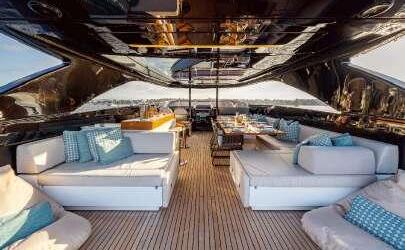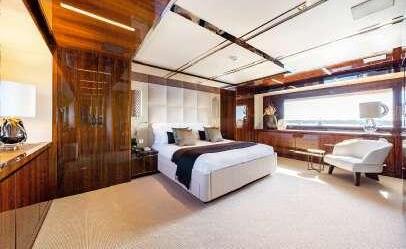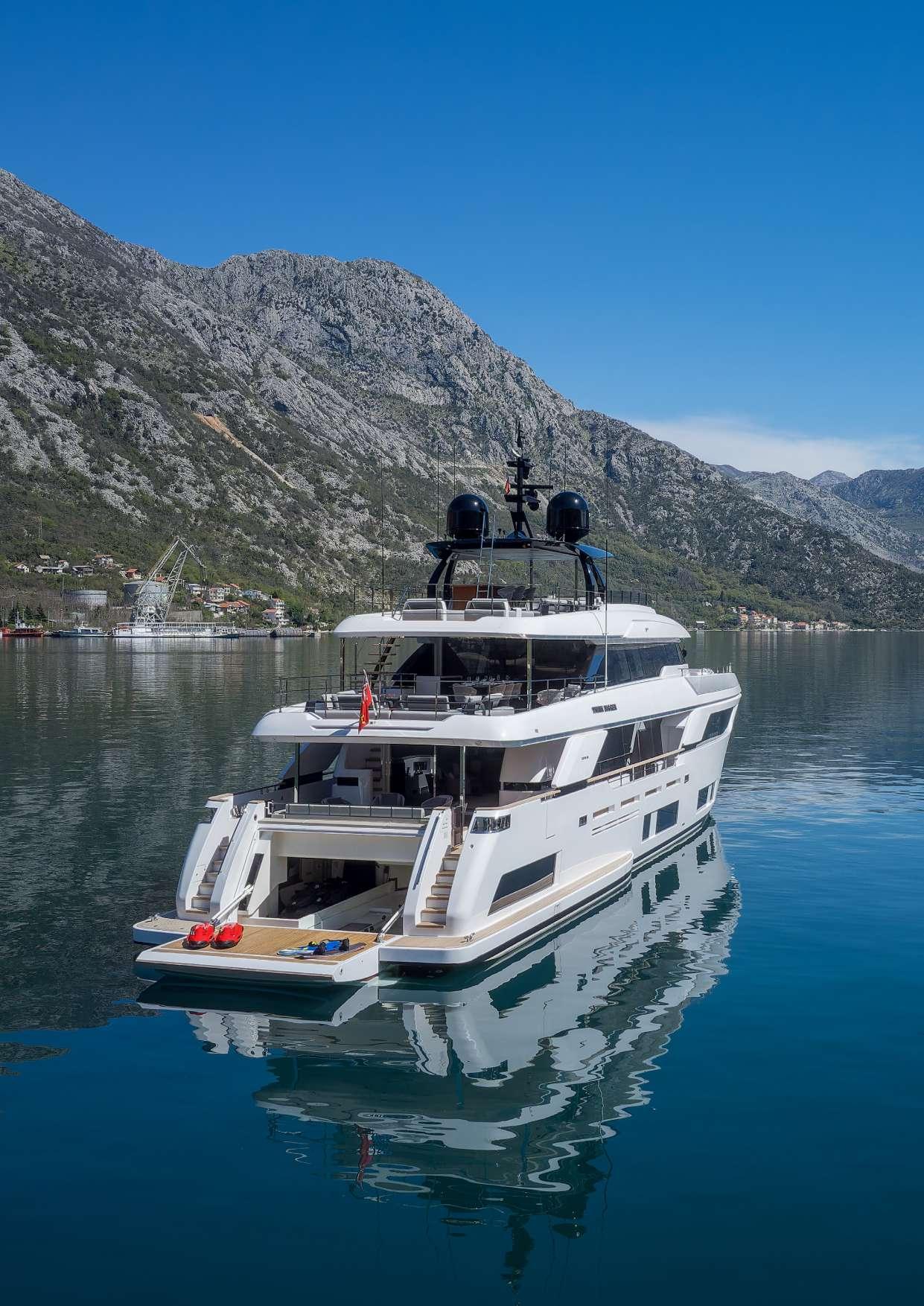
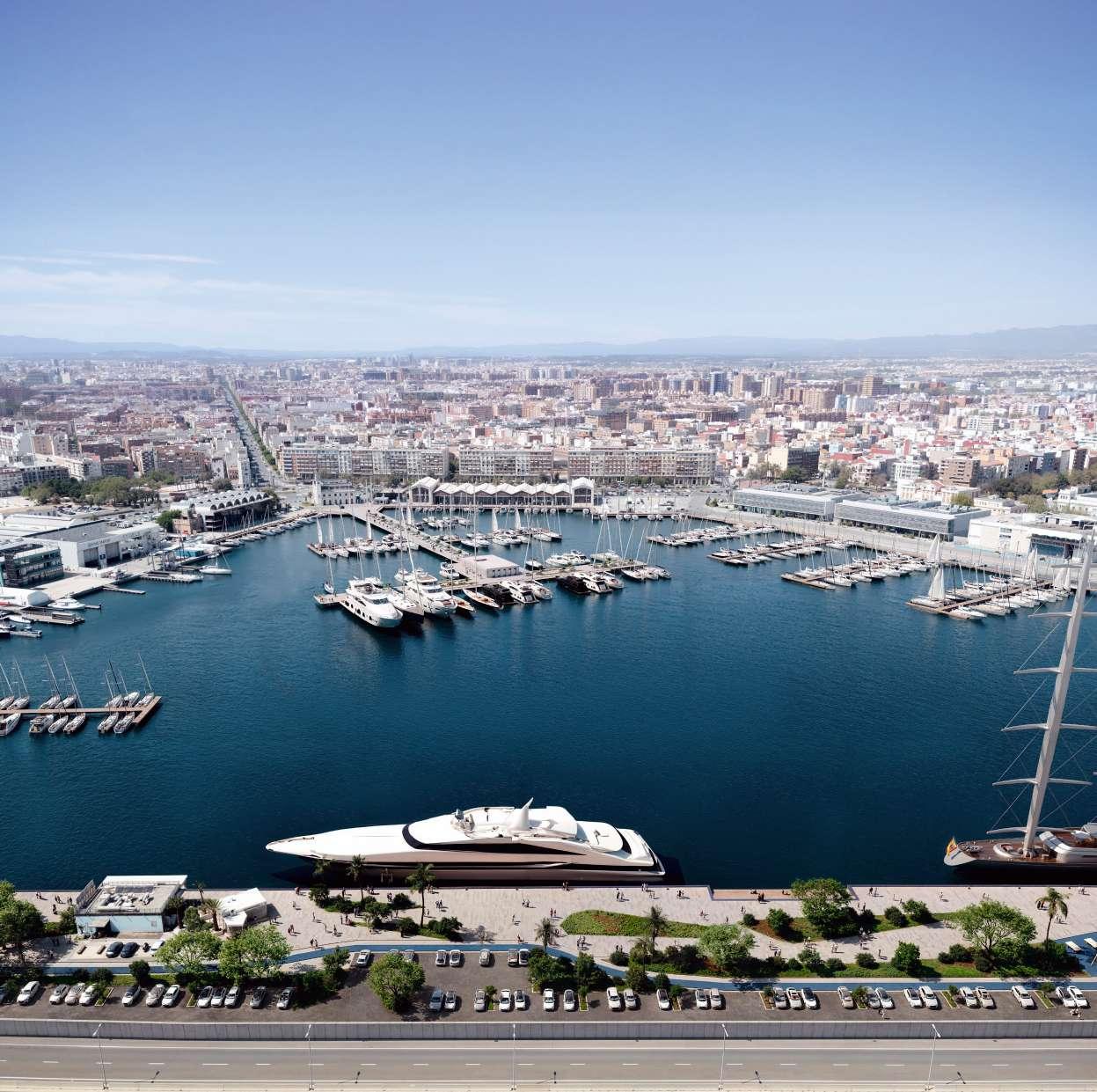
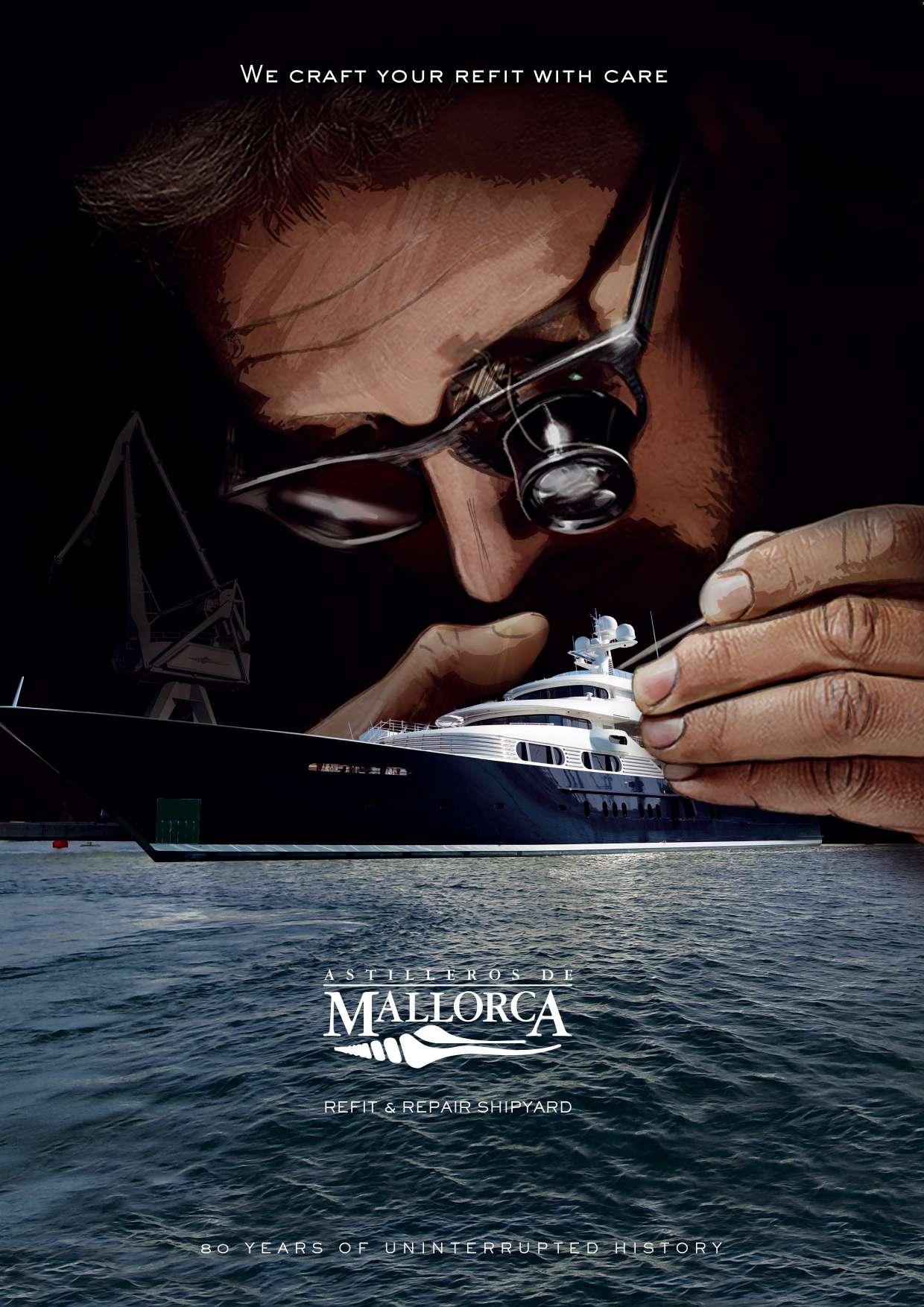

• Leisure,
Check

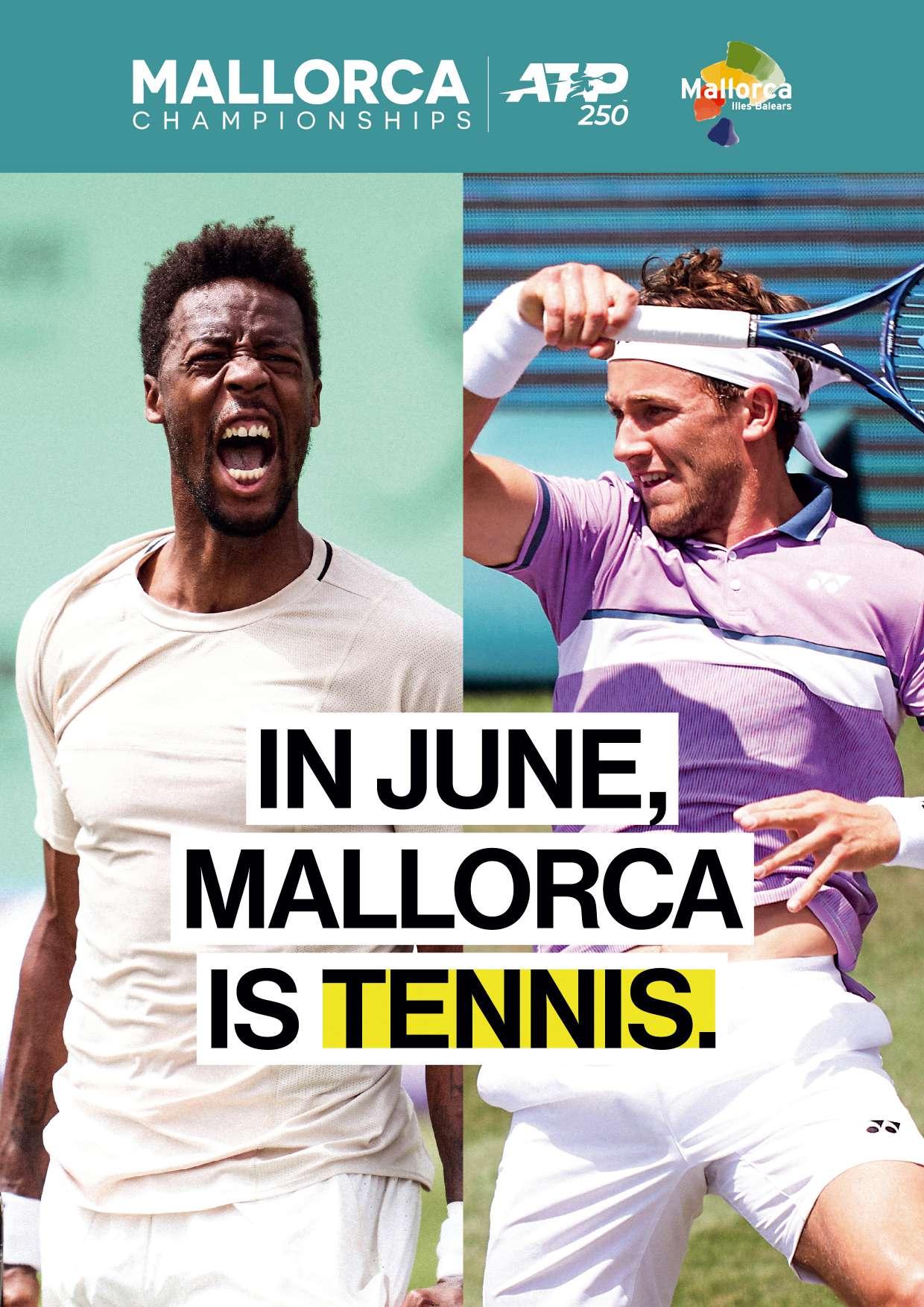






• Leisure,
Check



CEO (Creative Enthusiastic Owner) Jens Oomes
Design Rex4media
Accounts & Admin Marlot Cathalina
Office Manager Natalie Tempelers
Editor Jens Oomes
Contributors
Melanie Winters
Marlot Cathalina
Hamish Goddard
Karine Rayson
Clair Minto
Barry D’Arcy
Ricardo Sagarminaga
Amanda Hewson
Dominique Smit
Tzarina Mace-Ralph
Chef Raffie
Mia Naprta
Sales: sara@theislander.online
Editorial contributions & press releases: editor@theislander.online
*Creative Enthusiastic Owner
Last April marked The Islander's 28 years of existence. As any business owner will know, it's nice to be a well established entity but by no means does that allow for complacency. With the wonderful team I have around me, we are constantly brainstorming about potential improvements for our advertisers and readers.
It fills me with pride when we receive feedback from readers that they see The Island "everywhere". In sales presentations, one has to be brief and to the point but claiming to be "everywhere" challenges your credibility. To be more precise, The Islander can be found in +100 pick up points on Mallorca, in all superyacht marinas of Menorca, Ibiza and the peninsula. Additionally we are in the Antibes International Yacht Club on the exclusive Billionaires’ Quay, also in the Capitainerie of Port Vauban and in a dozen businesses frequented by yachties in Antibes. More recently we have received the request from our advertiser Gruppo Cappuccino, to have The Islander displayed in all their Cappuccino and affiliated locations -such as the Lobster Club- all over Spain as well as in the prestigious resort of Gstaad.
Online our website provides an immediate impression of whatever is new. When our readers have to be informed of time sensitive info, we don't have to wait for our next beautiful printed issue to come out but publish it immediately online. All our articles are shared on Instagram and Facebook and in our very popular email newsletter, making sure our readers don't miss out on anything our contributors and advertisers have to share.
The reward for us is an ever growing audience that far transcends the shores of our island with a large following in Germany, Sweden, the UK and US where Mallorca is trending for all the right reasons. Another reward is, of course, our growing group of advertisers who understand they are building trust with a
discerning and affluent audience by being repeatedly seen and telling their story in our beautiful publication.
So as you can see, we're all about taking action. So here's my call to action to you:
1. If you're interested in advertising in The Islander, reach out to sara@theislander.online to learn about the various possibilities we have on offer.
2. If you don't find The Islander in your favourite spot that is relevant to our readership, send me a Whatsapp.
As Einstein said: "Life is like a bicycle, to keep your balance you have to keep moving forward!"
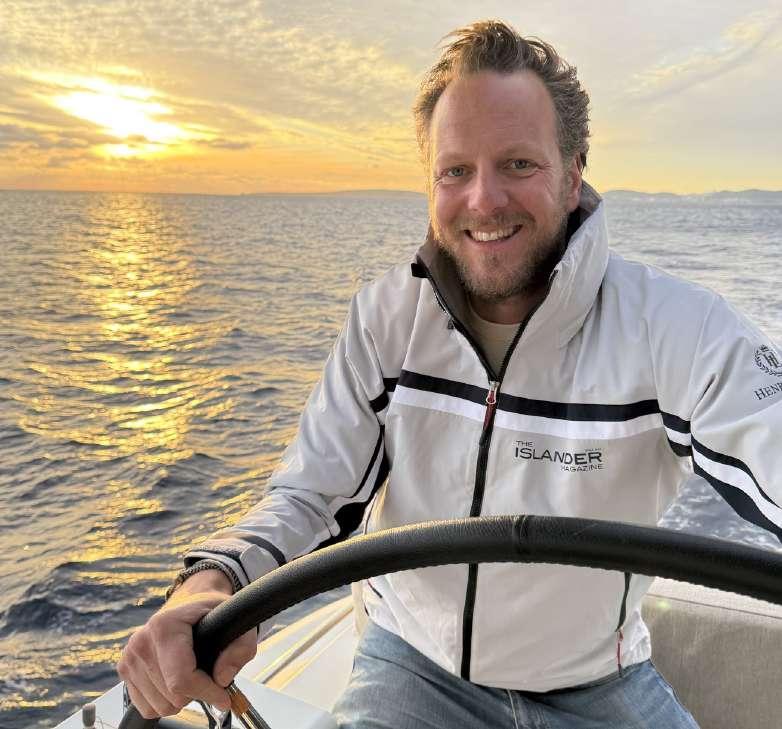




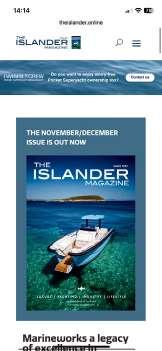





7. Note from the CEO 12. INIP reports 14. Judged by the cover
20. Better connectivity on board with Starlink, 4G5G & beyond
24. Novelties at Palma International Boat Show 2025
28. M/Y Special One, special from every angle
34. Industry Updates
46. The excellence of natural cork for your boat Seacork Deck Made in France
54. Chef's chat: Naike Diaz
56. Meet the crew: Thomas Bevan – Sole Engineer
60. Crew Coach: A guide for superyacht crew on monitoring mental health and staying strong in tough conditions
62. Ship to shore: Max Jäger
66. Bio-preserved flowers onboard: a stew’s best friend?
68. Inside ACREW’s chef competition A day of culinary excellence in Palma
70. Performing CPR on a guest at sea
72. Toftevaag’s journey to Ithaca: The northern odyssey
74. FarSounder’s new whale spotting and safe vessel operations class
78. Essential tips for reviewing a Seafarer’s Employment Agreement (SEA) –Minimum Leave Entitlement (Part 1 of 6)
80. Discover the Balearics with Evolution Yacht Agents
82. Wanted: Chef. Also Known As Miracle Worker, Martyr & Mind Reader
84. TOIO: Italian innovation for superyacht and sailing apparel
86. Chef Tzarina spits it out!
92 . The ship’s journal from the delivery from Mallorca to Fiji
96. From jaguar conservation to island stewardship
100. Assessing the threat of a tropical worm to the Balearic ecosystem
104. The Community Vessel: a gamechanger for marine regeneration and education in the Balearic Sea
108. JoyRon Foundation information and update.
110. Phillip Seippel, avid sailor, successful businessman and true Mallorca Islander reflects on his 60 years cruising, racing and living in Mallorca.
112. 5 beaches on Mallorca’s east coast that are worth every step
114. Why sleep is important to be a good diver
118. Gulf of Thailand's Ocean Marina Jomtien awarded 1st global accreditation
120. Brokerage
With a large portion of The Islander team being Flemish and Dutch speaking it is inevitable that the word "gezellig" would be used to describe the Islander Network and Inspiration Parties. The word itself can't be directly translated to English as it encompasses a plethora of sentiments such as cosy, close, gregarious, homey, intimate, social, convivial, companionable, snug and fun-loving. It can be used to give value to, or describe, a certain atmosphere or sentiment.
This value can be shared by a group, whether you’re Dutch, Flemish, or come from any of the diverse backgrounds Mallorca is lucky to accommodate: everyone is acknowledging (and contributing to) the feeling of 'gezelligheid'.
Make sure you don't miss the next gezellige INIPs on the 1st of May and the 2nd of June. In July and August we take a summer break, and in September we'll be back with a renewed concept. Watch this space! ◆




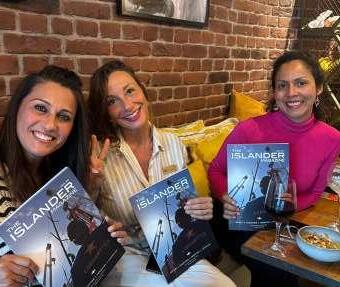
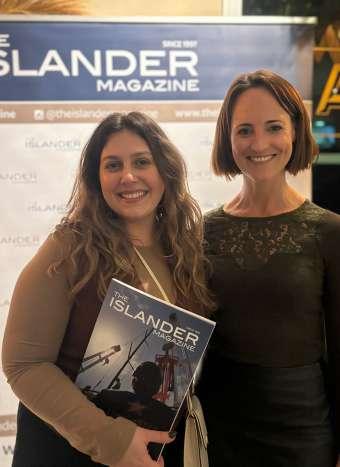
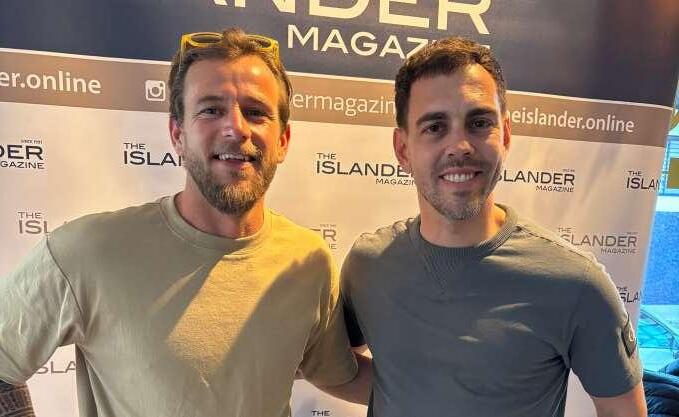



Written & photos by Arrival Yachts

They say that success can come from being in the right place at the right time, but sometimes it can also come from being in the right place at the wrong time.
Arrival Yacht's founder always knew he would always go into business which is why his final year study for his Naval Architecture degree was on Sponsorship in Sailing. After an exciting false start in Andalucía where a family business quickly grew to 2 offices and 10 staff, selling over 50 new and second hand boats a year, the realisation of not making any profit brought that venture to a close - heartbreaking after 5 years of working 7 days a week!
Mallorca was the obvious move and after 7 years of working for a family friend and learning brokerage and new boat sales of up to 40 metres, the dream began to take shape and Arrival Yachts was founded in early 2008. What came next of course was several years of incredible hardship for the marine industry as with other sectors and the company only survived thanks to almighty hard work, efficiency, integrity and low overheads!
Today 17 years on Arrival Yachts is one of the few genuine boutique yacht brokerages and members of MYBA, that offer a first-class global service, highly personalized to their clients’ requirements. Each experienced member has a wide knowledge base,
working as a dynamic team and creating solutions for the tasks at hand.
Having sold a lot of serious motor and sailing yachts, working with most of the other big name brokerages and law firms, Arrival Yachts has earned the trust of their owners. The business probably passed a tipping point in about 2016 and today Arrival Yachts core business of 20 to 45 metres vessels is being re-written as they are working on larger sizes for select long term clients.
From the office in Puerto Portals, Marta Stefaniak is the office manager accompanied by brokers Alex Bonet Smart and Joan Binimelis.
Marta Stefaniak: From Poland, Marta holds a degree in Tourism and Management from the University of Poznań. Her love of exploring and unforgettable experiences, led her to Mallorca, fulfilling a lifelong dream.
With over 8 years at Arrival Yachts, Marta has refined a deep understanding of this dynamic industry, specializing in yacht sales and client services. Off the water, she practices yoga being a certified instructor, the balance and mindfulness integrated into her approach to work and life. Whether reading, hiking the mountains of Mallorca, or travelling to exotic destinations, she lives each day with curiosity and enthusiasm.
Fluent in Polish, English, and Spanish, and learning Catalan.
Alex Bonet Smart: Alex started his professional yachting career at 19 in Saint Maarten, as a deckhand on superyachts.
He developed a deep and lasting bond with the ocean and at only 21, he achieved his first skipper's position in Greece, marking the start of an extensive career commanding both motor and sailing yachts up to 85 feet. Alex has skippered six transatlantic crossings, including an 8,000-mile solo voyage aboard a classic 1967 29-foot cutter, and as professional crew delivering yachts to and from exotic locations, such as Svalbard in the Arctic. His extensive experience and resourcefulness have helped him manage refits, shipyard projects, and all aspects of vessel management.


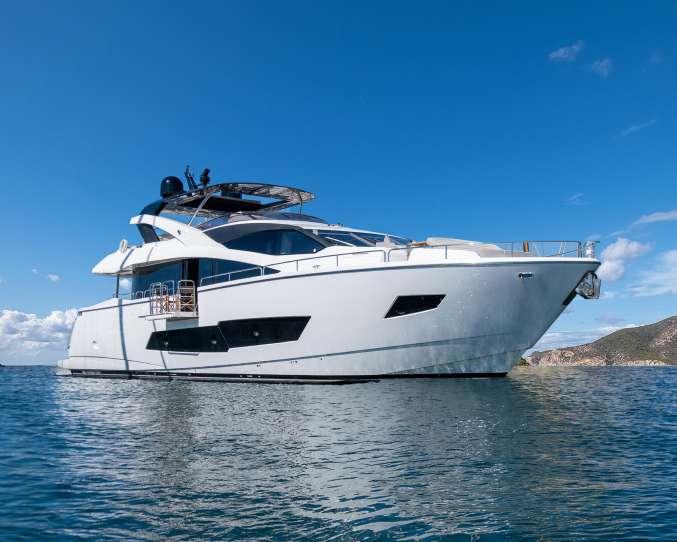

A young family led Alex to transition to a land-based role and the last three years establishing himself as a successful yacht broker. Specializing in both motor and sail yachts up to 100 feet, he has completed numerous sales and fostered strong client relationships. Alex is highly motivated and optimistic about continued growth and a promising career.
From an early age, Joan Binimelis has felt a deep connection to the sea—a passion inherited from his two grandfathers, both professional fishermen, who passed on their love for sailing and maritime life.
With the experience gained as a captain and his degree in Business Administration and Management, Joan has developed a comprehensive understanding of the yachting industry. His background allows him to navigate not only the technical aspects of the sector but also its legal and financial complexities, giving him a well-rounded perspective that adds value to every project he undertakes.
Passionate and dedicated, Joan has successfully turned his vocation into his profession, establishing himself as a key figure in the yachting industry. ◆

By





The Islander Magazine can be found in +100 pickup points in Mallorca and in all superyacht marinas of Spain. We are also represented in strategic points in the French Riviera such as at the exclusive Billionaire's Quay in the port of Antibes. And you can also find us in all Cappuccino’s in Spain and Gstaad.



20. Better connectivity on board with Starlink, 4G5G & beyond
24. Novelties at Palma International Boat Show 2025
28. M/Y Special One, special from every angle
34. Industry Updates
46. The excellence of natural cork for your boat Seacork Deck Made in France

Written by Hamish Goddard - e3

At the Palma International Boat Show e3 Systems will have our regular spot on the quay within the Palma Superyacht Village. PIBS has become one of Europe’s most important superyacht shows and enjoys its status as the starting gun for the Med season, the Easter weekend just a few days before.
e3 Systems has teamed up with our friends at Astilleros de Mallorca and Miller Marine to host a charity ride for Captains and crew in aid of Superyacht Charities - a lovely initiative that makes an additional contribution to the magnificent work they do. It’ll be a nice way to arrive at the show via the mountains of west Mallorca. When people ask what I do for a living when not on my bike - and I reply that we provide connectivity solutions for Superyachts - the inevitable questions move typically towards
Starlink, its impact as great now as it was when it arrived on the market a few years ago, when e3 Systems became an authorised reseller and added it to our list of managed and supported services that we provide to the superyacht sector.
Whilst Starlink is, of course, the primary connectivity source for most yachts’ connectivity requirements both inshore and offshore, significant changes to its airtime structure have greatly affected many vessels plans for the forthcoming 2025 summer season, particularly when it comes to inshore coverage.
In addition to a new $150 network access fee, chargeable each month for Global Priority connectivity, the biggest impact has been the removal of free of charge and unlimited inshore ‘Mobile Data’, once Global Priority (connectivity
everywhere that Starlink itself is authorised – and both inshore and offshore) has been consumed.
This change has very much brought 4G5G options back into the fold for 2025, with 4G5G in some cases - particularly regionally - being considerably less expensive. So, it’s become a balancing act between the two main sources of connectivity, although everyone should remember that in spite of these changes, bandwidth at sea has never been as reliable, fast or cheap as it is now.
In addition, Starlink have recently added the Starlink Mini to their range of antennas that can access Global Priority services, for which e3 Systems are also an authorised reseller, albeit with several important restrictions that need to be understood. Please come by our stand at the show or get in touch to discuss what these are, but it’s safe to say that whilst Starlink launched with a relatively simple range of packages and hardware to access the network, these get more complicated by the day. It was always likely to happen... Look at any online forum and you will see a host of complaints –again from those that have never had it so good, but got used to it pretty quickly!
The other key difference between the Starlink HP (High Performance) antenna and the Starlink Mini is in the
performance of the antenna itself, capable of significantly slower download speeds than its HP big brother, but an ideal solution for <30m local vessels staying in the same region, particularly areas where 4G5G network coverage is notoriously bad - think Ibiza, Formentera and the north coast of Mallorca, which it solves at a stroke, with download speeds being comparable with a good 4G5G set up.
Finally, there is the question of what vessels do that rely solely on Starlink – and who may have Turkey on their cruising agenda during 2025 – a region where Starlink is not authorised and will essentially switch itself off as soon as you arrive into Turkish waters.
Our e3 Big Data Europe card is valid in Turkey and can either be used on a Pay As You Go basis at 1,95 € per GB if you are planning to be there briefly, or as a No Limits option at 795 € per GB for 1.2 TB if planning to stay longer– considerably cheaper than Starlink – with the option of additional data at just 0,95 € per GB. It is also a monthly contract with free of charge suspension and reactivation when required – so brings with it maximum flexibility.
This highlights further that a good contemporary 4G5G set up remains crucially important itself, as is the IT network on board – which is often the bottleneck that limits the user


experience in these days of the super-fast bandwidth speeds that are now commonly available. Upgrading IT networks has been a busy task for us during this last refit season precisely for this reason – an often-inexpensive process with a great return.
Finally, many vessels are not completely comfortable having all their eggs in Elon’s basket and the additional costs for 2025 may not be the end of it. However, viable options also exist in the LEO connectivity sphere with the commercial launch of the OneWeb network on either Kymeta or Intellian antenna hardware – seen as a useful alternative or back-up to Starlink as a primary source but also offering a much more


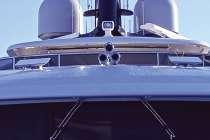




comparable service to Starlink than conventional VSAT ever has in the areas where Starlink remains inaccessible.
We will have all these options on display at PIBS and would be delighted to see you there. You will find us on the diagonal row of exhibitors towards the swing bridge beyond Moll Vell; Stand Number SY23. ◆
Enjoy the show and wishing you all a wonderful 2025 summer season!
Hamish.Goddard@e3s.com / www.e3s.com
+34 971 404 208 / +34 686 634 038


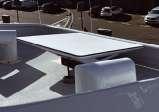

• Stock available in yachting locations: Mallorca, Barcelona, Antibes, Monaco, Fort Lauderdale
• Immediate delivery
• Installation, Integration and 24/7 support from Yacht experts
• Client portal for data monitoring and alerting
Connectivity on the move

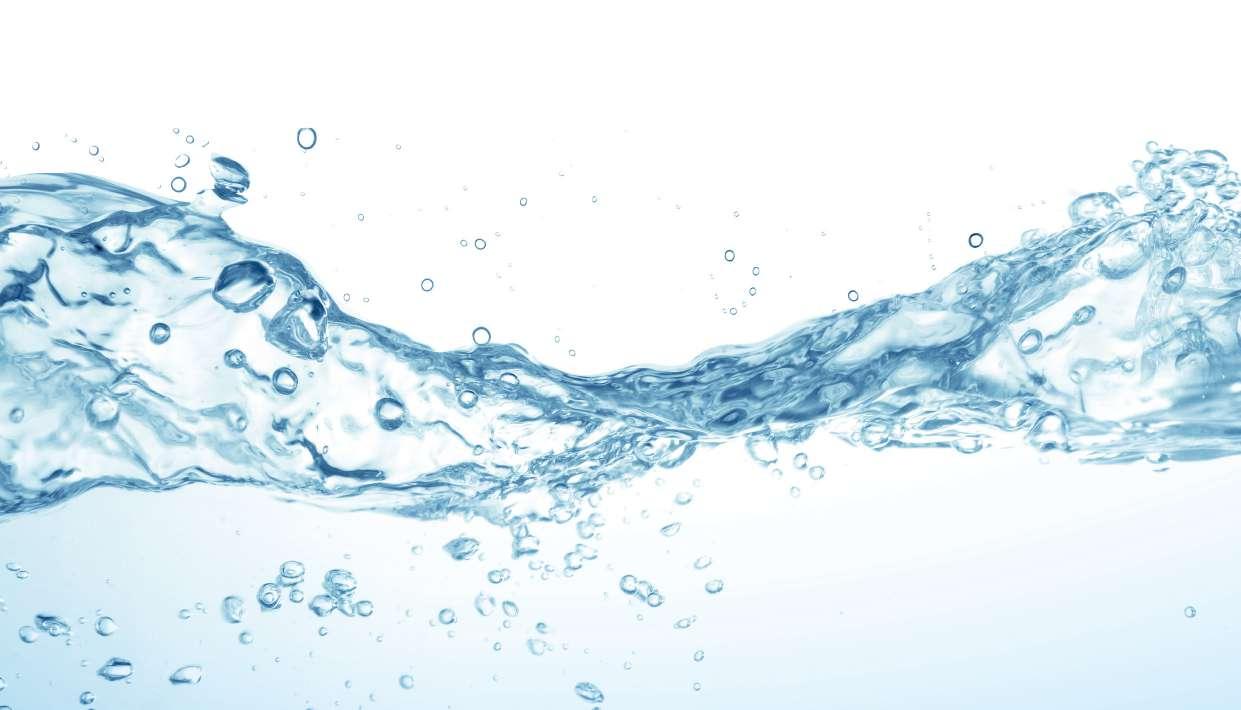


Written & photo credits by Mallorca Marine Group

UK boutique boatbuilder Pearl Yachts will unveil the new Pearl 63 as a world premiere. The Pearl 63 is a familyfriendly yacht—easy to operate, designed with space and amenities for everyone. Unique in the 60-foot category, it provides luxurious accommodation for up to eight guests across four elegantly appointed cabins. As the centrepiece of the display, the Pearl 63 will be showcased alongside the Pearl 72 and the Pearl 82. Pearl Yachts will be present at c/o Mallorca Marine Group - Stand D28, zone 4
Spanish boatbuilder Maxim Yachts will showcase the Max 43 Comfort at the Palma boat show, a 13-meter model from its line of fast day cruisers, designed by Alex Cherigny with engineering by Isonaval Technical Studio. The yacht can reach 45 knots, powered by a pair of 440-horsepower Volvo Penta engines.
The exterior spaces feature a versatile layout, while the helm station is equipped with two double seats and a refined carbon fiber console, fitted with the latest marine technologies. The kitchen includes a ceramic cooktop, sink, and two large refrigerators. Inside, the yacht offers a spacious double cabin accommodating up to four people, along with a full bathroom. With generous headroom, it boasts one of the tallest cabins in its segment. Maxim Yachts will be present at Stand Zone 1 – 404.
Apreamare returns to the Palma International Boat Show with Island Yachts Broker, the brand’s exclusive distributor for the Spanish market. The stand will feature a unit of the Gozzo 35, a model much appreciated by local customers that expresses Mediterranean tradition and style. Apreamare & Island Yachts Broker will attend Palma International Boat Show 2025 at stand M-05



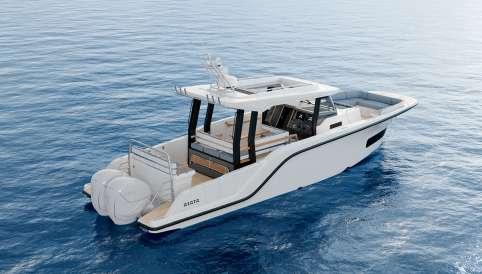

Aiata, a brand of the Anadolu Group, will debut its innovative Wayfinder 38 at the Palma International Boat Show in collaboration with Mallorca Marine Group. Known for its modular design and outstanding performance, Aiata will present the Wayfinder 38 in its Suntop configuration on the water for the first time. Designed by Jarkko Jämsén, the Wayfinder 38 offers unmatched flexibility with a pioneering modular system that allows owners to easily reconfigure the boat—even after purchase—for leisure, fishing, or cruising. With three configurations—Cabin, Suntop, and Fishing—the boat combines comfort, craftsmanship, and adaptability in one sleek package.
At the Palma International Boat Show, Azimut will showcase the Seadeck 6 and Seadeck 7, the two models currently available from the Series that represents the state of the art in sustainable innovation. Thanks to the integration of advanced naval architecture and the introduction of hybrid solutions, this Series allows environmentally conscious owners to reduce CO₂ emissions by up to 40% over the course of a year of average use. Also on display at the Palma International Boat Show will be the Grande 36M, Grande Trideck, and Fly 53. ◆
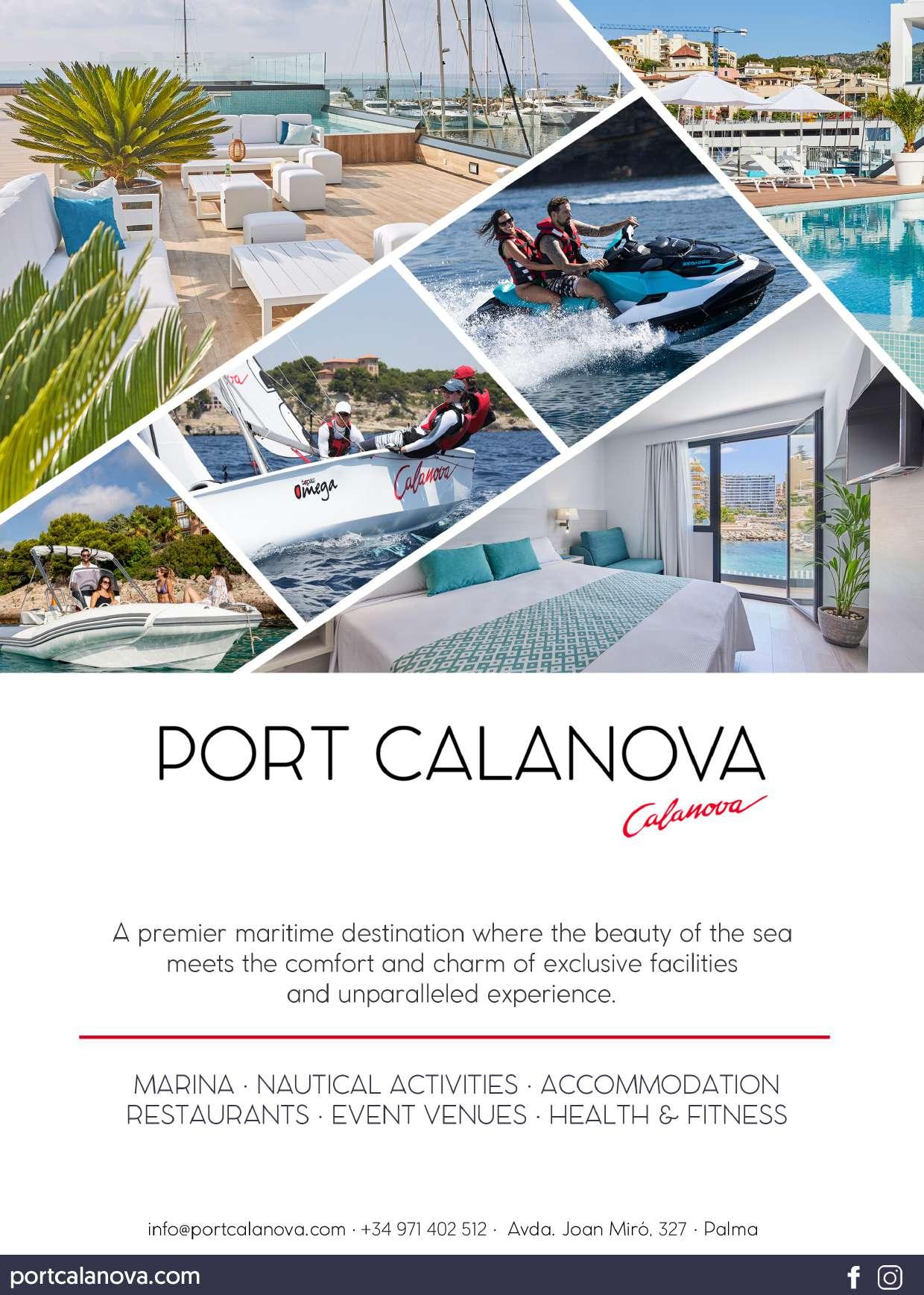




With our fixed sailing schedules and dedicated float-on/float-off yacht transport vessels, you can rest assured that your yacht is on time where it needs to be, which gives you the time to relax, enjoy, or reunite. We offer dedicated sailings to the most sought-after destinations and events.

Schedule 2025
APRIL | SEPT | OCT | NOV Palma Port Everglades
OCT Palma St. Thomas
NOV Palma Le Marin
MAY | SEPT | OCT Port Everglades Palma
MAY St. Thomas Palma
E dyt.spain@yacht-transport.com
T +34 871 201 696
WWW.YACHT-TRANSPORT.COM Explore all our sailings

Written by Royal Huisman

Making her debut at the 2024 Monaco Yacht Show, Royal Huisman’s Special One showed the world just how special she is. Her list of superlatives is long, but to take it from the top, at 52 meters / 171 feet, she’s the world’s largest true sport fisherman and powers out to fishing grounds at 30+ knots. She’s also a superyacht in every sense of the word with five staterooms for the owner’s party, including two stretching full beams. Beautiful walnut joinery, exotic stonework, and bespoke furnishings dominate the interior. She features a unique, three-person pneumatic glass-enclosed elevator, and showcases the first yacht installation of a commercial grade 3D sonar fish finder. Designed for multi-generational living, Special One has indoor social spaces on three decks including formal dining, and exterior living spaces on six. She sets a new benchmark in the world of big game fishing boats, and she does all this while staying below 500GT.
Meeting the owner’s brief
The owner’s goal for this yacht – his first custom order – was for the ultimate luxury sportfishing yacht. He is a passionate fisherman who loves spending family time on
the water. Now that his son and grandsons were taking fishing holidays with him, he had outgrown his US-built Viking 92 sportfish. While giving up nothing in terms of fishability or the speed at which he could access fishing grounds, he wanted to be able to accommodate the entire family on long expeditions, offering them a superyacht environment. His goal was to entertain larger numbers of people in comfort, especially for time aboard while the fishermen are not actually reeling in their catch. Because the yacht might be operating in remote locations while chasing large ocean-going fish, reliability was a top concern. He assembled a team that included Pascarelli Consulting as his representative, Bush & Noble for expertise on sportfishing equipment, and Hampshire Marine for technical expertise, as well as trusted crew members to develop specifications for a new build.
Two yards responded that it was, in their view, “impossible” to contain the conceptualized yacht within the specified 500GT; another declared it would have to be completely redrawn and re-engineered because the engine room was “impossible”. Someone commented that only a sailboat


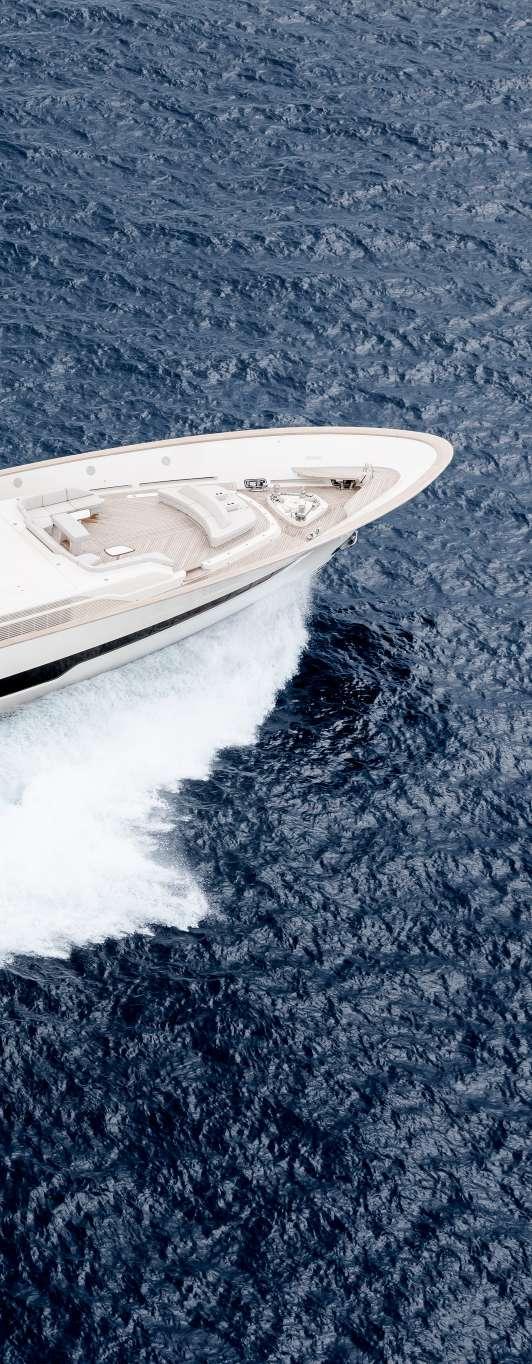
builder could build a yacht that dense and technically complex within a challenging weight budget. Sportfishing yachts have extremely fine entries and pronounced shapes in their forward sections, not unlike sailing yachts. For sailing yacht builders, working in tight spaces with a constant eye on weights and balances is all in a day’s work.
The owner’s team’s next inquiry was to Royal Huisman, a shipyard with an impressive heritage. Its reputation is largely built on a superlative portfolio of unique and tailor-made aluminum sailing yachts, at least 30 of which measure beyond 40 meters / 130 feet. Known for its ability to tackle complex and innovative projects and those pushing boundaries of traditional yacht design, Royal Huisman was then nearing completion of the extraordinary 58.5m / 192 ft motor yacht Phi, the longest motoryacht below 500GT. That yacht, too, was a project many said could not be built.
As cutting edge a project as Special One was for Royal Huisman, she brings the shipyard full circle to its roots. Building boats for local fishermen was the core business of Royal Huisman for decades after the shipyard was founded in 1884. Similarly, Vripack’s heritage from its founding in 1961 began with designing a range of sportfishing yachts and fishing boats. Thus, a shared Dutch background and a joint drive for innovation became an unspoken foundation for this project.
“While others said, “impossible,” we never say no,” said CEO Jan Timmerman. “Instead, we are happy to take on challenges, embrace innovation and ensure every project we engineer and build is tailored to the highest standards and as unique as every client. We were honest with the client that we had never built a yacht like this before, but we were certain that we could. With each project we sign, we begin by mapping the core competencies required and where we may need to add strength. Then we assess where we can find those skills or abilities in people we hire or in companies we partner with.”
Jan Timmerman continues: At Royal Huisman, our heart is still firmly in the sailing world. However, moving forward, we welcome more creative challenges, continuing to redefine possibilities in custom motor yacht building. I’m predicting that every now and then there will come along a special motor yacht project, perhaps one that others say is impossible."
The owner says that building his first full-custom superyacht “has been a dream come true. To have shared every step of that experience with my family has made it even more memorable. The admiration from the docks that we received everywhere is quite unique, underlining that Special One is a worthy icon”. ◆

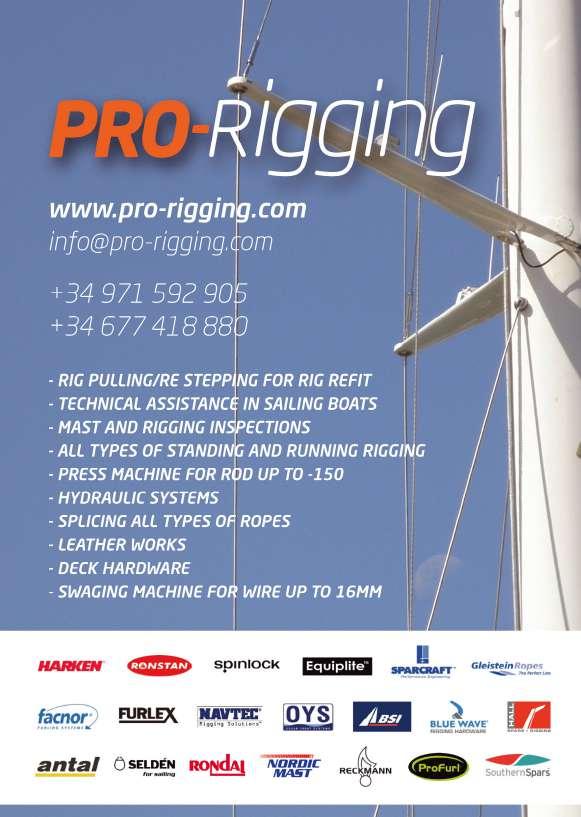
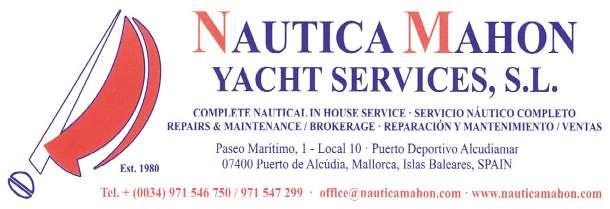




Marina Port Ibiza, operated by the IPM-IMG Marine Group, has renewed its concession to manage the berths at the Poniente dock in the Port of Ibiza for at least four more years. This renewal reinforces the marina's role in supporting sustainable yachting and enhancing Ibiza’s appeal as a premier nautical destination.
Under the renewed agreement, the concession-holder will invest nearly EUR 3 million annually to manage 94 berths. Of these, 82 are for vessels under 15 metres, while 12 accommodate superyachts ranging from 25 to 60 metres. The concession also includes over 80 square metres of facilities, including a warehouse, harbourmaster’s office, and marina administration space.
Ideally situated at the foot of Ibiza Town, Marina Port Ibiza is known for its eco-conscious operations and high-quality services. Its central location provides guests immediate access to the island’s vibrant lifestyle, including restaurants, nightlife, and cultural attractions.
The marina offers premium amenities such as 24-hour security, high-speed Wi-Fi, a professional dockside team,

and a dedicated concierge service. Environmental care is also a priority, with selective waste collection, recycling systems, and sustainable practices aimed at preserving the island’s natural environment.
This renewed concession confirms IPM-IMG Marine Group’s ongoing dedication to developing the yachting industry in the Balearic Islands. With operations secured for the coming years, Marina Port Ibiza strengthens its status as a benchmark in the Mediterranean, contributing to both environmental stewardship and regional economic growth.
YYachts develops a new Y6 - Perfect privacy
Bill Tripp designs the 64-footer for owners who want to remain completely private on board.

Founded in 2015, German shipyard YYachts has quickly established itself as a standout in modern yacht building. With successful models such as the Y7, Y8, Y9, and a custom division, the Y7—known for being easily handled by a small crew—has become the bestseller, with over 20 units delivered worldwide. In total, almost 50 YYachts have been sold globally.
Now, YYachts takes its next bold step with the introduction of the Y6—the shipyard’s first model designed for fully single-handed sailing. Created in collaboration with American designer Bill Tripp, the 64-footer completes the
YYachts portfolio at the entry level. “For many owners, the true luxury is sailing without a crew,” says Managing Director Tijl Hetterschijt. “The Y6 offers maximum privacy while staying true to our principle: Simplified to perfection.”
Constructed in carbon epoxy for high strength, low weight, and a clean, odor-free interior, the Y6 is a refined world cruiser that can be operated entirely from the cockpit. A racing package optimized for ORC rules also makes the Y6 attractive for competitive sailors.
Below deck, owners can choose from several layouts—three or four cabins, and multiple configurations for the master suite—offering the highest level of customization in its class.
Award-winning Danish designer David Thulstrup is behind the yacht’s interior aesthetic. Known for his holistic approach and modern Scandinavian style, Thulstrup brings elegance and function together. While the Y6 reflects his design vision, it can be tailored to each owner’s taste.
The first two units of the Y6 will launch in spring 2026. More details will be revealed at the Palma International Boat Show starting April 30.
Stay tuned. ◆
www.yyachts.de
Currently under construction by Mylius Yachts in collaboration with renowned designer Shaun Carkeek, the M72 is a high-performance cruiser that merges racing pedigree with luxury and comfort. Created for sailors who seek both speed and the pleasures of cruising, the M72 is an uncompromising blend of power, style, and personalization.
Built entirely in carbon fibre at the Piacenza shipyard in Italy, the M72 boasts a sleek, aggressive profile with an inverted bow, minimalist deckhouse, and flush deck. Designed for top-tier regattas, it features dual rudders, a lifting keel, water ballast, and a powerful sail plan with a 29.9m high-modulus carbon mast, carbon boom and bowsprit.
Despite its race-ready DNA, the M72 doesn’t compromise on comfort. The interior, designed by Studio Parisotto+Formenton, offers a refined and spacious layout: three ensuite cabins, a full galley, a generous saloon, and a study. Smooth, curved surfaces and premium materials echo the yacht’s elegant, modern spirit. Owners can tailor the interiors to their exact preferences.

The multifunctional deck maximizes crew efficiency while remaining guest-friendly. The open cockpit, retractable bimini, ergonomic seating, and large sunbathing area make it equally ideal for relaxed cruising. All deck hardware is flush and positioned for optimal functionality.
Backed by cutting-edge engineering and 3D design tools, the M72 integrates advanced electronics, telemetry, and a PLC-controlled 1,000L ballast transfer system—delivering a seamless, high-tech sailing experience.
The M72 redefines the 70-foot category: a true racer with the soul of a cruiser. ◆
www.mylius.it
Numarine launches new 47MXP Mediterranean Explorer

Numarine has unveiled its latest flagship, the 47MXP –short for “Mediterranean Explorer.” This all-new model blends long-range exploration with the beach-club lifestyle typical of Mediterranean yachting.
Built with a steel hull and aluminum superstructure, the 47MXP features a gross tonnage of 498 GT across four expansive decks. With a length of 46.7 metres and a beam of 9.25 metres, the yacht offers impressive space and comfort for extended journeys. It also delivers serious cruising credentials, with a range of 6,000 nautical miles at 9 knots.
A major highlight of the 47MXP is its redesigned aft and beach club area, featuring balconies, a lounge zone, and two pools – one aft, the other in the bow.
These open-air spaces bring guests closer to the water and create a resort-like atmosphere on board.
“The 47MXP represents a new chapter in our vision of blending adventure with luxury,” said Numarine Chairman Ömer Malaz. “We’re not building on spec, but client interest is already strong.”
The interior, crafted by Italian studio Hot Lab (part of the Viken Group), reflects a warm, sophisticated style. Up to six guest cabins, including a full-beam owner’s suite with private terrace, ensure maximum comfort and privacy. Generous social areas and a vast sundeck with bar and lounge seating make it ideal for both relaxation and entertaining.
Powered by twin MAN 1,450 hp engines, the yacht reaches a top speed of 16 knots and cruises efficiently at 12 knots. Whether exploring remote waters or anchored in a quiet bay, the 47MXP offers an immersive and elegant yachting experience.
With its bold design, range, and refined spaces, the 47MXP sets a new standard for luxury exploration ◆
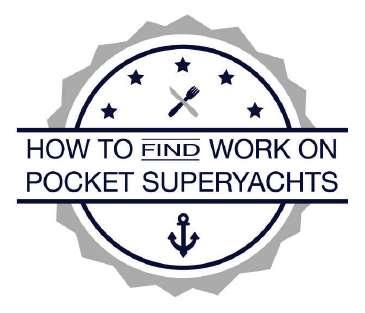



https://wops.teachable.com/p/how-to-work-on-pocket-superyachts

Palma Superyacht Cup out of Club de Mar on 25 - 28 June
With a new venue, new entries and new racing classes, the Superyacht Cup Palma 2025 is on course for a spectacular 29th edition from 25-28 June.
Europe's longest running superyacht regatta will be relocating to the prestigious and innovative Club de MarMallorca in the heart of Palma, a move that will bring together the yachts, owners and crews immediately alongside the vibrant SYC Race Village, the heart of the event's social and networking scene.
The new venue, along with the prospect of new racing classes, has seen a surge of interest in joining the action out on the Bay of Palma.
"We are always looking for new ways to improve and enhance the Superyacht Cup Palma experience for owners, skippers and partners, and a base in the new-look recently developed Club de Mar-Mallorca does just that," said Event Director Kate Branagh.
“Having the opportunity to host all the superyachts racing at our event on the dock together at the heart of Palma is what the Superyacht Cup is all about and interest from competitors is at an all-time high.”
SYC's new Venue Partner the Club de Mar-Mallorca was founded over half a century ago in 1972, and is renowned for facilities and services aligned with the needs of larger sailing yachts. It is currently in the fifth year of a 360º improvement scheme which has already delivered modern, sophisticated and sustainable upgrades to both the dock and clubhouse. The opportunity to again be able to bring all the yachts, owners and crews together, stern-to at the Race Village, has no doubt played its part in the exciting level of interest from both new entries as well as seasoned veterans of the Superyacht Cup Palma.
One direct result is that 2025 looks set to see a brandnew class for the increasingly high-profile Baltic 68 Café Racers. The creation of Mallorcan designer Javier Juadenes, the striking 20.7m sloops are already making a name for themselves on the racing circuit, with both Ganesha and Open Season likely SYC contenders in June.
In addition, Hoek Design entries may also get their own class, with both the 42m Vijonara and 38.7m Atalante looking set to make a welcome return to SYC after racing last year, plus new launch Linnea Aurora, who recently joined the Truly Classic 128 line-up.
Others from 2024 possibly returning are the 39m Tripp design Cervo, and the 24m Farr designed Wally Yacht Rose
— with the two-time back-to-back champion having the
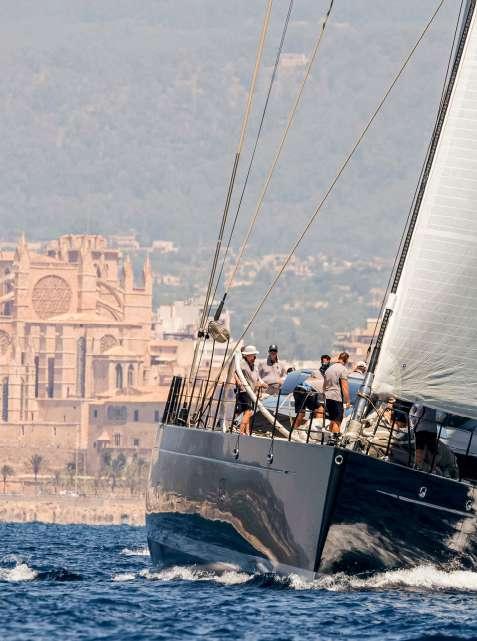
unique chance to make it three-in-a-row, an SYC first.
However, she will face determined if friendly competition from several in the fleet, not least from the fellow Farr Yacht Design and SYC first-timer Gelliceaux.
"The Gelliceaux owner, crew, and I are all looking forward to making the yacht's debut at the Superyacht Cup Palma this summer — it is a favourite in the superyachting world and a fantastic racing location with an equally friendly social scene which sounds like it will be enhanced this year with all the boats being moored together at the new Club de MarMallorca venue. We can’t wait!" said Clive Walker, captain of the Southern Wind 108 which has already shown its potential with overall victory at the 2024 St Barth Bucket.
With the 2025 Notice of Race (https://www. thesuperyachtcup.com/en/official-noticeboard) published and official entries open, the Superyacht Cup Palma organisers are looking forward to joining forces with the Club de Mar-Mallorca.
Event Director Kate Branagh added: "At the same time we remain indebted to our long-standing partners including St. Regis Mardavall Mallorca, Pendennis, Marinepool, North Sails, Pantaenius, RSB Rigging Solutions and, of course, the Real Club Náutico de Palma for their world-class race management expertise." ◆
https://www.thesuperyachtcup.com/en/home
D Marin Spain SA wins the tender to manage the moorings at Marina Cuarentena in the Port of Palma
Primarily intended for chartering, the concession will incorporate significant environmental improvements. The Board of Directors of the Port Authority of the Balearic Islands selected the company D Marin Spain SA to manage the moorings at the Marina Cuarentena.
The concession includes sustainability measures such as the installation of solar pergolas with an annual generation capacity of 162,000 kWh, which will cover 20% of energy demand. Systems will also be implemented to reduce water and electricity consumption, as well as improve marine biodiversity through the detection and elimination of pollutants.
The new concession will also include an auxiliary floating dock reserved for service vessels, such as those used for

cleaning the water surface, surveillance, and support to crew members, without commercial operation.
The concession is granted for a period of six years, with an estimated investment of one million euros (VAT included). The annual occupancy rate amounts to more than 350,000 euros (excluding VAT), plus the 4% activity fee.
Source: Ports De Balears ◆
Ocibar acquires stake in Marina d’Arechi
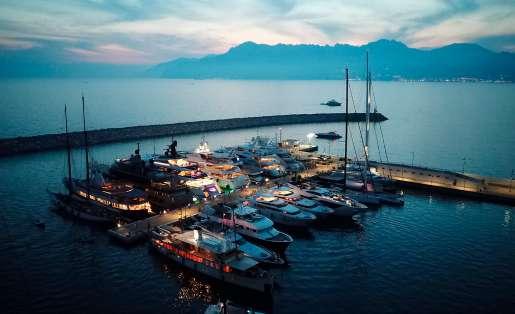
Salerno, April 4, 2025 – Ocibar, a leading Mallorcan company specializing in marina and shipyard management for over 35 years, has acquired a 25% stake in Marina d’Arechi in Salerno, Italy. The remaining 75% remains with the Gallozzi Group, which has operated the marina since its inception. This marks Ocibar’s first investment outside Spain and reinforces its strategic expansion across the Mediterranean. With 950 berths for vessels ranging from 10 to 100 meters, Marina d’Arechi is located at the gateway to the Amalfi Coast, just 25 miles from Capri. The marina offers year-round services and is one of Italy’s largest and best-located ports.
Ocibar CEO Antonio Zaforteza expressed enthusiasm for the partnership, stating, “Marina d’Arechi
represents a Mediterranean success story with enormous potential. We are excited to integrate it into our network and continue building a unique value proposition for our clients.”
Ocibar operates marinas in Port Tarraco (Tarragona), Port Adriano (Mallorca), Botafoc Ibiza, Marina Santa Eulalia (Ibiza), Marina Port Valencia, and now Marina d’Arechi. With more than 3,500 moorings, over 55,000 m² of commercial space, and 34,000 m² of dry dock facilities, Ocibar is known for its commitment to excellence, sustainability, and top-tier service.
Agostino Gallozzi, CEO of both the Gallozzi Group and Marina d’Arechi, welcomed the alliance: “We’re pleased to welcome Ocibar as a partner who shares our values and vision. This agreement marks the beginning of an exciting new phase for the marina.”
As part of this next chapter, Marina d’Arechi plans major infrastructure upgrades, including an increase in mooring capacity and improved facilities to cater to yachts of all sizes. A hotel development is also in the works, supporting Salerno’s efforts to attract high-end tourism.
With the recent opening of Salerno Costa d’Amalfi Airport—offering private flight services and international connections—Marina d’Arechi is ideally positioned as a luxury gateway to one of the most beautiful coastlines in the world. ◆
www.marinadarechi.com www.ocibar.com
Further growth and investment expands BMComposites' design and engineering services
Following a significant investment in technology, equipment, and an increase in personnel, BMComposites is pleased to announce the introduction of on-site 3D scanning and enhanced design services.
The company’s newly acquired 3D scanning tools enable the capture of data over large, complex areas with a high level of accuracy. BMComposites looks forward to applying this technology to a broader range of projects, including the design of new parts for superyacht refits and support in yacht surveys.
“This investment allows us to work with much greater speed and accuracy; it has revolutionised the way we operate,” said Mark Branagh, Managing Director. “We can now redesign, reverse engineer, fit, or build just about anything with total precision and without revisiting the vessel, giving us confidence in first-time fitting—whatever the task. For larger refits, the real benefit lies in our ability to collaborate and share accurate information with multiple international parties. We can exchange files in various formats, from dimensionally accurate photographs to full 3D models, across any platform. In an industry where deadlines and expectations are high, this is a total gamechanger in terms of efficiency.”

BMComposites’ continued investment in design and engineering has increased year on year and consistently proven its value through improved efficiency, professionalism, and clearer communication of design intent to partners and clients. The company now offers a complete design package that extends beyond composites. Its five-strong design team also delivers high-quality 3D rendering, structural engineering, geometry verification, and finite element analysis. ◆
To learn more about BMComposites' structural design services for new builds and refit projects go to www.bmcomposites.com
5 yacht types, 121 solid and metallic color shades, and endless color combinations for hull, superstructure, and bootstripe – that’s our digital ALEXSEAL color configurator. The perfect tool to choose your favorite color shades.
From now on, there are many chances for a first impression of your new yacht’s surface. Scan the QR code to explore the color configurator →
instagram.com/alexsealpaint linkedin.com/company/alexseal-yacht-coatings








360⁰ virtual Palma International Boat Show, online from May 5th. Supported by The Islander Magazine
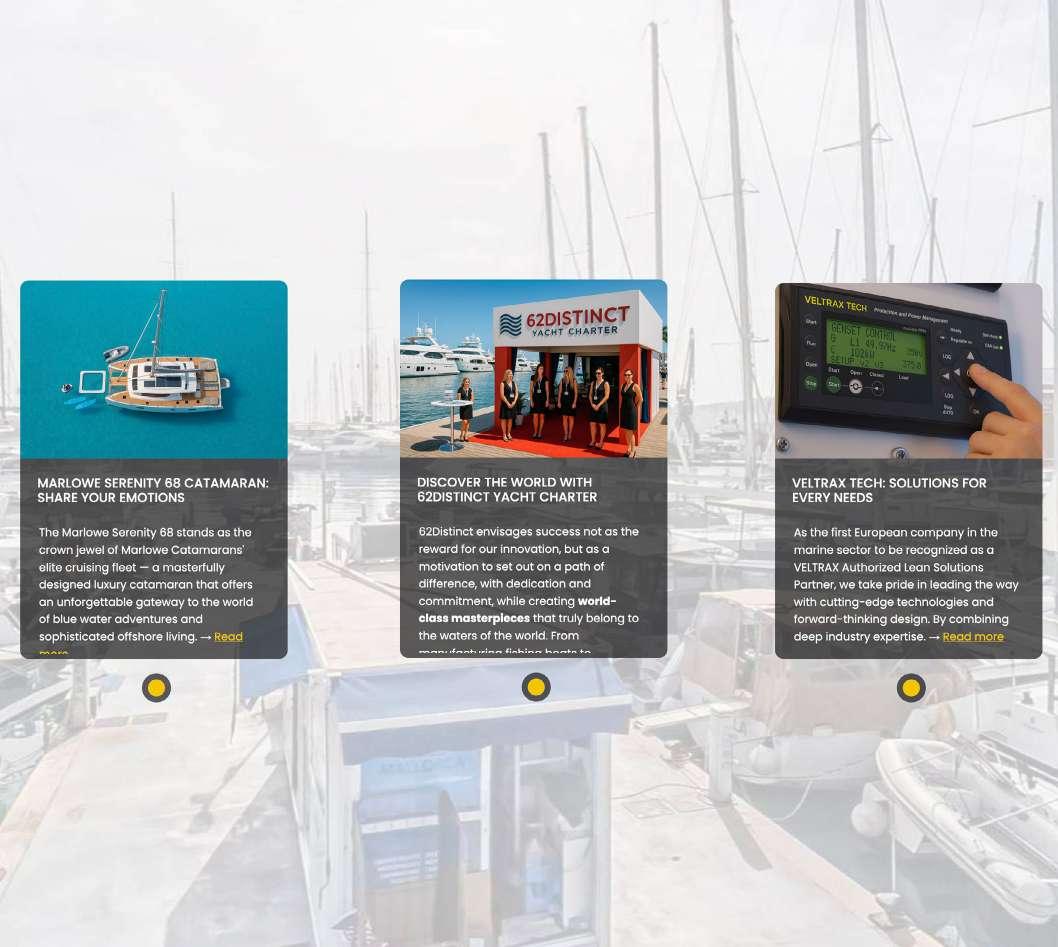
The Palma International Boat Show will transform into a fully immersive online Virtual Boat Show with exhibitor hotspots, a user-friendly navigation map, a location-sharing button and over 150 spherical panoramas at 6 meter height covering the entire show.
This innovative project realised by Virtual-Boat-Show.com will go online on Monday, May 5, shortly after the real-life event has been concluded.
It will allow access to the event for those who missed it and re-engage those who were there. Step into a next-level digital experience with over 200 highresolution 360° panoramas, showcasing the full scale and
elegance of the event from a bird’s-eye view. Effortlessly explore the show using an interactive map, discover exhibitor hotspots packed with product details, videos, and images, and share your favourite views with a single click.
Whether you're reliving your visit or seeing it for the first time, this virtual showcase brings Palma 2025 to a global audience like never before— live online right after the show.
More information: www.virtual-boat-show.com


• Friendly dynamic team
• Great with kids and nervous patients
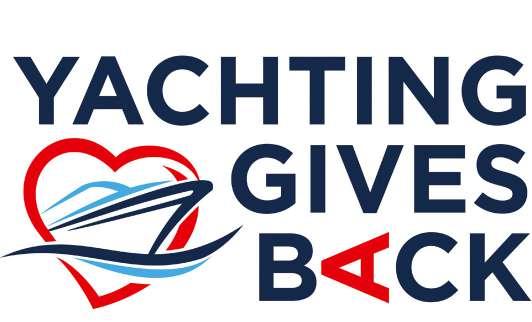

• Same day emergency appointments
• Cosmetic treatments including whitening
• Hygenist
• Dental Implants

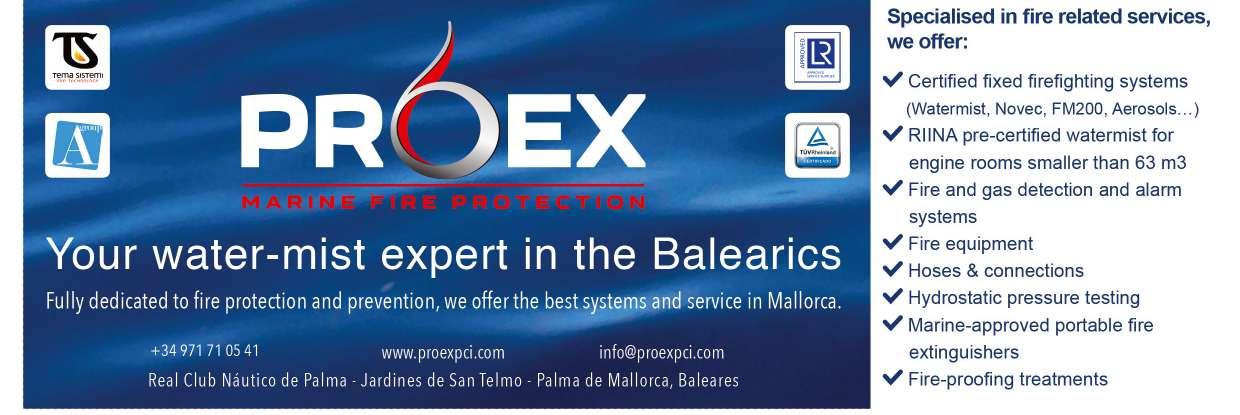


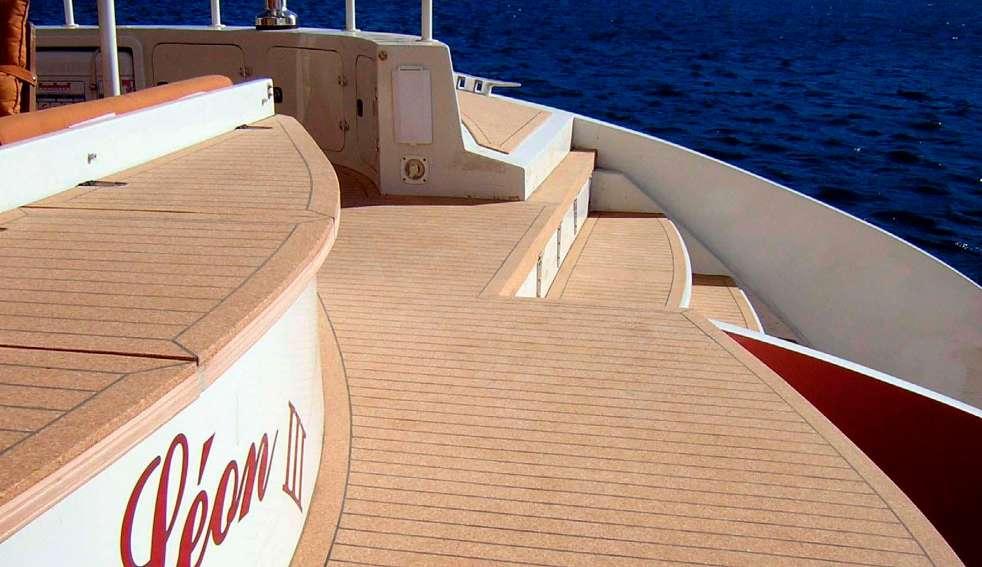
Looking for performance?
Choose Seacork Deck Original for its natural look and technical features.
Its lightness and natural insulating properties will enhance your boat's performance.
Seacork : 2 Decks with many advantages (benefits)
Durability:
Cork is resistant to extreme marine conditions. What's more, its easy care and maintenance means it lasts a long time.
Comfort:
Naturally non-slip and non-heat-accumulating, Seacork Deck guarantees optimum comfort underfoot. A thermal and sound insulator, it promises a more pleasant atmosphere on board.
Unique design:
Seacork Deck customization lets you add a touch of exclusivity that will enhance your boat.
Looking for elegance?
Choose Seacork Deck Plus for its refined look close to a wooden strips
Its warm tones and unique texture will complement the aesthetics of your boat.
Over 20 years of expertise to support your projects. ◆

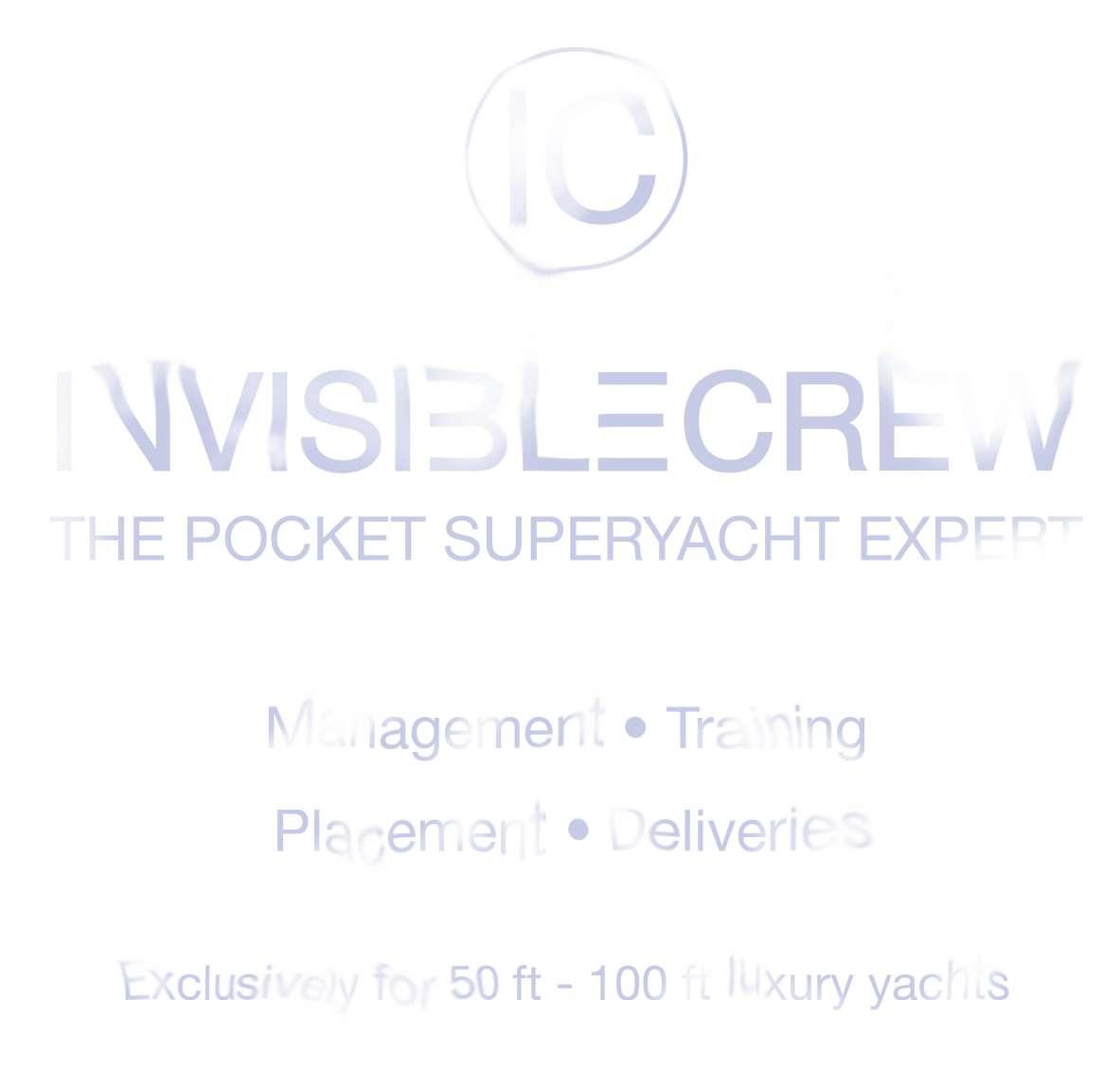
Perhaps you find this ad hard to read but it’s not even half as hard as finding suitable crew for 50-100 ft Pocket Superyachts. We know, because we have been focused on selecting and supporting crews for these yachts for 10 years now. For help with understanding this ad and running your Pocket Superyacht (as owner or crew) contact jens@invisiblecrew.com or find out more at www.invisiblecrew.com.














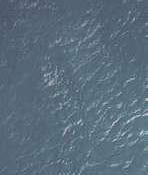

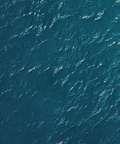
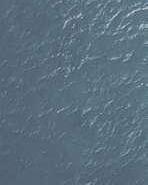

















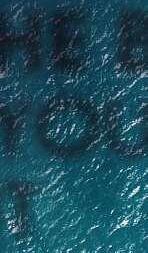




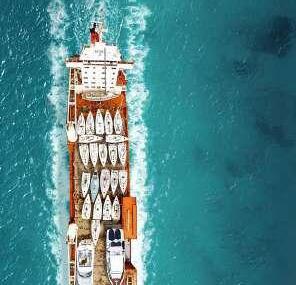



































































































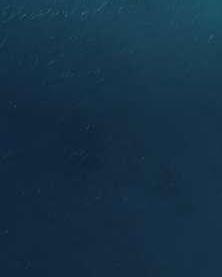







































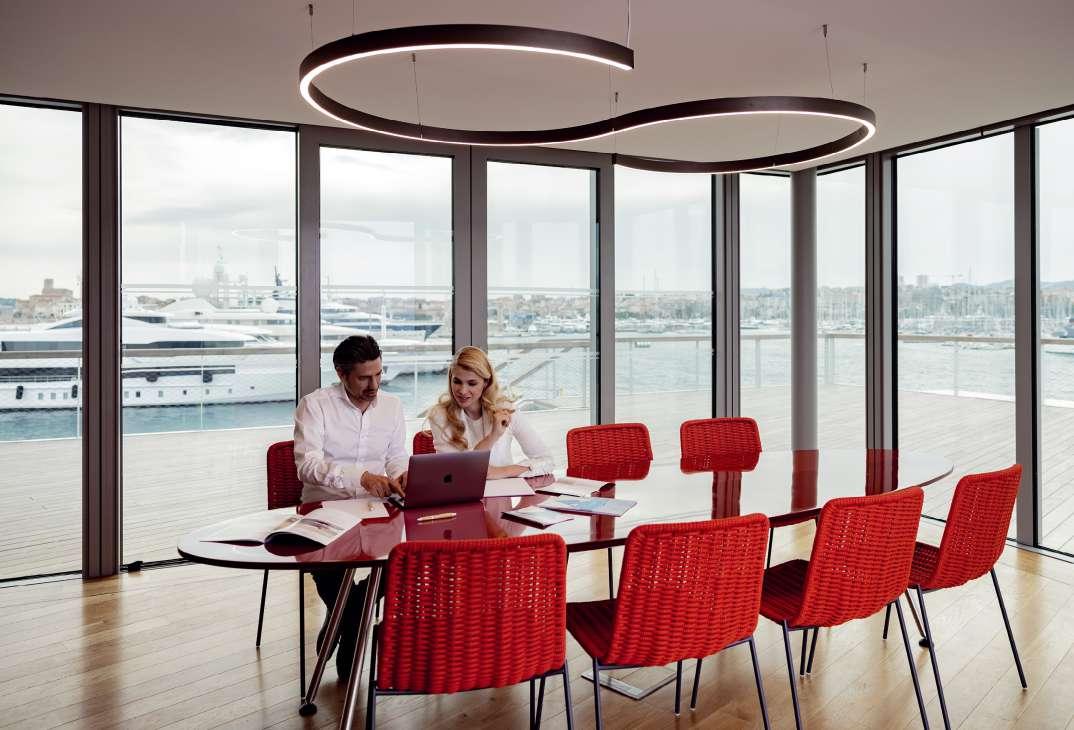


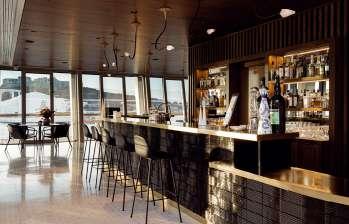
THE
Nestled in the heart of the French Riviera the International Yacht Club of Antibes welcomes its esteemed members in search of confidentiality and prestige in breathtaking settings.
54. Chef's chat: Naike Diaz
56. Meet the crew: Thomas Bevan – Sole Engineer
60. Crew Coach: A guide for superyacht crew on monitoring mental health and staying strong in tough conditions
62. Ship to shore: Max Jäger
66. Bio-preserved flowers onboard: a stew’s best friend?
68. Inside ACREW’s chef competitionA day of culinary excellence in Palma
70. Performing CPR on a guest at sea
72. Toftevaag’s journey to Ithaca: The northern odyssey
74. FarSounder’s new whale spotting and safe vessel operations class
78. Essential tips for reviewing a Seafarer’s Employment Agreement (SEA) – Minimum Leave Entitlement (Part 1 of 6)
80. Discover the Balearics with Evolution Yacht Agents
82. Wanted: Chef. Also Known As Miracle Worker, Martyr & Mind Reader
84. TOIO: Italian innovation for superyacht and sailing apparel
86. Chef Tzarina spits it out!

Interview by Barry D'Arcy of Ocean Earth Chefs
Naike Diaz is a seasoned chef with over 16 years’ experience and holds a bachelor's degree in Gastronomic Sciences. She is passionate about culinary innovation, and is always looking for creative improvement.
Where do you come from, and what is your age?
I'm 37 years old (but I feel younger), and I'm from Valencia, Spain. However, my family roots are in Córdoba, Andalucia.
What made you want to become a chef?
When I was young, my mother was blind, so I had to learn how to cook for my family. She taught me that the most important ingredient in any dish is love, and that lesson shaped the way I cook. My journey as a chef started when I began working in a restaurant in Valencia at 18 years old, washing dishes. I watched the chefs closely, eager to learn, but without experience, I could not step into the kitchen right away. Over time, I worked my way up from a dishwasher to a waitress, and finally, I earned my place as a chef and graduated in Gastronomy at the University of Valencia.
Where have you worked as a chef?
I started at 'Puerta del Mar' restaurant in Valencia, Spain, washing dishes and ended up managing three restaurants and a team of more than 20 people.
What was the most challenging place you have worked, and why?
The Puerta del Mar restaurant in Valencia was the first restaurant
I worked there. There are different dishes, and I learned every part of the menu (starters, main courses, desserts).
How would you describe your style of cooking?
My style of cooking comes from traditional cuisine and has a delicate, meticulous way that blends modern, healthy, nutritious cuisine with original ideas and intense flavours. I pay close attention to the details and make sure the highest quality is in every dish I prepare.
What do you like to cook?
I love cooking paellas and traditional dishes from different

cultures, but I also like exchanging knowledge and learning to cook new dishes.
Where do you get your ideas and inspiration for cooking?
Whenever I travel to new places, I explore their traditional cuisine and local restaurants This inspires me to learn new techniques and influence my cooking.
What is the most challenging thing about being a yacht chef?
Working on a yacht is a completely different environment from a restaurant. The cultural diversity, the different cuisines I had to adapt to, and the unique preferences of the yacht owners required me to expand my knowledge. The kitchen was much smaller than in a restaurant, with limited storage and organization was crucial. Additionally, provisioning had to be planned carefully to ensure we had everything needed for the remaining days at sea.
What is the best thing about being a yacht chef?
The best thing is that I meet different people from different countries. It's a multicultural environment, which opens my mind and makes me more aware of different cultures.
Chefs that inspire you and why?
The chefs who inspire me are ´the mums` because they cook

every day without rest. They give everything to their families and always make sure their loved ones are well-fed.
What is the best piece of advice given to you as a chef?
The best advice I have received is to adapt to the owner's culinary preferences without losing my own identity as a chef.
What keeps you going on the long days in the galley?
My passion for cooking and the satisfaction of creating dishes that bring joy to me and others keep me going. The excitement of working helps me stay motivated.
Has the way you cook changed over the years?
Yes, it has. My cooking has changed over the years because I have learned new techniques and discovered new dishes from different countries and cultures. This has helped me grow as a chef.

What are your best and worst moments as a chef?
My best moments as a chef are when I receive recognition and appreciation from clients for my work. The worst moments are dealing with the physical and mental fatigue from long working hours. Working on a yacht also means being away from my family, which can be difficult.
What are your favorite places to eat?
Nou Raco in Albufera, Valencia, is an emblematic and traditional spot. I also enjoy eating at my friend's houses, where we gather to eat traditional paella and enjoy time together.
How do you spend your time away from the galley? When working in a restaurant, I love spending time with my family and friends. When working on a yacht, I try to explore new places, learn about the local culture, and visit typical spots and restaurants. ◆
Written by Melanie Winters
credits: Tom Bevan
Life Below Deck with Tommi: A Journey from submarines to superyachts
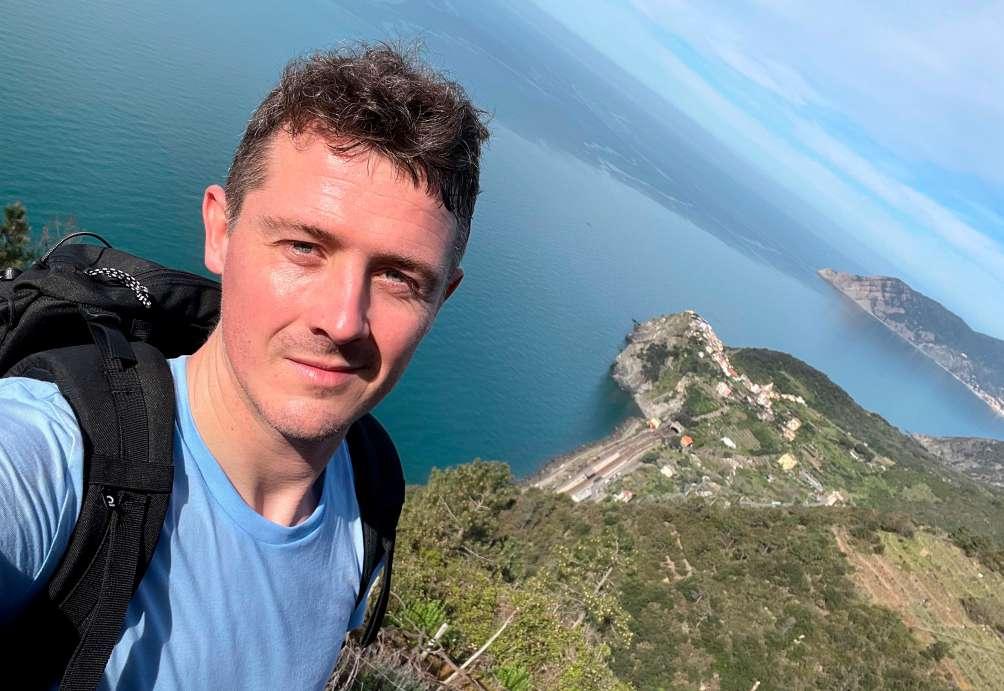
Meet Tommi, a 35-year-old engineer originally from Telford, UK, who now calls Palma de Mallorca home. With his best friend Tori and their three cats, Dora, JoJo, and Teddy. Tommi has embraced life both on land and sea and when he's not ensuring everything on board runs smoothly, you’ll find him hiking, cooking, gaming or restoring his beloved 1972 Mini, aptly named Murtle the Turtle!
His engineering journey started early, joining the Royal Navy Submarine Service at 17, where he undertook both mechanical and electrical apprenticeships. For over six and a half years, he worked on both the oldest and newest submarines, HMS Sceptre and HMS Astute. After leaving the Navy, he transitioned to railways, working as a technician and then later an engineering manager for the Metropolitan Line and Eurostar. By 2019, a restless urge for change led him to yachting, bringing with him a wealth of technical experience and a keen eye for problem-solving…(all will be revealed!)
The transition to yachting came a little unexpectedly. Bored with the railway industry, a Facebook post expressing his
frustrations caught the attention of a former Royal Navy colleague. A simple message, “Come to Palma, the industry is desperately short of engineers!” A lightbulb moment one could say and that was all it took. With the support of his then-husband, Ricky, Tommi packed a bag, boarded a flight and dove headfirst into a new career. Starting with Marlin Marine in Port Adriano, he quickly found his way onto a yacht through a crew agent. And the rest, as they say, is history!
Among the yachts he’s worked on, SY Blue Papillon holds a special place in his heart. It was here he experienced his first transatlantic crossing and Caribbean season. The guests were genuine and kind, the crew became lifelong friends and the boat itself, an impressive Royal Huisman, was every engineer’s dream. Going from an intense dual nine-month season straight into a ten-year survey, coupled with an extensive electrical refit, definitely kept Tommi on his toes. The challenge only fuelled his passion, shaping him into the very capable engineer he is today.
For Tommi, the best part of life on board is undoubtedly the crew camaraderie, the inside jokes, and the ability
to laugh even in the most chaotic situations. Having a professional chef on hand isn’t too bad either. But no matter how well a boat is prepared, the first day of a guest trip always brings the inevitable, something breaking, usually something critical to the guest experience. As an engineer, staying composed under pressure is key.
Sanity during long trips comes in the form of routine and morale boosters. For Tommi, maintenance work keeps him occupied but it’s the crew mess game nights and themed food days (hello, Taco Tuesdays!) that make all the difference. His strategy for spoiling guests? Simple, ensuring everything runs seamlessly. Engineering can be a thankless job at times, when things work, no one notices but the second something goes wrong, all eyes are on you.

Every engineer has their pet peeves and for Tommi, it’s an easy one: not pushing in cupboard and drawer locks. One missed lock and the crew mess could end up covered in cutlery, or worse, a whole snack cupboard’s worth of contents strewn across the passageway. And of course, there’s the occasional embarrassing moment. Dropping a feeler gauge into the main engine? Check. That sinking feeling in his stomach as he helplessly heard a ‘tink, tink, tink’ sound as it found its way into oblivion? Also, check! Hours of searching with a borescope (when his problem-solving skills were tested to their limits) when finally, it was retrieved. It’s a mistake he won’t be repeating!
When it comes to destinations, the British Virgin Islands and Greece are on the top of his list for their stunning scenery and crystal-clear waters. . There’s nothing quite like finishing up a long day’s work and diving straight into the ocean for a swim. But on the bucket list? The Pacific Islands, followed closely by the Northwest Passage and Scandinavia. The idea of exploring more remote and untouched parts of the world excites him, especially the challenge of navigating engineering projects in extreme conditions.
One of Tommi’s proudest career achievements was successfully navigating Blue Papillon through a ten-year survey and an extensive Huisfit electrical refit. The sheer scale of the project meant constant problem-solving, adapting to unforeseen issues, and working long hours.
Exhausting? Yes. Worth it? Absolutely. For those considering a career in yachting, Tommi offers one key piece of advice: if you want to progress in deck or engineering, keep meticulous track of your sea-time from the start. Gathering old testimonials can be a nightmare, especially if a new captain has taken over. And for aspiring engineers, he strongly recommends gaining commercial experience first—an engineering cadetship not only fast-tracks qualifications but often comes with the added bonus of paid training.
There’s also the importance of adaptability. Yachting can be unpredictable, plans change, boats move, and challenges arise at a moment’s notice. The best engineers are those who stay calm under pressure and enjoy problem-solving on the

fly. And of course, resilience is key. Life at sea isn’t always glamorous, but those who thrive in this environment are the ones who find joy in the unexpected and embrace the adventure.
Looking ahead, Tommi’s plans include securing his engineering tickets, working towards Chief Engineer role on a 50-60m sailing yacht with a second engineer, and of course, continuing to travel. With South Africa on the cards this year and a European road trip planned with his Mini next year, one thing’s for sure, Tommi isn’t slowing down anytime soon.
As he puts it, “Keep doing what you’re doing. You’ve got an exceptional time ahead of you. Yeah, the punches will come but roll with them.” It’s advice he would give to his 20-yearold self and a philosophy that continues to drive him today. ◆


The world of superyachts may conjure images of glamour, luxury, and exotic destinations, but behind the scenes, the life of a superyacht crew member can be demanding and challenging. Long hours, high-pressure situations, and extended periods away from home can take a toll on mental health. This article will explore essential strategies for superyacht crew to monitor their mental well-being and maintain resilience, even in the toughest conditions.
1. Self-Awareness is Your Compass:
• Self-awareness is the first step in monitoring your mental health. Regularly check in with yourself to recognize the signs of stress, fatigue, or burnout. Understand that it's okay to feel overwhelmed at times, but it's essential to address these feelings. Captains and HoDs should have mental health awareness and first aid training to best protect the welfare of Crew.
2. Seek Professional Guidance:
• Superyacht crew members should have access to mental health support services. If you find yourself struggling with persistent mental health issues, don't hesitate to reach out to a mental health professional who understands the unique challenges of your profession. The Crew Coach offers a counselling service, as does Yacht Crew Help.
3. Crew Camaraderie:
• Your fellow crew members can be your greatest allies. Foster a supportive and empathetic community onboard. Share your thoughts and feelings with trusted colleagues who understand the unique demands of life at sea. Unhelpful phrases include: toughen up, get over it, if you can’t cope, leave.
4. Stress Management Skills:
• Develop effective stress management techniques that work for you. Explore mindfulness, yoga, or relaxation exercises. These practices can help you stay grounded and reduce stress.
5. Prioritise Physical Health:
• A sound mind requires a healthy body. Prioritise physical health through regular exercise, a balanced diet, and adequate sleep. These practices can bolster your mental resilience. I know that it is common for the designated hours of rest not to be adhered to. Heads of Departments and Captains should do their best to preserve the well-being of crew as much as possible.
6. Communication is Key:
• Honest communication is crucial onboard. You will only see honest communication and crew asking for help if there is psychological safety. If your leaders say they have an open-door policy and no one approaches them with their concerns, that is a notable red flag. Role modelling vulnerability and encouraging open dialogue will make crew feel more comfortable to do the same.
7. Set Boundaries:
• Striking a balance between work and personal life is challenging on a superyacht. However, set boundaries to protect your personal time and mental well-being. Overcommitting can lead to exhaustion.
8. Self-Care Rituals:
• Integrate self-care into your routine. Whether it's a quiet moment with a book, time spent gazing at the open sea or going to the gym. Self-care is essential for mental renewal.
In the dynamic world of superyachts, staying strong in tough conditions requires a blend of self-awareness, resilience, and support. By implementing these strategies and fostering a culture of mental well-being onboard, you can navigate the challenges of the high seas while safeguarding your mental health. Remember that seeking help when needed is a sign of strength, and it's your compass to smoother sailing ahead. If you want to equip yourself with the tools to manage mental health concerns effectively, head over to www.thecrewcoach.com

Karine Rayson The Crew Coach

Written by Melanie Winters
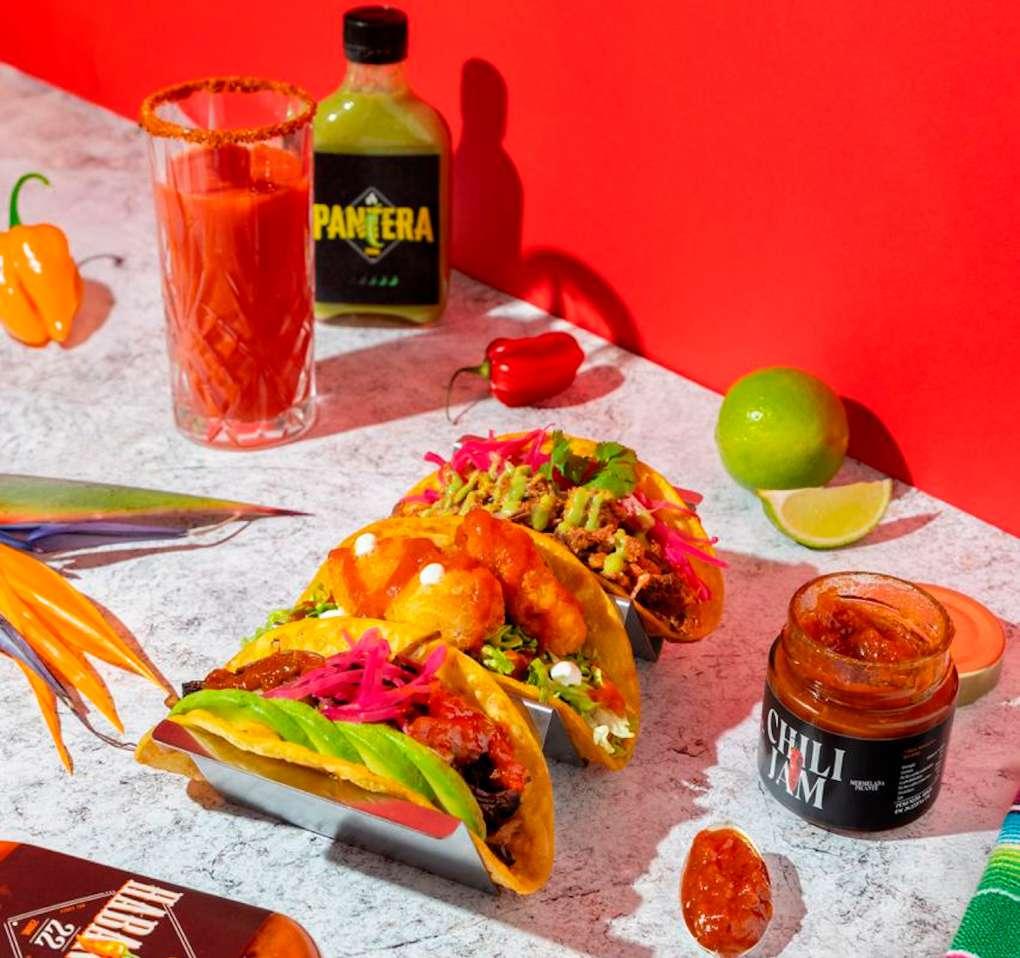
From the high-pressure galley of luxury yachts to the spice-infused world of artisanal chili sauces, Max Jäger’s journey is a testament to following passion, embracing change, and finding fulfilment in new ventures. Whether at sea or on land, his dedication to food, quality and bringing people together remains at the heart of everything he does.
Max Jäger is a name well-known in Palma’s culinary circles, but his journey started far from the bustling yachting hub. At 33 years old, Max has already lived a life packed with adventure, incredible experiences and a deep passion for food
that has shaped his career both at sea and on land. From an early start in tourism school to years spent as a sought-after yacht chef, he has now transitioned to an exciting land-based business, one that stays true to his love of food while giving him the balance he craved.
Growing up in Austria, Max attended a tourism school in Neusiedl am See, where his love for food began to take shape. His career path, however, wasn’t immediately clear. After working in restaurants for a while, he realized that the traditional hospitality industry wasn’t the right fit for him.
Just as he was preparing to attend university and change professions entirely, fate intervened! A family friend introduced him to the world of yachting and in a stroke of luck, he landed his first role cooking for one of Germany’s wealthiest individuals over New Year’s in Switzerland.
That opportunity quickly led to an invitation to join the team on the owner’s yacht in Palma. It was a turning point for Max. The moment he stepped aboard, he knew this was the right move. The passion he had once feared was lost came flooding back and from that moment, there was no looking back for Max!
“I immediately realized that this was the right way,” Max recalls. “My passion was reignited and for me, there was no going back.”
A career at sea: the highs and lows Max’s yachting career spanned nearly 14 years, starting at age 19 and continuing until he was 33. Over the years, he honed his craft aboard some of the industry’s most prestigious vessels. His first job was as a sole chef on a 37m motor yacht, where he worked for four summers and some winters before moving on to larger and more demanding roles.
He spent time as a sous chef aboard the iconic sailing yacht Eos before taking on the sole chef position on SY Bayesian, where he stayed for nearly two years. Following a few freelance gigs, he spent six consecutive summers aboard MY Cheetah Moon, cementing his reputation as a skilled and reliable chef in the industry.
The highlights of his career were numerous. He thrived under the responsibility that came with running an entire department, relishing the chance to deliver unforgettable dining experiences for both guests and crew.
“To walk out after a massive meal, see the smiles of people who are used to eating in some of the best restaurants in the world, and receive genuine appreciation, it’s something that drove me for a long time and still brings a smile to my face,” Max says.
One of the greatest perks of yachting, he adds, was the incredible sense of community. The friendships forged during long crossings, tough charters and celebratory crew nights out created lifelong bonds. Arriving in Antigua at 22 years old for his first Atlantic crossing, Max remembers the initial nervousness of stepping into the unknown, only to find a network of familiar faces and a warm, welcoming yachting family.
However, the yachting lifestyle wasn’t without its challenges. The biggest struggle for Max was missing out on life’s most important moments such as family gatherings, weddings, birthdays and milestones that he knew he would never get back. “Working on a boat in the middle of nowhere

can feel extremely isolating,” he admits. “Sitting on the bridge during a crossing, staring out into the dark, makes you reflect on your life on a different level.”
Making the move to land
After more than a decade at sea, Max began to feel a shift. Over the last few years of his yachting career, he found himself increasingly drawn to the idea of stability. While he still loved certain aspects of the job, the pressure of delivering exceptional food every single day, with no room for error, began to weigh on him.
“The pressure at some point became too much for me to still enjoy the process,” he explains. “I felt trapped in a lifestyle that ultimately wouldn’t lead to a happy life later on.”
He knew he wanted to stay connected to food but in a way that would allow him to create something sustainable—something that didn’t require the same high-pressure, ‘à la minute’ cooking of a yacht chef. He wanted to build a business where he could harness his skills to produce something consistent and high-quality while gaining back a sense of balance in his personal life.
Another major factor in his decision was the strain of long separations on his relationships. “Being away for such long stretches at a time just started to get to me too much,” he admits. “I know there are many people who are able to maintain private lives through rotational jobs or a better balance, but I am just not one of them.”


Max’s transition to land led him to create Habanera Chili, a business specializing in handcrafted chili sauces, jams, and spicy products made with locally sourced ingredients. Operating out of a friend’s kitchen in Porreres, Max has built the business from the ground up, supplying yachts, small shops around Palma and local weekly markets. He is also in the process of launching an online store to expand his reach. Everything about Habanera Chili is hands-on and personal. Max sources his ingredients locally, cooks everything himself, bottles the products by hand and even applies the labels himself.
“My products are 100% handmade, and I’m proud of that fact,” he says. “All the money I make with this project stays on the island as I only work with local small businesses.” His long-term vision is to grow all his own ingredients, ensuring that every product is sourced right from the island. He also plans to host more chili-themed events, following the success of a chili party he organized last year. “Bringing people together is one of my strengths,” he says. “To do so with spicy food and drinks is a recipe for success and fun for everyone involved.”
Although he has fully embraced his new life on land, there are aspects of yachting that Max still misses, especially the ease of financial stability and the unique access to some of the world’s most stunning destinations. “Getting used to no longer receiving steady and generous pay-checks was a big adjustment,” he says. “And, of course, I miss those incredible experiences. My days off in Antigua, exploring the Greek islands, dining out on the Amalfi Coast, and visiting hidden gems that only boats can reach.”
For those considering a transition to land, Max offers some valuable advice: “Enjoy the lifestyle while it lasts, but if you’re not planning on staying on boats forever, start saving money now. Or rather, yesterday. There are so many opportunities out there that are easier to grab if you have some savings on the side.” ◆
https://habanerasalsas.com
Written by by Clair Minto

As interior crew on luxury yachts we continuously seek ways to balance aesthetics, practicality, and sustainability. Bio-preserved flowers have emerged as an alternative to fresh blooms, these are real flowers that undergo a treatment process to maintain their appearance for months without the need for water or daily care. While bio-preserved floral arrangements offer certain advantages, it’s essential to weigh the full picture—including their benefits, potential limitations, and environmental impact—before deciding whether they are the right choice for your yacht.
What are bio-preserved flowers?
Bio-preserved flowers, also known as stabilized or preserved flowers, are real blooms that have been treated to retain their softness and colour. Unlike dried flowers, which can
become brittle and faded, preserved flowers maintain a fresh-cut look and feel. This preservation process typically involves replacing the flower’s natural moisture with a plant-based solution that keeps the petals supple and vibrant for months. The goal is to extend the lifespan of natural flowers while reducing the maintenance and waste associated with fresh arrangements.
The advantages of bio-preserved flowers onboard For yacht interiors, preserved flowers present several appealing benefits:
• Extended longevity: Fresh-cut flowers typically last about a week before wilting, requiring frequent replacements. In contrast, high-quality preserved flowers can maintain their beauty for months,
potentially lasting an entire year before showing signs of age.
• Low maintenance: Unlike fresh flowers, preserved arrangements do not require water, trimming, or frequent attention. This eliminates the need for floral foam, reducing mess and freeing up time for stews to focus on other essential tasks.
• Hypoallergenic qualities: Fresh flowers can trigger allergies due to pollen and strong fragrances. Many preserved flowers have minimal or no scent, and the preservation process often removes pollen, making them a practical choice for guests who may be sensitive to fresh flowers.
• Potential sustainability benefits: Because preserved flowers last longer, they may reduce the frequency of shipments needed for fresh arrangements, potentially lowering carbon emissions associated with transport and refrigeration.
Considerations and limitations
While preserved flowers offer practical advantages, there are factors to consider before fully transitioning away from fresh arrangements:
• Limited natural scent: While some high-end preserved flowers retain a light fragrance or have scent added, they do not offer the full aromatic experience of fresh blooms, which many guests appreciate as part of the luxury yachting experience.
• Higher upfront cost: While preserved flowers last longer, their initial cost is often higher than fresh arrangements. However, the long-term savings on replacements balance this expense over time.
• Guest preference: Some guests will request certain flowers or fresh flowers only. If there is a last-minute request it can be hard to get to bio-preserved flowers quickly.
• Suitability for outdoor use: Preserved flowers are best suited for indoor environments. Exposure to direct sunlight, or salt air can shorten their lifespan, it is recommended to bring them indoors in the evenings and when not being used.
Fresh vs. preserved:
weighing the environmental impact
When considering the sustainability of floral arrangements, both fresh and preserved flowers have environmental tradeoffs:
• Fresh flowers: Require significant water, fertilizers, and pesticides during cultivation. Many yacht flowers are imported, involving carbon-intensive cold-chain
logistics and frequent air transport. Additionally, fresh flowers have a short lifespan, leading to regular waste.
• Preserved flowers: Reduce the need for weekly shipments and water usage but may involve chemical treatments during preservation. The sustainability of preserved flowers depends on the specific methods used and whether they are sourced responsibly, check the supplier is using a 100% plant based solution.
Finding a balanced approach
Rather than an all-or-nothing decision, many yachts find success in incorporating a mix of fresh and preserved flowers. For example, preserved flowers can be used for long-lasting interior arrangements, while fresh flowers may still be preferred for special events or outdoor settings where their scent and vibrancy shine.
Whether choosing bio-preserved flowers, fresh arrangements, or a combination of both, the key is selecting high-quality, responsibly sourced blooms that align with the yacht’s needs and sustainability goals.

info@chiefstewshop.com (+44) 781 667 8634 www.chiefstewshop.com IG: @chief_stew_shop
Written by Mia Naprta Photos by ACREW

Valentine’s Day in Palma de Mallorca is usually reserved for lovers… but this year, I spent mine surrounded by sharp knives, curious ingredients, and a little bit of tequila. Hosted at the well equipped EAT Vacuum Cooking S.L. in the Llevant district of Palma, the second annual ACREW Chef Competition turned into a delicious spectacle of creativity, flair, and good-natured rivalry between some of the best current and former yacht chefs in the industry.
The day kicked off with the Individual Competition, where each of the five chefs was given a “hero ingredient” and allowed just eight extra ingredients from the pantry to work their magic. The hero ingredient this time was beetroot, seemingly boring, but as it turned out, a super versatile root vegetable, with its beautiful red colour tying in beautifully with the Valentine’s theme. It’s one thing to cook a fine meal with a fully stocked galley – it’s quite another to pull off something original, beautiful and balanced with just a handful of items. The judging panel, made up of Helen Grensinger from Gourmet Deliveries, renowned chef Chris
Demaillet, and yes – yours truly – had our work cut out.
The energy shifted in the afternoon as the Group Competition began. Three tequila pairings – Reposado, Mezcal, and Añejo – were presented by Padre Azul, and each team had to craft a trio of tequila-friendly appetisers. Cris switched roles from a judge to a chef and we ended up having two teams of three chefs. Creativity flowed, teamwork was tested, and I’ve never had so many incredible bites featuring tequila-laced ingredients in one sitting.
Let me introduce the chefs who made this event such a joy:
Daniel Stoma Baldo brought not only finesse but experience from some of the world’s finest restaurants, including twoMichelin-starred Les Amis in Singapore. Born in Uruguay and raised in Spain, Daniel is now head chef on MY Khalilah – and his dessert featuring citrus and spice was one of the highlights of the day for me.
Mathew Griffiths, who has been in the industry since the
age of 15, wowed us with his clean flavours and understated plating. With experience spanning from Buckingham Palace to the Arctic Circle, his calm, methodical approach made him a formidable competitor.
Antonio Iaselli radiated quiet confidence and southern Italian soul. With a strong background in French and Mediterranean cuisine, honed over many seasons on MY Queen Aida, his dishes had a refined simplicity that let the ingredients shine.
Paulo Ucha Longhin was the wildcard – Brazilian-born, trained in Milan, and passionate about fusion and wellness cuisine. Currently working on MY Skyfall, Paulo’s tequilapaired appetisers combined Latin American flair with unexpected pairings that kept us intrigued.
Last but definitely not least, Daniela Urgoiti de Mendoza brought a vibrant South American twist to everything she played. A self-taught chef and former stewardess, now making waves on MY Saluzi, her presentation and bold flavours reminded us why passion and instinct are just as important as formal training.
And, of course, Cris Demaillet, who jumped in at the last minute to replace a chef who could not make it, to complete the teams.
By the end of the day, we judges were full – literally and emotionally. Watching these chefs perform under pressure, collaborate, and laugh together was a true privilege. The overall winner walked away with €1,000, a bespoke bottle of Padre Azul tequila, the coveted ACREW trophy, and a flower bouquet from Fleurs – but every participant received a nomination for the 2025 ACREW Crew Awards, and honestly, they all deserved it.
Events like these remind me why I love this island and this industry. Mallorca has long been a hub for yachts, but it’s also becoming a stage for the exceptional talent behind the scenes – those who make unforgettable meals in the smallest of galleys, in the middle of the sea.
Here's to more competitions, more tequila-infused appetisers, and more reasons to celebrate the culinary stars of the yachting world! ◆
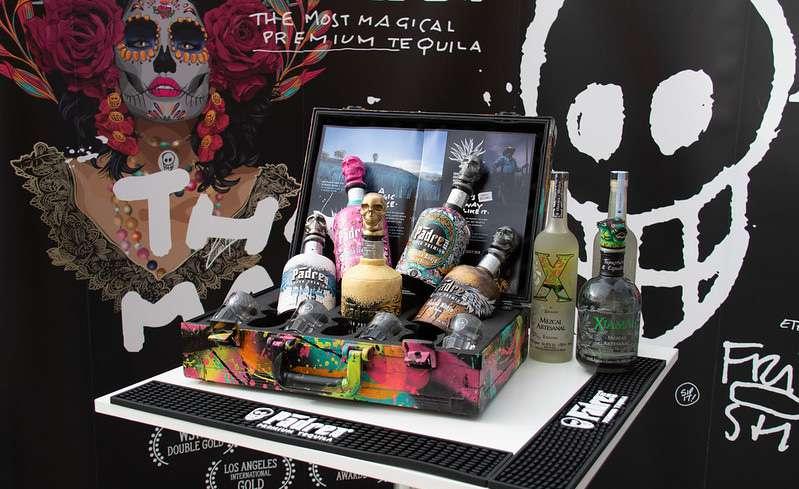
Written by Amanda Hewson - MSOS
Despite the crew’s best efforts, the guest who suffered a suspected heart attack deteriorates—his breathing becomes erratic, and within moments, he collapses. No pulse. He’s not breathing. Cardiac Arrest.
There is no hospital. No ambulance. No paramedics. The yacht is now the hospital, and you are the medical team.
The emergency moment – what happens next?
The crew knows exactly what to do because it’s drilled into their Emergency Management Plan (EMP) and they train regularly (hint hint!)
☑ Scene is already clear – guests moved away, deck cleare
☑ AED is ready – pads exposed, unit powered on
☑ Roles assigned – Medical officer/lead, CPR lead, CPR second, airway support, breathing & oxygen, defibrillator, logistics planning & timekeeper, scribe
Step 1: Confirm Cardiac Arrest
• Unresponsive – no reaction to voice or pain
• No breathing or only agonal gasps
• No pulse Decision made—start CPR immediately. Remember, if they are not breathing we do CPR.
Step 2: High-Quality CPR Starts Immediately
• 30 chest compressions
• Hard, fast, center of the chest
• Depth: 5-6cm
• Rate: 100-120 compressions per minute
• 2 rescue breaths (if it’s safe or you have a CPR mask).
• If crew trained and equipped (bag-valve mask), deliver full breaths
• If not safe or no airway kit, continue hands-only CPR
Why: Immediate, high-quality CPR buys the casualty time—delivers oxygen to the brain until the heart can restart.
Step 3: Apply the AED as Soon as Available
• Attach pads bare chest only—don’t delay CPR for this, dry the chest well.
• Follow voice prompts
Disclaimer:
This content is provided for educational and informational purposes only and is not medical advice. It is not a substitute for professional CPR training, first aid certification, or medical guidance.
Always follow your yacht’s medical protocols, consult your telemedicine provider, and ensure your crew is
• Shock advised? Stand clear, shock delivered
• Continue CPR immediately after the shock—minimize hands-off time
Please note - For AED pad adhesion:
Modern AED pads are very sticky and designed to work on most chests, including moderately hairy ones.
• However: If there is excessive chest hair that prevents good pad-to-skin contact, most AED kits still include a razor so you can quickly shave only the area where the pad will go.
Step 4: Continue the Cycle – CPR, AED, Monitor
☑ CPR cycles – 30 compressions to 2 breaths
☑ Check the AED every 2 minutes
☑ Continue until:
• Casualty regains consciousness
• Medical professionals (telemedicine or medevac) advise stopping
• Crew are physically unable to continue
Step 5: Communicate with Telemedicine / MSOS / (hopefully via THEMIS!)
• Update telemedicine in real-time—report vitals, CPR quality, AED shocks
• Prepare for helicopter medevac or tender transfer if feasible
• Continue documenting every action and timestamping events
Psychological Reality Check:
CPR is hard. Crew fatigue, adrenaline, and emotion hit hard in these moments.
Rotate compressors every 2 minutes if you have the team. Assign someone to monitor the mental load—because after this, the crew will need support.
Final Thought:
In these moments, your Yacht is the hospital. Your preparation, calm, and structured approach are what gives this guest a fighting chance.
You can’t wait for help—you are the help.
properly trained and certified in CPR and AED use by a recognized authority.
In a real emergency, immediate action and professional medical support are critical. ◆
https://www.msos.org.uk



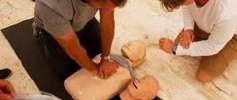
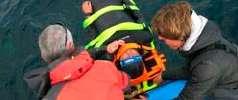

Written by Ricardo Sagarminaga & photos by Alnitak
The Islander reports with sadness that just days after this article was submitted, R/V Toftevaag sank after hitting an unknown object just 10Nm offshore from the shipyard where she just finished a long refit period. We were relieved to learn that all 6 crew were safely heli-lifted. This will not stop Alnitak from continuing their research and conservation operations and they can count on The Islander's continued support.
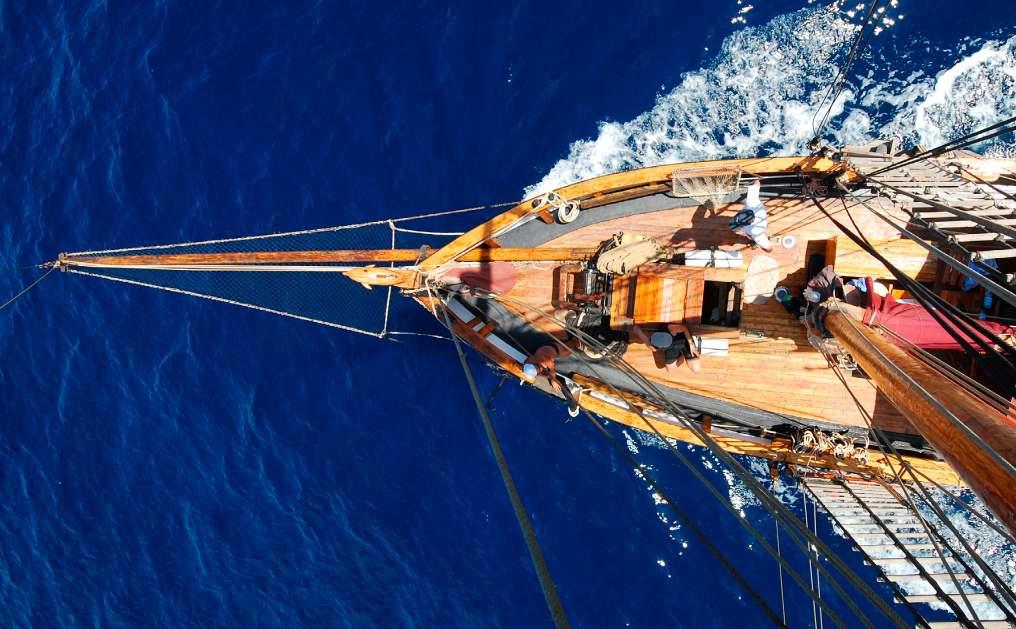
Thor Heyerdahl said that “the oceans are not barriers, but roads”. For an institution like Alnitak, working on raising awareness among mariners and fishers to report and retrieve dangerous marine litter and ghost fishing gear adrift, this could not be more true. In the oceans we have highly mobile common species and also global threats, so spreading the message through sailing boats as the “Pelki” (link to: https://theislander.online/the-ships-journal-from-thedelivery-from-mallorca-to-fiji/ ) about what to do when you find an entangled turtle or dolphin makes a lot of sense.
After over three decades in the Mediterranean, Toftevaag is now also spreading the message. As she starts her new adventure towards colder latitudes of around 70 North, we will meet up with an old friend, Dr. Tiu Similä, joining the Arctic Lodge on the island of Andøya.
Here, north of the Lofoten Islands, Whale2Sea and Whalesafari, have been involved in research on sperm whales, long-finned pilot whales and Risso's dolphins for many years. Led by Dr. Tiu Similä, studies include several collaborations,
mainly with the University of Tromsø, but also with several other universities and institutions such as the Arctic Ocean Lodge. Now Alnitak is joining this consortium.
Toftevaag’s new home, the island of Andøya is known as the “Whale Kingdom of the North” because it is such a top whale watching spot in Norway.
The ocean area off Andøya is unique in several different aspects. The large deep-sea canyon, Bleik canyon, is located here and as it ends only 10 km from land it makes this island the place where deep sea comes closer to land than anywhere else in the Northeast Atlantic. Andfjord between Andøya and Senja is also a unique ecosystem with deep sea coral reefs. Most importantly, the ocean here is very productive due to nutrient rich currents, and the abundance of fish and squid attracts ten different whale species to this area to feed. Which whale species are present is dependent on what prey species are in the area, a factor which varies greatly throughout the year.
The focus of the research has been in gaining a better understanding of the behavioural ecology of male sperm whales. All sperm whales in the North Atlantic are born in tropical or subtropical waters where females spend their entire lives, while males leave to Arctic foraging grounds when they approach puberty. So maybe we also meet some of our big males from the Mediterranean here!
The research also focuses on understanding the social life, habitat use, diet, diving behaviour, vocal communication, pollutant levels, and many other aspects of the life of the sperm whales. Photo-identification, images taken of the fluke of the whales (which works like a fingerprint in humans) was initiated in the area already in 1987 and offers great insights into seasonal patterns in occurrence and also individual differences in the behaviour of the adult male sperm whales.
In recent years, the research has also focused on long-finned pilot whales and Risso's dolphins, species also common to the Mediterranean. Pilot whales have always been seen in the area, but the number of sightings has significantly increased in recent years, probably linked to warming oceans and an “invasion” of mackerel to the area during summer. Risso's dolphins are not part of the arctic fauna but have been seen in ever increasing numbers during summer months, also linked to the warming climate.
Toftevaag will be based on the same pier as the famous classical sailing yacht "Alma af Frøya", a solid and sturdy vessel built to be prepared for managing Arctic conditions and fully equipped with SOLAS safety equipment. In 2026, Alma af Frøya will be running a very special expedition to


study the effects of climate change and microplastic pollution in the Arctic and the famous “Northwest Passage”. For this purpose, Toftevaag has handed over the towed array hydrophone and the 5Gyre Manta trawl that we have been using in the Mediterranean with the “Todos por la Mar –Proyecto LIBERA”. ◆
Written by Matthew Zimmerman, CEO FarSounder

The yachting industry thrives on exploration, luxury, and the experience of sailing through some of the most pristine waters on the planet. Yet, with this privilege comes responsibility. As stewards of the sea, yacht owners, captains, and crew must be proactive in marine conservation efforts. One of the most urgent challenges facing ocean navigation today is the protection of whales—some of the planet’s most magnificent yet endangered creatures.
Ship strikes remain one of the leading causes of whale fatalities, a devastating reality that has motivated FarSounder to take action. Though our innovative Argos 3D Forward Looking Sonars (FLS) technology has been at the forefront of efforts to reduce ship-whale collisions, we are now taking this commitment a step further with the launch of our Whale Spotting and Safe Vessel Operations class.
This new, online course has been created in collaboration with Azura, whose mission is to foster environmental stewardship, and is not a FarSounder product class. Rather, it is a collaborative industry topic class based on everything we’ve learned about how to work with whales while developing our products. The purpose of this class is to enhance whale awareness among bridge crews, yacht owners, and guests alike.
The need for increased awareness and proactive measures has never been more pressing. Many whale populations are struggling for survival. Consider these alarming statistics:
• Only about 300 Western Gray Whales remain.
• The Eastern Mediterranean Sperm Whale population is
down to an estimated 250 individuals.
• The North Atlantic Right Whale population has dwindled to a mere 370.
For these whales, a single ship strike could be catastrophic, further pushing their species toward extinction. Unlike other marine animals, whales are mammals, and therefore, must surface to breathe, making them especially vulnerable to vessel collisions. The ocean is their home, and our responsibility is to navigate it with care.
FarSounder’s role in whale protection
FarSounder has long been dedicated to advancing marine safety and conservation. Our 3D Forward Looking Sonars were originally developed with whale protection in mind, offering captains a real-time view of what lies ahead, including potential obstacles like marine mammals. FarSounder’s technology is designed to be both effective for navigation and safe for the environment—causing no harm to marine life.
FarSounder’s Argos products also build a depth map of everywhere the vessel goes and users can opt-in to anonymously share that map across the fleet and with Seabed 2030. In exchange, they receive access to the aggregate map generated by other FarSounder contributors. Additionally, the system facilitates the collection of citizen science whale sightings and floating trash observations, which are passed on to relevant conservation organizations.
Through our work with whale research initiatives over the last 24 years, FarSounder’s team has gained invaluable insights into these majestic creatures’ behaviors, challenges, and conservation needs. Recognizing the gap in industry education, we designed a course to empower yacht crews
and owners with the knowledge and skills to better share the oceans with these incredible animals and reduce the risk of ship strikes.
Course highlights: enhancing safety and awareness
FarSounder’s Whale Spotting and Safe Vessel Operations class covers essential topics such as:
• How to spot and identify whales
• Exploring best practices when operating in areas known for high whale activity
• The basics of whale biology and conservation
• How to get involved with Citizen Science and supporting directed whale research
FarSounder has enlisted expert guest hosts from leading marine conservation organizations to bring the most up-todate and relevant information to participants. The course is designed to be both informative and practical, equipping class participants with actionable strategies they can implement immediately.
The yachting industry’s responsibility
The yachting industry is uniquely positioned to make a meaningful impact in whale conservation. Superyachts and luxury vessels often traverse areas where whales migrate, feed, and calve. With increasing vessel traffic in these regions, the potential for ship strikes rises. However, with proper awareness and training, this risk can be significantly reduced.
By enrolling in FarSounder’s class, yacht crews can provide a safer, more environmentally responsible experience for guests while also contributing to global conservation efforts. Imagine the added value of not just spotting a whale during a voyage but also knowing that the crew has taken measures to ensure its safety. Such practices elevate a yacht’s reputation,



aligning it with eco-conscious luxury and helping to provide a purpose to the guests’ adventures.
The time to act is now. With whale populations facing mounting threats from ship strikes, climate change, and habitat loss, every effort counts. The yachting industry has an opportunity to lead by example, demonstrating that luxury and conservation can coexist.
FarSounder’s Whale Spotting and Safe Vessel Operations class
offers a chance to turn awareness into action. By participating, you not only enhance the bridge team’s skills and safety measures but also take a vital step in protecting one of the ocean’s most iconic species.
To learn more and enroll in the class, visit www.farsounder.com/whales.
Let’s ensure that future generations can continue to witness the awe-inspiring sight of whales in the wild. Together, we can make a difference. ◆



Written by Virtual Pursers
hen preparing to sign a Seafarer Employment Agreement (SEA), understanding its terms and conditions is essential. SEAs are not uniform and often differ based on the flag state of the vessel. These differences can significantly impact aspects like leave entitlements, certification requirements, and medical cover. This article focuses on minimum leave entitlements, a crucial element for seafarers to examine closely.
Why minimum leave entitlement matters
Leave entitlements are essential to ensuring a healthy work-life balance for seafarers, who spend extended periods away from their families and home. Under the Maritime Labour Convention (MLC, 2006), the standard minimum annual leave is calculated at 2.5 days per month of service, or roughly 30 days a year. However, not all flag states adhere strictly to this standard, and some may offer varying leave arrangements. Here’s what to look for in your SEA regarding leave entitlement.
1. Confirm leave entitlements
The first step is to check how leave is calculated and whether the SEA complies with the MLC standard or offers enhanced benefits. Some flag states or employers may provide more than the minimum 30 days per year, which could be a significant advantage. Ensure the SEA specifies the number of leave days you are entitled to and how these days are accrued. Rotation has become increasingly commonplace with 5:1, 3:1, 2:1 and 1:1 ratios according to seniority.
Certain contracts may also offer additional leave for long voyages or challenging working conditions. Understanding these provisions ensures you can plan your time off and avoid misunderstandings.
2. Check for accumulation policies
Some SEAs allow leave to be accumulated or carried over to subsequent contract periods, while others require it to be used within the same contract period. This distinction is crucial, especially for seafarers facing unforeseen circumstances like extended deployments or delays in crew changes.
Ensure the SEA outlines the rules for leave accumulation and usage. If you cannot take your leave due to operational demands, the agreement should clarify whether unused leave will be compensated or carried forward.
3. Transportation provisions for home leave
Another critical element to review is whether the SEA inclu-
des transportation to and from your home for leave periods. Many employers cover travel expenses as part of their SEA, ensuring you can return home without financial strain. If the vessel is MLC compliant, this is a given, but not all vessels are.
If transportation costs are not included, calculate the potential expenses and factor this into your decision to sign the contract. Additionally, confirm if the SEA covers return travel in emergencies or unexpected contract terminations.
4. Transportation in the event of a seafarer’s death
While it’s a difficult and morbid topic, the SEA should include provisions for the repatriation of a seafarer’s remains in the unfortunate event of death during service. Most flag states and employers are required to cover the costs of transporting the remains to the seafarer’s home country, along with personal belongings. This provision ensures the family is not burdened with the financial and logistical challenges of repatriation. Confirm that this clause is included in the SEA and aligned with the standards set by the MLC, 2006.
Minimum leave entitlement is not just a legal requirement but a fundamental aspect of a seafarer’s overall well-being. By thoroughly reviewing the leave provisions in your SEA, you can ensure that your time off is adequate, well-compensated, and effectively planned. This is just one of several key areas to focus on when reviewing your SEA. If you are unsure of any of the stipulations, clarify with your employer, it your right to be able to understand all aspects of your contract fully before making a commitment. Stay tuned for Part 2, where we’ll delve into certification requirements. ◆


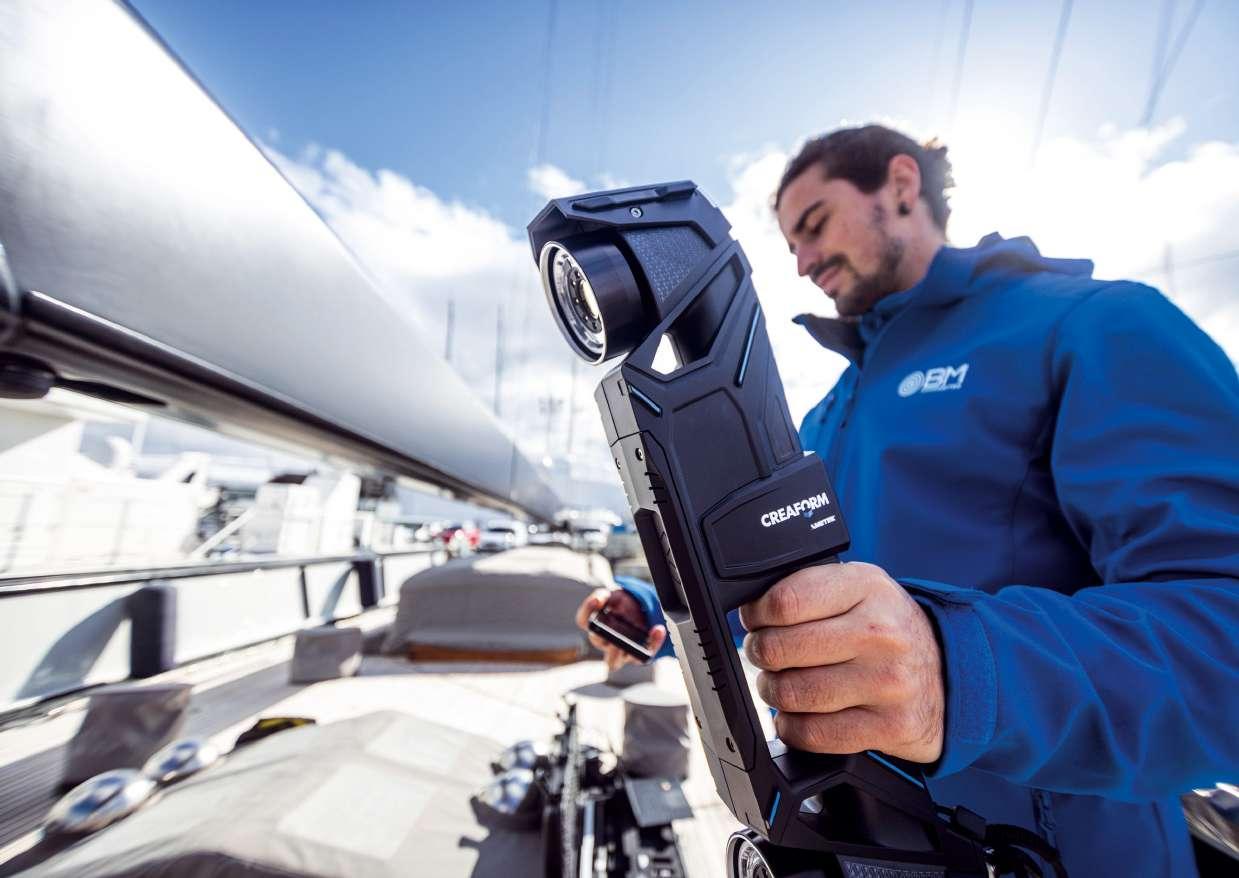
BMC OFFER THE LATEST 3D SCANNING TECHNOLOGY AND DESIGN SERVICES
3D SCANNING & RENDERING
FULL IN-HOUSE DESIGN TEAM
RE-DESIGN, REVERSE ENGINEER, FIT & BUILD
SCAN LARGE COMPLEX AREAS
TOTAL PRECISION
GAME CHANGING EFFICIENCY
HIGH SPEED ACCURACY
FULLY MOBILE WORLDWIDE
STRUCTURAL ENGINEERING, GEOMETRY, VERIFICATION & FINITE
ELEMENT ANALYSIS

Written
Nestled in the heart of the Mediterranean, the Balearic Islands are a premier destination for superyachts seeking unforgettable luxury experiences. A seamless blend of natural beauty, rich culture and exclusivity makes them the ultimate haven. As the new yachting season approaches, Evolution Yacht Agents redefines luxury with a bespoke concierge service, curating every detail to perfection.
Whether you’re seeking vibrant nightlife in Ibiza, immersing in Mallorca’s cultural heritage or peaceful isolation in Menorca, Evolution ensures every aspect of your journey is flawlessly executed. From securing your preferred table at a Michelin-starred restaurant to arranging last-minute private events or setting up a secluded cove for an intimate beachside dinner, we bring your vision to life with unmatched precision and care.
• Tailor- made itineraries blending relaxation, adventure and high-end entertainment.
• VIP access to exclusive venues, from world-renowned clubs to Michelin-starred restaurants.
• Seamless luxury transport, including VIP transfers.
• Discreet security and protection services.
• Exclusive onboard entertainment from private performances to themed events.
• Health and wellness services, including spa treatments or personal trainers.
• Unforgettable experiences crafted to suit the most refined tastes.
The Balearics offer a diverse range of landscapes, flavors and experiences, each with its own unique charm. Evolution makes sure you experience the best of each island in the most exclusive way possible.
• Mallorca: A haven for culture and elegance, combining vibrant culture, hidden coves and world-class gastronomy. Evolution Yacht Agents redefines luxury to the next level with fully customized arrangements, ensuring every detail exceeds expectations. Spend the day exploring crystal-clear waters and finish with a private dining experience with breathtaking views. With Kitchens of Spain, our exclusive VIP culinary service, Michelin-starred chefs prepare unique tasting experiences, expertly paired with the finest wines and Spanish cuisine.
• Ibiza: Known as the White Island, Ibiza offers far more than its legendary nightlife. Evolution ensures VIP guests enjoy exclusive wellness treatments onboard,
Yacht Agents


curated villa recommendations and priority access to the island's most sought-after events. Soak up breathtaking sunsets, explore secluded coves with crystal-clear waters and end the night with VIP tables at the best clubs in Ibiza, guaranteeing you an unparalleled experience.
• Formentera: The ultimate escape, this small yet captivating island offers serene beauty and total seclusion. Evolution arranges private beach setups, exclusive sailing routes and an array of water sports activities, allowing you to explore hidden coves and unwind in the utmost privacy.
• Menorca: A sanctuary of tranquility, where curated historical expeditions, premium diving trips and gourmet experiences unveil the island’s best-kept culinary secrets. Whether enjoying a private tour along Menorca’s rugged coastline or indulging in an exclusive tasting of its traditional delicacies, we assure an unforgettable experience.
At Evolution, excellence is our standard - every detail matters, and every request becomes a priority. Our dedicated team ensures last-minute requests are met with efficiency, guaranteeing a flawless experience from arrival to departure. With an extensive network of trusted partners, we offer exclusive services tailored for the most refined guests. From the most outrageous demands to the finest details, Evolution is always ready to exceed expectations, ensuring guests an extraordinary stay in the Balearic Islands. ◆
Plan your next yachting season in the Balearics with Evolution:
Palma: palma@evolutionagents.com
Ibiza & Formentera: ibiza@evolutionagents.com
Menorca: menorca@evolutionagents.com
Contact us: +34 971 400 200
Step into a realm of unmatched luxury services with Evolution Yacht Agents, where every detail is tailored to perfection. From securing private anchorages to crafting tailor-made itineraries and granting exclusive access to elite events and restaurants, we anticipate every need to create a seamless experience for the most discerning guests in the Balearics. Evolution is always ready to exceed expectations, ensuring luxury without limits and service without compromise.
Written by Chef Raffie

Ah, Mallorca. Sun-kissed waters, breezy afternoons, and… yet another yacht job offer that reads like a dystopian novella.
Here’s the ad:
“Position: Chef / Indentured Servant” (Okay, it actually says “Chef,” but we all know what they mean.)
Vessel: 40m Motor Yacht under the Spanish flag—because
nothing says “easy paperwork” like entering the bureaucratic maze of Spain in June, while still waiting on your Tax ID and praying someone finds your Social Security number before the second charter.
Start Date: ASAP.
Translation?
We forgot about you, Chef. Again. You know, the person who has to feed 20 souls three times a day, plus snacks, tapas, hors d’oeuvres, and the occasional lastminute “botanita” that no one can define but everyone wants.
They’re looking for one (yes, ONE) chef to handle 20 people, breakfast through midnight cravings.
But don’t worry—they’re offering “industry standard” pay.
Which in yachting terms means: “You’ll be overworked, underpaid, and possibly hallucinating by August.”
Contract Type: Full-time seasonal
Which cleverly translates to: “You’re fulltime until we get what we need out of you, then bye.”
Because heaven forbid they keep you around long enough to pay you freelance or offer benefits.
(Another red flag flapping in the Mediterranean breeze.)
Now let’s talk expectations:
• Fluent in English and Spanish.
• Must hold a specific medical certificate (but not ENG1, of course—because that would be too convenient).
• Be friendly, professional, “active”… which is HR-speak for: “Ready to work 16 hours a day with no breaks, no groceries, and no complaints.”
Also, don’t forget to have thick skin, because you’ll be catering to:
• The vegan (on weekdays),
• The keto bro (but only until tequila hour),
• The gluten-intolerant stew (who eats bread in secret),
• And the owner who “eats clean” but wants sliders and fries at 11PM.
Let’s not overlook the final cherry on top: “Send your CV to: chiefstewardess@gmail.com”
Now, if you’ve been in the game long enough, you already know:
If the chief stew is handling hiring, chances are…
• She’s either married to the captain,
• Engaged to the mate,
• Or just running the ship like Beyoncé on a power trip.
So congratulations, you’re applying for a job where the true chain of command is part soap opera, part Game of Thrones.
About the vessel?
They proudly mention “an active charter program” for summer 2025.
Translation?
Back-to-back charters with no time to prep, clean, breathe, or feel joy.
A fast-track to burnout, creative block, and the sudden realization that maybe opening a taco stand on land wasn’t such a bad idea after all.
Moral of the story?
If the ad reads like a rescue mission—run.
If they remember the chef last… remember yourself first.
And if you do take the job?
Make sure your knives are sharp, your provisioning contacts are on speed dial, and your exit plan is airtight.
Because in this kitchen, you’re not just cooking.
You’re surviving. ◆

Chef Luis Rafael “Raffie” Hurtado is a cosmopolitan culinary storyteller whose journey from galley to page is as flavorful as the dishes he creates. With over 20 years in the yachting industry, Chef Raffie has traveled the globe, collecting spices, stories, and the occasional kitchen battle scar from three continents’ worth of prestigious internships and professional kitchens.
Fluent in English, Spanish, French, and Italian, he brings a worldly repertoire to every plate and every paragraph. His unique background includes not only luxury yacht cuisine but also time spent as a chef instructor at the high school level in South Florida, where he mentored the next generation with a blend of tough love, real-world grit, and the occasional well-timed joke.
Now transitioning into his role as a chef-writer, Raffie is set to release his long-awaited memoir, chronicling the wild, wonderful, and wildly unpredictable life of a yacht chef—with plenty of laugh-out-loud moments and a few splashes of sarcasm. Alongside his writing, he’s also launching his own line of signature seasoning blends, designed to bring global flavor to everyday cooking with the ease and flair of someone who’s lived it all.
Equal parts satirist and saucier, Raffie offers readers a sharp, humorous, and refreshingly honest take on the culinary world—proving that behind every elegant dish is a story worth telling… and probably a chef who’s slightly sleep-deprived but still smiling.
Written by Toio

TOIO is an innovative Italian brand that has quickly gained recognition in the sailing and technical apparel world. Despite being a young company, TOIO is built on over 40 years of experience in the nautical clothing industry, giving it a deep understanding of the needs of sailors, yacht crews, and maritime professionals. Specializing in highperformance gear for superyachts, yacht clubs, and technical sailing, TOIO focuses on delivering top-tier products known for their design, functionality, and durability.
Discover our technical collection – created by sailors for sailors
TOIO’s technical line is designed by sailors, for sailors, offering a range of products that meet the demands of the sea. The FORZA 1 JACKET, for example, is a standout piece. Made from waterproof, breathable stretch fabric, it’s fully taped for superior protection. Ergonomic cuts at the armholes and elbows improve mobility, while features like waterproof zippers, adjustable Velcro cuffs, and a neon yellow roll-away hood enhance both comfort and visibility. The jacket pairs perfectly with the FORZA 1 BIBS, a waterproof and breathable option that ensures protection for sailors.

Italian elegance meets technical performance
Italian elegance is at the core of TOIO’s design philosophy. Every product is crafted by a team of Italian professionals who carefully select the finest materials. The result is a balance of comfort, durability, and style. TOIO’s commitment to using high-quality materials comes from extensive global research, ensuring that each product is both technically advanced and long-lasting.
Customizable apparel for yacht crews and professionals
TOIO offers customization options for yacht crews, yacht clubs, and shipyards. With in-house embroidery and printing facilities, TOIO can personalize uniforms and apparel quickly—often within a single day. This flexibility is ideal for clients who require custom branding or specialized designs for their teams.
Explore more of our technical collection
For more information about the TOIO products and to explore the full collection, visit www.toio.com. Stay updated by following them on Instagram at @toio_sportswear.◆


SAFETY SHOE
SOLE: Rubber, EVA
TOE: Fibreglass
LEATHER: Oiled Crazy Horse
HAND-STITCHED: Resistant and durable
REFERNCE STANDARDS: EN ISO 20345:2011
SLIP RESISTANCE: SRC Non marking and Non-Slip
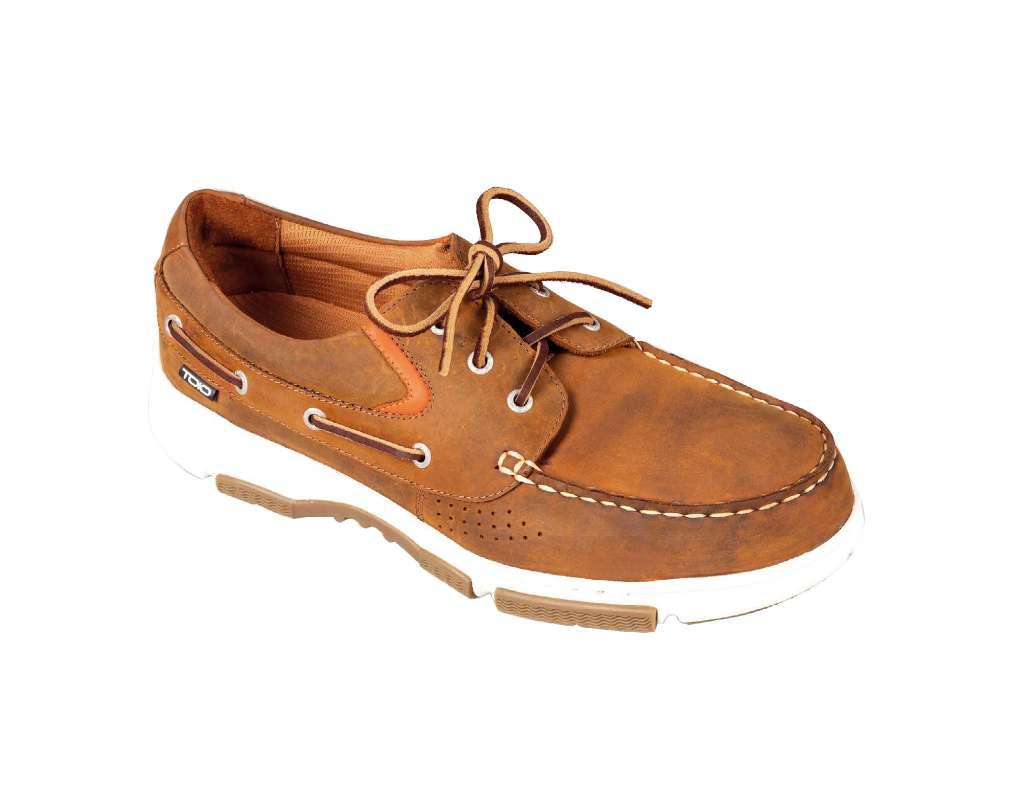



Tzarina Mace-Ralph is a talented yacht chef who appears in season 2 and the current season 3 of reality TV show Below Deck.
Overnight she became a public figure with a large, predominantly U.S. fan base. While the yachting industry may have its own ideas of the show, Tzarina decided intuitively to use her reach to support deep causes. She was quoted in Rolling Stone magazine on how she addressed a sexual assault case. She has been featured in medical trade magazines on the impact of truly healthy food. In her regular Islander column, she shares her thoughts and observations on the yachting industry. Specifically, matters that affect crew. From Below Deck to under the surface.
Written by Tzarina Mace-Ralph
The highs and lows of crew food in the yachting industry
Crew food is the unsung cornerstone of life aboard a yacht. While charter guests may demand intricate menus and elaborate presentations, anyone with experience in yachting knows that the real challenge lies in feeding the crew. Watching shows like Below Deck, one might assume that meeting the guests’ demands is the ultimate test of a chef’s skill. However, the reality is that crew preferences can be far more complex and demanding.
The challenges of crew food
Let’s begin with the difficulties—because, let’s be honest, they’re the most compelling. As a seasoned yacht chef, some of my most stressful moments have come not from catering to guests but from navigating the labyrinth of crew preferences. I’ve dealt with complaints about strawberries that were deemed “too bruised” (despite barely visible marks) and had entire yogurt supplies rejected for not being the exact preferred brand.
One particularly memorable challenge involved catering to a crew of 15 with wildly varied dietary requirements, spanning vegan, paleo, keto, diabetic, and carnivore diets—all at once. It’s not just about cooking; it’s about constant problem-solving, diplomacy, and creativity.
A standout story from my career took place during the COVID-19 pandemic while I was working on a yacht in Antigua. The local supermarkets were nearly barren, and I felt it was essential to leave food for the island’s residents rather than depleting the already limited stock. I proposed to the chief stewardess that we temporarily simplify our meals, reducing the extravagant 10 to 15 options we served at every lunch and dinner. Her reaction was as though I had committed a cardinal sin—despite the extraordinary circumstances, she insisted on maintaining the usual opulence. Tell me how the crew got so spoiled. The rewards of crew food
Yet, despite the challenges, there is immense satisfaction in cooking for the crew. During yard periods, after the chaos of a charter season, there’s something deeply fulfilling about creating dishes that bring comfort and joy to those around you. I make it a point to ask crew members about the meals they miss most from home, whether it’s their grandmother’s pie, a family roast dinner, or a traditional Filipino dish I’ve never cooked before. Preparing these meals fosters a sense
of connection and camaraderie that is invaluable in the high-pressure, isolating environment of yachting.
Crew vs. guests: the harder crowd
What you see on Below Deck only scratches the surface of the culinary challenges on yachts. While charter guests may have demanding preference sheets, their expectations are generally straightforward: exquisite, well-executed meals. Crew, on the other hand, often requires a delicate balance of variety, familiarity, and dietary accommodation, all while operating under the time and resource constraints of a busy yacht.
The key to thriving as a yacht chef lies in finding balance. While indulgent, comforting meals are essential for morale, nutrition must always take precedence. A healthy, well-fed crew is not only happier but also more effective in their roles.
Feeding a yacht’s crew is one of the most demanding yet rewarding aspects of life onboard. It’s not just about nourishment; it’s about creating moments of care and connection that sustain both body and spirit—even in the most challenging circumstances. ◆
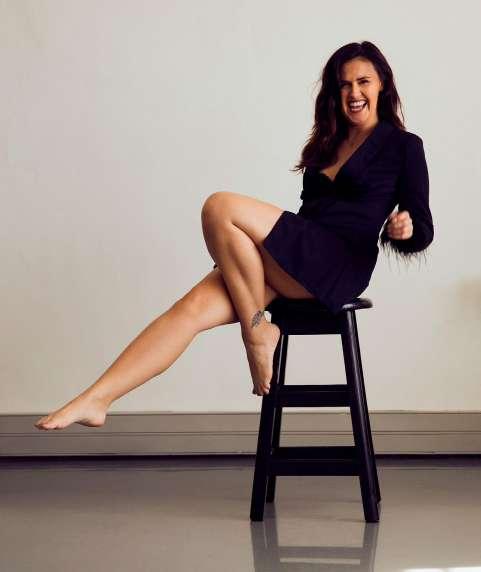

92 . The ship’s journal from the delivery from Mallorca to Fiji
96. From jaguar conservation to island stewardship
100. Assessing the threat of a tropical worm to the Balearic ecosystem
104. The Community Vessel: a game-changer for marine regeneration and education in the Balearic Sea
108. JoyRon Foundation information and update.
110. Phillip Seippel, avid sailor, successful businessman and true Mallorca Islander reflects on his 60 years cruising, racing and living in Mallorca.
112. 5 beaches on Mallorca’s east coast that are worth every step
114. Why sleep is important to be a good diver
118. Gulf of Thailand's Ocean Marina Jomtien awarded 1st global accreditation
120. Brokerage
Written and photos by Jens Oomes

Update 13/03/25 16:00 (GMT-5) Cayos
Since November I have been in contact with the agent who will organise our canal transit. He told me that once we're physically in Colon, it could take 3 to 4 weeks to go through. When we arrived at Shelter Bay Marina, on Sunday 2 March, he told us it would now be 4-5 days from the moment we'd say we're ready to go. This meant we wouldn't go to the San Blas islands which we were already eyeballing to sit out the waiting time.
We required a few parts and had to get a few jobs done to commit to a departure in less than 5 days. We arrived in the middle of the Carnaval festivities and, until Wednesday, only the major supermarkets were open. A taxi driver told us most of the Carnaval festivities had been cancelled because there had been too many gunfights! So we cancelled our plans of joining in with the local folklore!
To our amazement, the chandlery in the marina, which was
open during Carnaval, stocks next to nothing. Sourcing parts was an adventure in itself. We had to bribe a guard to enter an industrial site where a hardware wholesaler had the screws we needed to keep our genoa foil together.
During the rest of the week we got a lot of jobs done while the kids were running around the marina with the other cruiser's kids. They also explored the jungle. At a 2 minutes distance you can spot cappuccino- and howler monkeys, vultures, eagles, and amazing flora. They didn't spot the two crocodiles that supposedly live in the area but they did see a python!
On Friday 7 March I told our agent that we're ready to leave in 4-5 days. He replied that the next slot is the 20th! I reminded him of what he had told me 4 days earlier and pressed it upon him that we wanted to go earlier. Over the weekend he didn't react of course. We went to visit Panama city. After a long conversation with the agent on Monday it was clear that it was unlikely that we'd now transit before the
20th so we made him lock us in for that date and made plans to go to San Blas the next day. Of course it would be a great use of our time and it would save some budget on mooring fees.
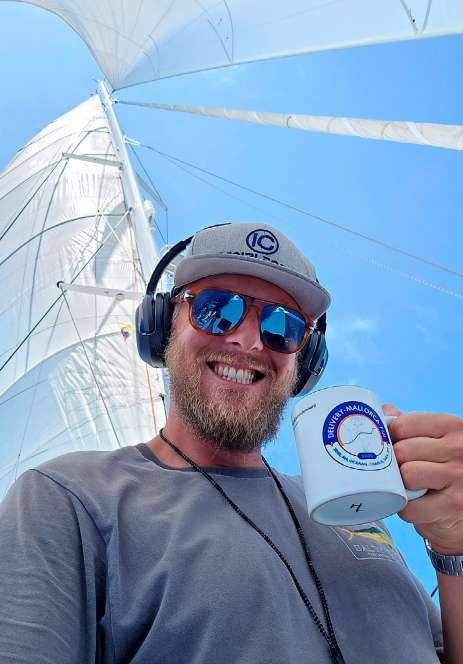
We sailed along the jungle coastline to the first San Blas island. Porvenir is not much more than a sandbank with an airfield on it. The tarmac has recently collapsed at the far end so it's now out of use. However, we still have to visit the island to check in and obtain a cruising permit here. The indigenous Guna people have maintained a level of autonomy. They are not entirely subjected to the rules and regulations of Panama. Half a mile next to Porvenir is Whichubhuala where a community of Gunas live together in straw huts with thatched roofs. They too rowed out to us as soon as we dropped the hook. This time to sell bracelets and "Molas" which is stitched artwork.
Update 20/03/25 09:45 Shelter Bay Colon
I'm not going to lie; our 3 days in the San Blas Islands felt like a holiday. Of course we did a couple hours of stainless steel polishing every day to feel less guilty and of course we were there to save on mooring fees, but what a steal that was! I find anchoring, in general, a magical thing. Perhaps it's one of the last freedoms our world has on offer. You just find a spot, drop a large piece of steel on a chain, and you're there with your whole house. And especially in places like here it feels like a real privilege being able to do that.
We went snorkelling at a wreck at Dog Island. We were pleased to see many colours and a great variety of fish. An
hour later there was also a great variety of tourists brought in by an invading armada of high speed longboats from the mainland. I couldn't help myself from telling one ignorant tourist to not stand on the wreck and its coral... There is hope for this beautiful archipelago to be preserved but education of its inhabitants and its visitors is urgently required.
We anchored next to a very small island of about 25m by 30m surrounded by a sand bank of an estimated 1000m² which surely used to be above the waterline a while back. Now it had about 40cm of water over it. We were swimming on the ridge of the sandbank when the father of the family residing on the island sailed by in his dugout canoe and invited me to hop in! Together we sailed to their large hut on their small island. Obviously they have no fresh water source on such a small island so I asked him if he had jerry cans so we could offer them some. Our watermaker is working fine now. They were very happy and gave the kids some bracelets. We were allowed to have a look inside their huts. The largest one was completely empty. In the smaller one they were setting up a structure with sticks to smoke fish. Yes, they make fire inside a dry straw hut. They sleep outside in hammocks under a palmleaf shelter. I was a bit shocked when they asked if we had any garbage so they could burn it. I thought about the logic. They have to bring firewood from other islands or the mainland. Having resorted to burning garbage as the best solution to get rid of it, they also simply see it as a good combustible. Did I mention that education would be a good start to preserve these islands?
On Monday we arrived back in Shelter Bay Marina allowing us 2 days to provision and fuel. On Tuesday our agent simply told us our transit is delayed by another but we will have a one day passage. This means that we will still enter the Pacific on the 21st as was the plan last week. It also means we have to leave the Marina tonight. Hopefully our 2 additional line handlers will be on board on the agreed time. Having 4 able linehandlers is a legal requirement. In the locks we will have 4 lines of 30m running from each corner of the catamaran to the bollards on shore. When the water level in the lock rises, the slack in the lines needs to be taken up. When the level drops the lines have to be slipped so we don't become suspended or break out cleats. The pilot will come on board around 3am and we will enter the lock around 6am. We should be in the Pacific Ocean by 3pm tomorrow!
Update 25 March 25 1600LT (GMT -6) somewhere between Panama and the Galapagos Islands. When we finally exited the last lock of the Panama Canal after some delays, I was quite tired. The pilot who had been with us all day was picked up by a pilot boat underneath the iconic Bridge of the Americas, the gateway to the Pacific. We decided to anchor for the night and enter the biggest Ocean on the planet with a fresh and well rested body and mind.
This part of the Pacific isn't offering us the Trade Wind sleighride we've had since Gibraltar. The winds are light and variable as we are entering the Inter Tropical Convergence Zone what used to be called the Doldrums. I'm grateful for our engine and the extra fuel we carry because having to sit it
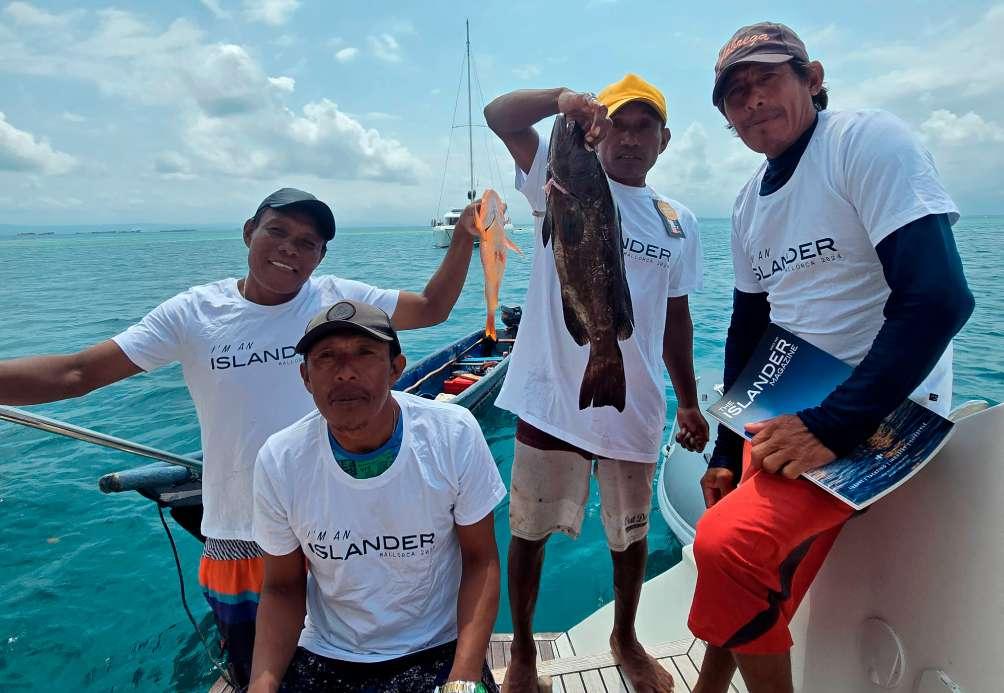
out here in the heat and humidity would be hellish! What's constantly on my mind is the forecasted Westerly wind that we will incurr closer to the Galapagos. This boat really does not like to be driven into the wind. So very counterintuitively we are maintaining an almost Westerly course instead of aiming straight for the islands. This will allow us to make a sharp angle South when the Westerly wind picks up. The currents here create weird and eerie patterns in the sea. But more concerning are all the logs and other debris it drives together like long barriers which we have to cross. There is also quite a lot of plastic in this part of the Ocean unfurtunately. We just hope that at night we don't hit a big log.
Yesterday we hooked a 2 meter Sailfish. We had it reeled all the way in and quite docile, the majestic creature was swimming next to the boat. Feeling a mixture of awe and fear and -knowing we couldn't store that much fish anyway- we decided to set it free. Every night there has been lightning in the distance but last night it was nearer to us. Lightning and thunder were still far apart but there were one or two loud crackers.
Today was a filled program. This morning we were visited by a mega pod of about 100 dolphins. Around 11am we picked up a ghost FAD (Fish Aggregating Device) this is basically a couple of jerrycans and drums tied together with lines and all sorts of plastic. Underneath it, algae start to grow. It attracts small fish and later bigger fish after which the fishermen will circle their nets around it and pick up whatever swims underneath it. It's an illegal method in many parts of the world and when it loses its anchor it becomes a ghost FAD. As we approached it, a large (about 90cm) turtle swam away from it. Luckily it wasn't tangled yet!
A few hours later we encountered more fishing buoys. Either from long liners or drift nets. We also saw a fishing vessel which had no AIS signal... all very suspicious.
A lonely dolphin approached us with high jumps. When it was at the bow we saw it had a remora attached to it. It looked like it was trying to scratch it off using our bow. We thought we should help it getting the creature detached. We stopped the boat and I got in the water with mask and snorkel. It checked me out and came closer and closer. At one point it was 50cm in front of me. I couldn't reach the remora though. Then I saw the remora unlatch. The fact that the porpous didn't use the opportunity to swim away made me realise that we were trying to be heroes for no real reason. It's different if an animal is suffering from a man made danger, but this was nature doing its thing of course. But what an experience to swim close to this wild animal in the ocean of oceans!
Update 02/04/25 1430hr (GMT-7) San Christobal Galapagos.
On Friday the 2nd of March we completed the 7 day passage from Panama City to San Christobal Galapagos. Our anchor wasn't even properly set when the first sea lion came to say hello. We were warned to barricade the transom steps so they couldn't jump on deck.
Checking in happened at the agreed time. A water taxi brought a team of about 8 officials on board. Navy,
environmental protection, a doctor, an immigration officer and customs. They saw we were well organised and within 45mins we were allowed to lower the yellow quarantine flag and welcomed on land. We weren't sure whether we were allowed to take our own tender ashore. The agent informed us:"No problem with that. But when you come back to the tender dock there will be about 8 sea lions on board and the cubs like to sink their teeth in the inflatable parts." So 1 dollar watertaxi rides have been our means of transportation since we are here.
On Sunday I went diving and the rest of the gang snorkeling, at Kicker Rock. The snorkelers saw big turtles, lot's of fish and Jan caught a glimpse of a shark. 20 meters deeper down, I was blowing bubbles in the incredible company of various sharks. Black tips, white tips, Galapagos and even 2 hammerhead sharks. I also swam in a large school of fish and became engulfed by it in complete darkness, which was a mindblowing experience.
Sunday night was less fun as Charlie became violently sick. Our favourite watertaxi driver told us theres a 2 day stomach virus going round, it clearly setpped aboard the Pelki. On Monday it was time for provisioning, laundry and fuel bunkering. I heard bad things about the quality of fuel. It was delivered by a small boat carrying dirty drums and transferred by a dirty hose. We had prepared a few empty 1 gallon waterbottles so I could take a sample of each drum before committing to filling our tanks. This was somewhat reassuring but I did refuse one barrel with murky fuel. We
should now carry enough fuel to get through the windless first few days before reaching moderate tradewinds that should push us over the 3000Nm to Nuku Hiva Marquesas.
Charlie recovered quickly and on Tuesday we drove up to the freshwater lagoon in the dormant crater of El Junco where the Frigats come to clean the salt water of their feathers. We also went to the giant landturtle breeding center to see these prehistoric and impressive looking creatures with our own eyes.
Then we took a refreshing swim at the stunning beach of Puerto Chino. I believe this is the most beautiful beach I have ever been to! The powdersand is incredibly soft and the pale white colour creates a spectacular contrast with the lava rocks. Then there is the deep green lush vegetation and turquoise blue to complete the perfect picture. There is a total absence of construction, not too many people and you have to basically walk around the finches (seabirds) and sea lions.
Apart from Charlie and I the crew went back on board after a nice and typical menu del dia. When they stepped aboard they found our barricade had been compromised. A big sea lion was chilling on the cockpit floor and an even bigger one was lounging on the sofa... They spent hours rinsing away the excrements from the deck and grease, hair and smell from the cushions. Sea lions are funny-not-funny.
Last night was also less funny as both Sara and An fell victim to the tummy virus. I'm going to guess Jan is once again unshakeable and I am currently fighting it off with a certain degree of success. Oceaan is still bouncing around. The kids are spending time with two girls (9 and 12) from another yacht who had already heard about Oceaan and Charlie in Shelter Bay! Jan and I went to do a big provisioning session at the local market which was a nice experience. We hope that we're all healthy tomorrow, ready to clear out and attack the 2nd (after the Atlantic) of the two 3000nm legs of this delivery.

Update 06/04/25 0100am (GMT-8) 400Nm WSW from the Galapagos.
Sara screeched and then screamed high pitched noises. Not exactly intimidating but clearly angry. Seconds earlier we had weighed and secured our anchor. One more audacious sea lion had snuck all the way into the cockpit. But the stinking stowaway thought wise to hop and slide back into Wreck Bay. Danny the friendly watertaxi driver
drove out to wave goodbye and receive his Islander t shirt. The girls on SY Calm who had just spent 2 fun days with our kids were ashore unfortunately.
Sara's tummy was still a bit insecure, An's ached and I was sure I had a fever and knew I couldn't be to far away from the head but I was feeling better by the hour.
We were all happy to be at sea again. We saw 2 more sea lions 4 miles offshore and a very big pod of dolphins in the late afternoon.
The next day everybody bar An was in top form again. It was time for the kids to return to their school tasks. That was the biggest challenge of the day unfortunately... Sara, An and I set the example by doing our own office work as well.
The biggest sperm whale we've ever seen swam by followed by 2 more in the distance. Dolphins were here and there. Charlie spotted a shark. The birds are living and crapping on board again. I had to tell Oceaan off for lassooing one! Luckily neither bird nor boy were harmed. We were sailing pretty nicely under mainsail and genoa and later we exchanged the genoa for the Code Zero. At nightfall we dowsed the mainsail.
Yesterday the routine was pretty much already found as well as the tradewinds. Office time was interrupted by the loud and long zzzzing of the reel. We stopped the boat. We reversed actually as whatever was hooked was unstoppable. Once we could start taking line back in the break was on completely but the monster would at times still run away. The rod was bent like never before. An was manoeuvring under engine. The kids were passing on my instructions to her on the flybridge.
We were stopped for almost 2 hours. That's how long the fight lasted. In the last 20 minutes the enormous, estimated 100kg Yellowfin revealed itself. Then ran with the line again. Then was reeled in again. In the end I resorted to setting the line on the capstan. This is a small winch on the back of the boat, designed to pull mooringlines in. I said to Jan that it would be make or break. To our surprise, it worked a dream and with hardly any effort we were bringing in the giant fish. It was circling under and next to the boat. I was just about to grab the gaff -the hook with which you pull the fish on board.
And then, with a loud snap, the nylon line broke and with it our hearts... We decided we need to get smaller lures because we're only hooking massive fish. Charlie Beau had organised a quiz for afternoon entertainment which was enjoyed together with An's peanut butter oat cookies. Jan had made a banana bread for evening dessert. I'm on my night watch now and have just adjusted the course from WSW to straight onto Nuku Hiva. We're averaging 7kts and all is very well! ◆
At the time this Islander issue is going to print, we are approaching Hiva Oa in the Marquesas Islands. Can't wait until the July / August issue to follow our story?
Go to www.theislander.online and look for The Ships Journal
Read the full ship’s journal on our website


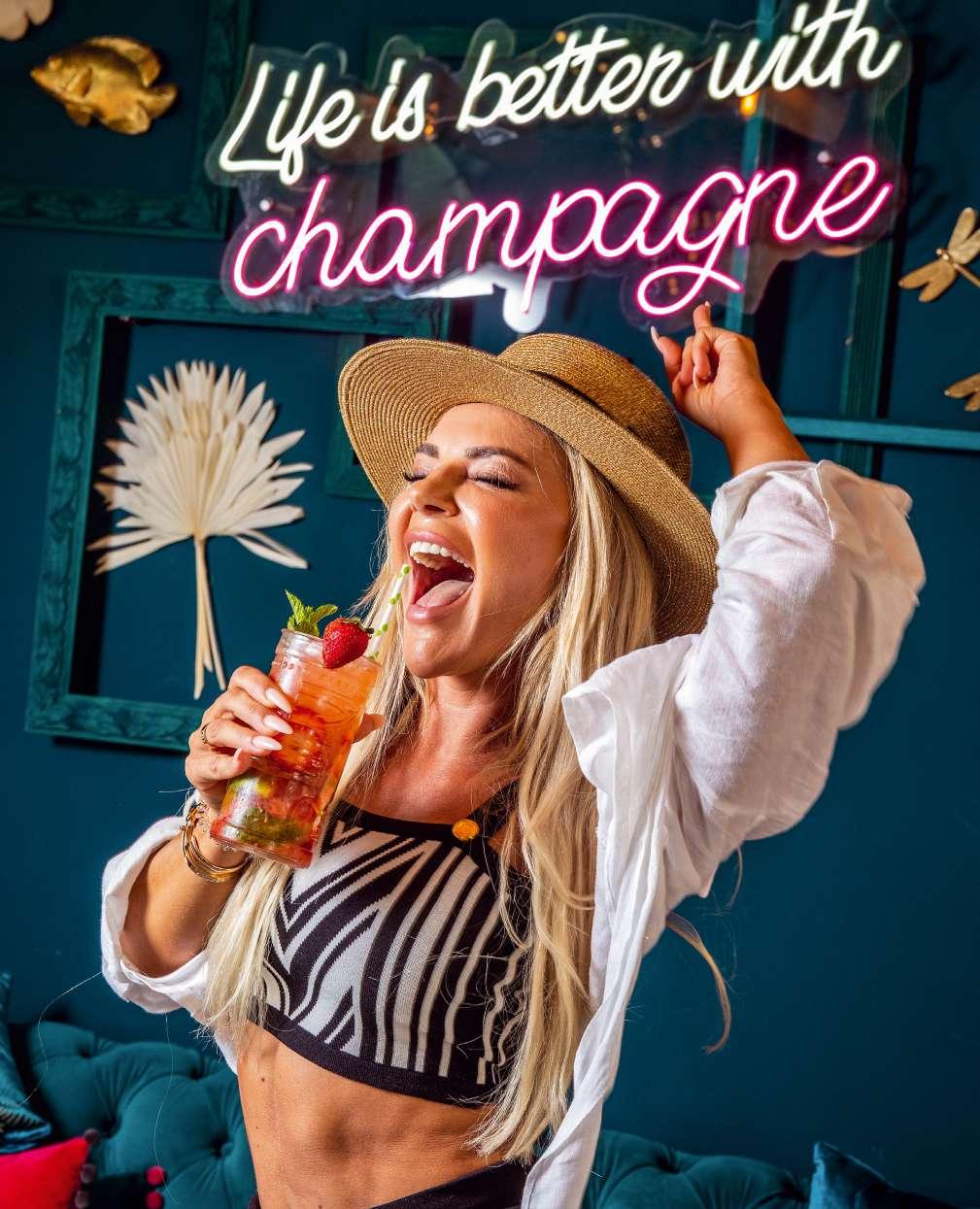





Written by Kimberly Craighead and Milton Yacelga

During their visit to the San Blas Islands, Jens Oomes and his family were shocked and saddened by the amount of plastic pollution they encountered on the shores of these beautiful islands. Walking past the main meeting hut in the village of Wichub Wala they overheard the villagers discussions about solutions for the plastic pollution issues. The meeting was led by Kimberly Craighead and Milton Yacelga from www.kaminando. org. While their original focus lies in the research and conservation of jaguars, as a flagship species of the Panamanian jungle, they discovered another urgent conservation issue in the San Blas Islands. The Islander wanted to help Kaminando raise awareness about the issues that threaten this beautiful cruising area often visited by luxury and superyachts.
The UN Environment Programme (UNEP), in its report titled “Making Peace with Nature,” highlights the impacts of three interconnected threats: climate change, the loss of biodiversity and ecosystem integrity, and pollution. The report argues that if we want to achieve the Sustainable Development Goals by 2030, we must urgently break away from current trends of environmental decline. However, adverse human activities continue to affect three-quarters of the land and two-thirds of the oceans. Over a million species of plants and animals are on the brink of extinction, and many ecosystem services essential for human well-being are increasingly deteriorating.
We are the founders of Kaminando Habitat Connectivity Initiative, a grassroots organization that combines advanced biological research, community outreach, and environmental education for a multidisciplinary approach to conservation. Our research focuses on the threatened jaguar and its habitat, integrating scientific methods with traditional ecological knowledge (TEK) to enhance collaborative conservation efforts with the Indigenous Guna People. While we conduct our jaguar research on the Guna's mainland territory—one of Panama's largest remaining intact forests and a major ecological hotspot—our community outreach and education also extends to the offshore islands of San Blas, which are home to densely populated Guna communities that rely on agriculture, hunting, ocean fishing, and tourism for their livelihoods. We write this article to highlight our ecological and socio-cultural concerns for the future of this unique land and its people.
In this context, we focus on the captivating archipelago of San Blas. This region comprises approximately 365 islands and cays off the north coast of the Isthmus of Panama, east of the Panama Canal in the Caribbean Sea. Its idyllic climate, clear waters, and islands ringed with white sand and coral reefs attract thousands of tourists by land and by sea. Yes, as discussed in our peer-reviewed publication, "Indigenous Peoples’ Displacement and Jaguar Survival in a Warming Planet," coastal and island communities are at the forefront of facing increasing temperatures, sea-level rise, and ocean acidification due to climate change. Furthermore,
the Intergovernmental Panel on Climate Change has noted that small islands and atolls, which rarely exceed 3–4 meters above sea level, are particularly vulnerable to flooding from rising seas.
San Blas also faces significant issues with coastal and islandbased plastic pollution. This pollution reaches the area through ocean currents, runoff, tourism, yachts, and locals. Plastics pose serious threats to wildlife, human health, and the livelihoods of people in the region. Marine life can become entangled in plastic debris, resulting in injury or death, while ingesting plastic can cause internal injuries. The delicate ecosystems of coral reefs, mangroves, and seagrass beds are also at risk. The introduction of plastics into these environments disrupts the balance of ecosystems, leading to a decline in biodiversity. Moreover, plastic pollution introduces health risks to the inhabitants of San Blas. As harmful microplastics enter the food chain, they can have long-term health effects on the people who rely on local fish and seafood for sustenance.
According to the Global Plastic Outlook Database, plastic production is projected to triple, reaching over 1,200 million tons (Mt) by 2060 if new policies are not implemented. Currently, approximately only 9% of plastics are recycled. In 2019, an estimated 30 Mt of plastic waste entered seas and oceans, while 109 Mt accumulated in rivers. For the Guna, the onslaught of plastic pollution represents a fundamental injustice, as their traditional lifestyles do not adequately address waste management. With limited alternatives, discarded plastic waste in their oceans, forests, and islands is often neglected, accumulated, swept into the sea, or burned. Given the interrelated nature of climate change, biodiversity loss, and pollution, Kaminando aims to develop innovative ways to provide climate and environmental
education to the island community of Wichub Wala, for children and adults. This educational agenda aims to bolster community resilience and incorporate traditional knowledge to empower youth as agents of change across the populated islands. Initiatives such as community clean-up days, educational workshops that foster a sense of ownership and responsibility for the local environment, and the establishment of a recycling program will help reduce the amount of plastic waste entering the ecosystem. These efforts will empower the community to mitigate the adverse effects of plastic on their fragile environment.
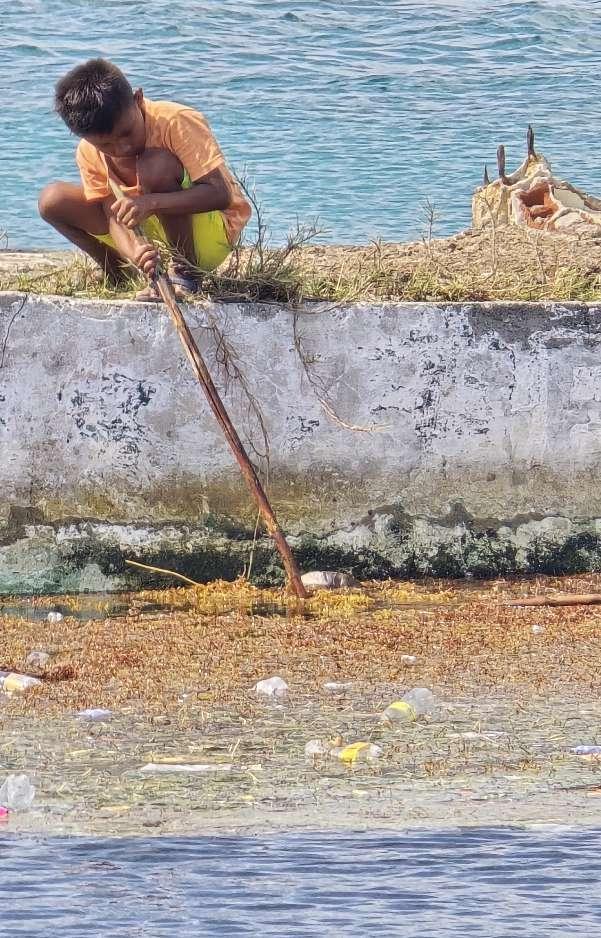


The small islands of San Blas are highly vulnerable. Therefore, we advocate for actions that prioritize equity, climate justice, and social justice. The Intergovernmental Negotiating Committee on Plastic Pollution, which includes a treaty involving 175 countries aimed at coordinating global efforts to reduce plastic production and pollution, complements local initiatives like those undertaken by Kaminando in Wichub Wala. Additionally, to foster climate-resilient development, we emphasize the importance of participation from governments, academia, private businesses, and the necessity for fundamental behavioral changes within civil society.
Boaters are urged to sail responsibly by making a conscious effort to reduce plastic and garbage waste. Please keep all waste onboard until it can be disposed of properly. These actions will help protect the marine life and ecosystems that rely on us to keep the waters clean. ◆
Would you like to support the cause? Feel free to leave a donation on:
https://gofund.me/8c611af9



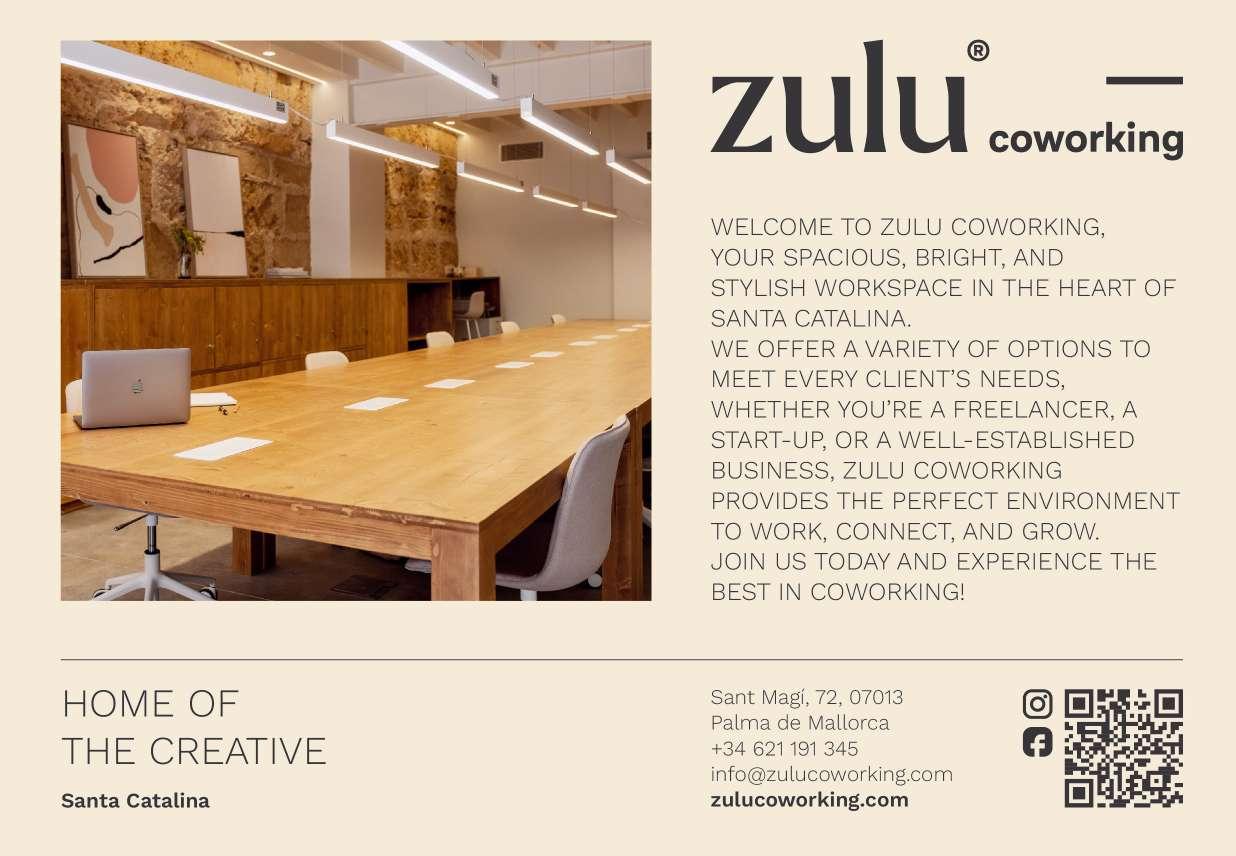
Marina Port Mallorca and STP Shipyard Palma join forces for a study on marine biodiversity.
Written by IPM Group

IPM Group is bolstering its commitment to the conservation of the marine environment through various environmental initiatives aimed at improving and protecting marine ecosystems. On this occasion, the Group recently carried out a groundbreaking action in Palma de Mallorca, both at Marina Port Mallorca and at STP Shipyard Palma.
The project consisted of the installation of submerged tiles at a depth of approximately three metres, fixed to bollards or other static points in the port by ropes.
This simple system acts as an artificial substrate, favouring the fixation of marine organisms and allowing the subsequent analysis of biological colonisation in port settings.
In this study, the main objective is to evaluate the presence and degree of invasion of Branchiomma, a marine worm of tropical origin that has been logged as an invasive species in the Mediterranean.
Due to its numerous reproductive strategies, Branchiomma has a major capacity for dispersion and colonisation in new areas, establishing itself in port settings and other coastal habitats.
Sergi Guasch, a student on the Master's Degree in Marine Ecology at the University of the Balearic Islands, explained
that "the project sets out to evaluate the degree of invasion of this genre at different ports in the Balearic Islands through a simple methodology with minimal impact. To do this, small, submerged tiles are fixed to bollards or other structural points of the port for approximately three months. These structures act as a new substrate, enabling the fixation of Branchiomma and facilitating the analysis of its presence and abundance. It's a totally passive method, which doesn't alter the environment or interfere with port activities. The study seeks to provide key information in order to boost knowledge and management of invasive species in port settings".
As well as Sergi Guasch, the action is benefitting from the collaboration of Ana González, Environmental Technician at the Balearic Island Port Authority, who has been helping with the supervision and development of the initiative.
From a technical point of view, this type of study collects important data on the adaptive capacity of invasive species in new settings, their impact on indigenous biodiversity, and their possible mitigation strategies.
What's more, it provides key information for the implementation of environmental management plans in port areas, helping the authorities and companies make decisions based on scientific evidence.




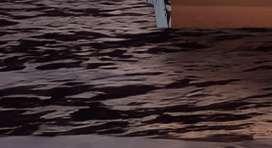



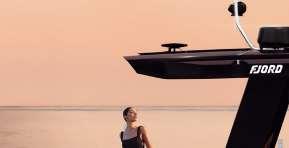



30 April - 3 May 2025 Visit us on Palma International Boat Show and experience the FJORD 490 world premiere!







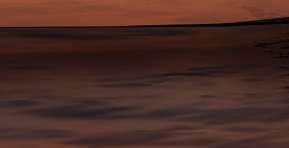
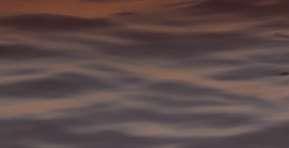





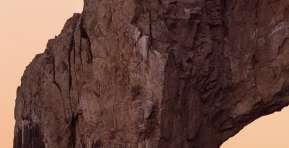









Drive for a moment, remember forever: unique experiences await you on the eye-opening FJORD 490. Under the best-in-class T-Top, you enjoy clinking glasses as never before. With the new side balconies down, you feel like floating above the ocean. Then, 1800 hp push you back into the finest seat cushions. The FJORD 490 open carries you away with inboards, the FJORD 490 sport with outboards.










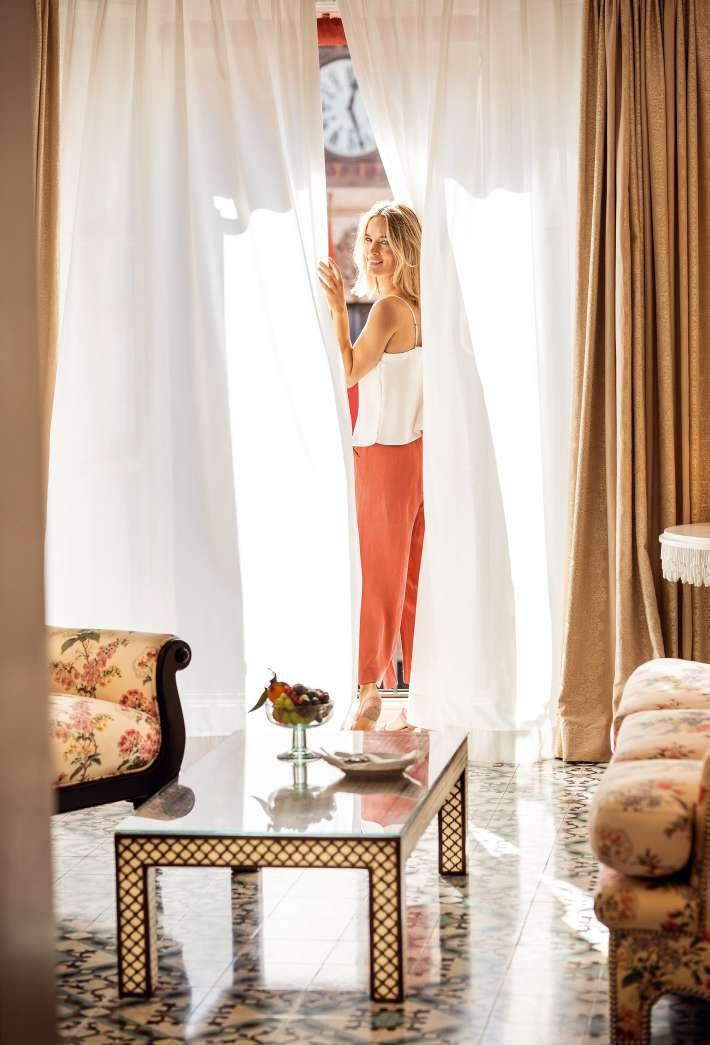



Written by Save the MED

Have you ever wondered how marine biologists study life in the open sea? Their work relies on advanced technology, innovative methods, and teamwork to understand and protect marine ecosystems. It also takes tremendous commitment and dedication to uncover the secrets of the deep blue and fight for its survival—advocating for the regeneration of ecosystems and biodiversity to restore the conditions necessary to sustain life in the sea. Plagued by overfishing, dense plastic pollution, and rising sea temperatures—just a few of the threats facing the Mediterranean—there is much work to be done, and urgently so.
Needless to say, these efforts face significant challenges. The tools and resources required for marine research are not only highly specialised but also expensive, and access to vessels is limited. This restricts researchers and conservation organisations alike in their ability to conduct fieldwork, collect data, and monitor marine ecosystems effectively.
The community vessel
In the Balearic Islands, local NGOs and researchers work tirelessly to address marine conservation issues, but financial and logistical constraints often hinder their efforts. Access to the sea isn’t just vital for scientists—it’s essential for educators too. Hands-on experiences like field trips and marine studies play a key role in raising awareness and inspiring the next generation of marine advocates and conservationists. Without access to boats, students miss out on immersive learning, reducing their connection to marine life.
To bridge this gap, Save the Med is launching the Community Vessel, a floating platform for scientific research and education. Supported by the Bonnie Lass, this expertly repurposed vintage fishing boat has been facilitating marine projects for over a decade. From microplastic analysis and biodiversity studies to sea turtle releases and citizen science campaigns, the vessel has fostered collaboration and engagement in marine regeneration efforts. The Bonnie Lass has been the go-to vessel for key Save the Med activities and collaborations, such as the Changemakers Project and shark conservation initiatives in partnership with NGOs like Palma Aquarium Foundation and Shark Med.
The Bonnie Lass boasts an ample deck space and large shaded table area which is ideal for both research and learning activities onboard. The vessel's fuel-efficient engine, ample water storage, fully equipped galley with kitchen and shower room, and 12 berths below deck allow for extended autonomous operations, making it well-suited for longer sea expeditions. Its elevated bow and crow's nest provide an ideal vantage point for observing marine life and monitoring marine reserves.
This year, the Bonnie Lass will once again transform into a floating classroom and lab, hosting impactful collaborative projects among local organisations, institutions, and experts that will include — but are not limited to — manta tagging, marine wildlife monitoring, and public outreach programs along Mallorca’s Tramuntana coastline.
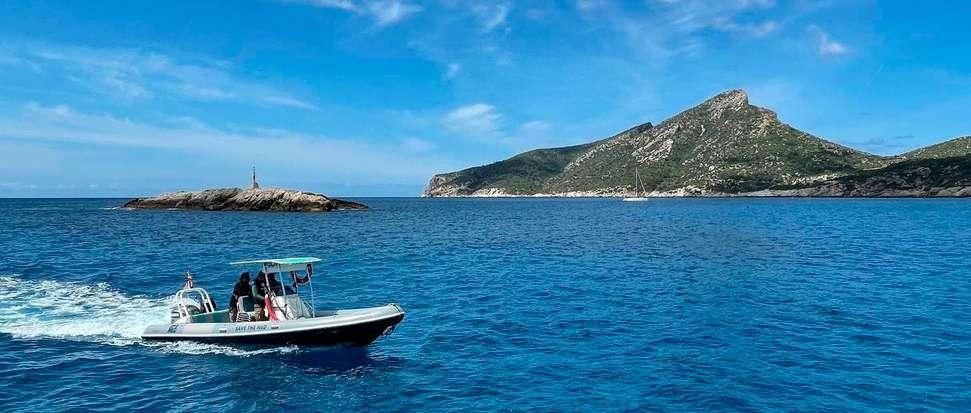
We present to you our wishlist to turn our dreams into reality this year.
Save the Med enters 2025 with an even stronger commitment and a bold vision for the sea and all life that depends on it.
Your in-kind donation of items (including pre-loved ones) helps us continue our mission to regenerate a thriving Mediterranean basin, ensuring a healthier future for marine ecosystems and coastal communities alike.
Have questions or want to donate an item? We'd love to hear from you! Reach out to us at info@savethemed.org and help us make a difference!

Thank you!
The Save the Med team

Navigation
Berths (Mallorca)
Depth Transducer
Radar (Furuno/Raymarine)
Rope handling winch (24V)
Small pot hauler (24V)
Inverter (2KW+)
Search light (24V)
2 VHF hand-held radios
Wet weather gear
Inflatable life jackets
Mooring lines (small diameter)
Personal Locator Beacons
Emergency Position Indicating
Radio Beacons (EPIRB)
Research
Microscope
Use of light aircrafts
Use of helicopter
Use of submarine
Diving compressor
2 Kayaks
2 SUP (inflatable)
SCUBA tanks (12/15L)
RIB with engine + trailer
Dive computer(s)
Scuba regulator(s)
Underwater scooters
3 vehicles (small vans)
Storage space for 20 ft container
Storage space for 7 5 RIB + trailer
Office space/desk in Andratx
Set of powertools (battery-powered)
Coleman + speakers

“We’ve been supporting small conservation and educational projects through the Community Vessel every year,” says Peter Lucas, captain of the Bonnie Lass. “Whenever we could afford it or secure funding, we’ve worked on incredible initiatives in Pollença and Andratx. The involvement of the community and Save the Med’s team has been nothing short of inspiring.”
Beyond research, the Community Vessel fosters a deeper connection between people and the sea. By involving scientists, educators, and the public in regeneration efforts, the project instills a sense of ownership and responsibility for the Balearic marine ecosystem.
"Having a shared vessel brings everyone together—scientists, educators, and locals alike," Lucas adds. "It inspires and equips them to protect the Balearic waters and coastline."
Supporting the mission
The success of the Community Vessel depends on the support of individuals, organisations, and donors who share a vision for a healthier Mediterranean. Contributions, whether financial or in-kind as listed in our 2025 Wishlist,
help ensure that the Bonnie Lass can continue to serve as a platform for education, science, and conservation.
“In-kind donations are incredibly valuable,” notes Brad Robertson, Save the Med’s President. “Even pre-loved items can make a huge difference in keeping the vessel operational and expanding our impact.”
From the depths of the Balearic Sea to the shores of Mallorca, projects like these are a testament to what can be achieved when people come together with a shared purpose. The Community Vessel exemplifies how collaboration, innovation, and grassroots involvement can overcome barriers to conservation efforts and foster communitydriven marine stewardship.
As the Community Vessel takes to the sea again, it carries the hopes of all who care about our seas. By working together, we can ensure a healthy, vibrant Mediterranean for generations to come. ◆

FROM THE DESIGNER OF THE DRAGON CLASS, IDUNA IS A F ULLY RESTORED WOODEN CLASSIC LYING IN THE NETHERLANDS.
SHE IS A SPECTACULAR DAYSAILER THAT TURNS HEADS WHE REVER SHE GOES AND WOULD BE A FANTASTIC CONTENDER IN THE CLASSIC R EGATTA CIRCUIT.
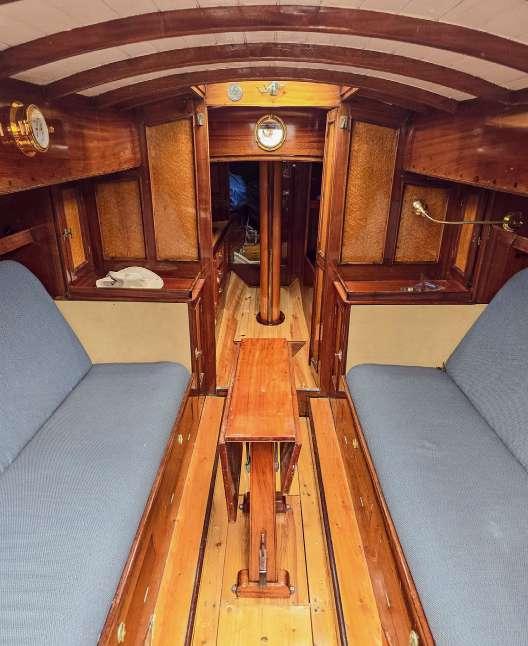
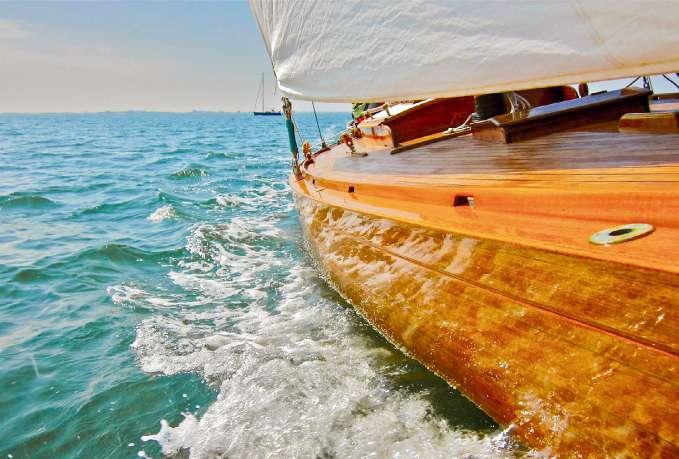

The 2025 JoyRon Michelin Star Gala Dinner at Finca Son Mir - Has very much been at the forefront of our focus during the month of March, at this point in time late March and preparing this article, we look as though the event will be close to a sell out, As we have sold 200 tickets. OUR GALA DINNER commences with a Cava Reception with delicious hors d'oeuvres, followed by a Gourmet Cuisine Three Course Dinner of "Marc Fosh", plus entertainment throughout the evening until 01.30. with all funds raised 100% for the benefit of the Children in Need in the Baleares.
So if you have missed our 2025 Gala Dinner, why not register a general interest to be invited to our 2026 JoyRon Michelin Star Gala Dinner Gala Dinner, which will be held on Saturday 18th April 2026. Just register your interest with Ronald see contact details below.
JoyRon Foundation supports a Basic Nautical Training Program developed by Fundacion Cleanwave Education Division.
This Basic Nautical Training Program provides for 16 young people at risk of social exclusion, an opportunity for their personal and professional development, through comprehensive nautical basic training, which will allow them to effectively integrate into the labour market and improve their social situation. Such training incorporates – Vessel operation and maintenance, Port and Marina Management, Maritime Logistics and Navigation, plus open water safety and rescue. The course consists of 10 sessions each of 8 hours on board a boat with qualified instruction in both practical and theoretical aspects covered.
JoyRon Foundation has entered into a collaboration agreement with Fundacion Cleanwave (Education Department) for the first of these Basic Nautical Training Programs and has thereby fully funded the total cost of this
first ten session course. Selection and recruitment of the first 16 underprivileged 16-18 year olds has taken place during January/February with the first of ten training session undertaken on Saturday 29th March. The remaining nine eight hour training sessions are scheduled one per month during 2025. At the end of the program, there will be a final certificated evaluation test to measure the level of competence that each participant has achieved, and thereby determine their eligibility to continue to more advanced training, which would thereby obviously enhance their opportunities for job placement in the nautical business arena.
It is JoyRon Foundation’s intention to continue this collaboration with Fundacion Cleanwave for future similar Nautical Training Programs. For initial additional information about this program, please contact Ronald as per contact details below. ◆
JoyRon is there to help the many children in need in the Baleares who are under privileged, in need and require support. Interested in event sponsorship?
Financial Corporate or Individual Donations? or Provide an Auction Item or Raffle Prize?
New Volunteers to support us are also always Welcome.
Please contact us.
Together we can make it happen.
Send an e-mail to info@joyronfoundation.org or call Ronald at +34 608-531-211 Website www.joyronfoundation.org

Written by The Islander Pictures by Seippel & Seippel

The Islander Magazine took the opportunity to sit down with Phillip Seippel who very quickly reveals that his true passion lies in sailing. This May, it’s been 44 years since he crossed the Atlantic on his Baltic 46 ‘Infinity’ from Ft Lauderdale, via Bermuda and The Azores to Mallorca.
Like many of our readers, he made the deliberate choice to base himself in Mallorca. That was nearly 60 years ago. We speak with the successful insurance businessman and avid sailor to see through his eyes how the island has developed since then.
The Islander:
Phillip, these days, many people move to Mallorca for obvious reasons. What was your motivation back then and what was it like here? Was it the Atlantic crossing that brought you here?
Seippel: Not quite. Though I did sail here from Florida in 1981, I first came to Mallorca from the USA via England, as a student in 1968, then settling in Puerto de Andratx. I do not use the word paradise lightly , but Mallorca in those days was as magical of a place you could ever imagine. Puerto de Andratx had two restaurants, a couple of seaside cafes, no yacht club and few houses. The few sailing yachts based there, were on swinging moorings in the inner harbour. There were a couple of Colmados (small grocery stores for supplies), and contraband tobacco was purchased behind the counter at the bakers. The Peseta was the legal tender of the land. “Poste Restante” was the mail delivery address and mail was collected at the local café. It was impossible to spend over 500 pesetas in a day. If you went out for the evening with a 500 Peseta note and didn’t return with 300 you probably lost some along the way! The local menu cost 27 Pesetas, including wine. Water was extra. There was one central telephone station, and you booked international calls 48 hours in advance, which did not really matter as the other party could not hear you anyway, no matter how loud you would shout!
The Islander: We know you have joined many a regatta here participating at pretty much all levels. What was early racing here in Mallorca like?
Seippel: There was really very little racing in Puerto then. Most of it was in Palma. That said, we did campaign a 420 racing dinghy locally which essentially got me hooked into the racing world. After that we either raced out of Palma and occasionally Barcelona, sailing Puma 34’s, Chance 36. S&S 44’s and the Baltic. These were all cruising yachts. Other than dinghies, all racers were cruisers. Early fleets were manned by enthusiastic amateurs or -more or less willing- family members who shared a love for the sea and the comradery of a regatta.
The Islander: What were some of the biggest changes you witnessed over these years ?
Seippel: Well, over 50 years!! A Lot! The changes have been huge and never ending for club racing. I think it can all be summed up in the never-ending advance of knowledge and technology along with ever-larger investments to compete at the highest levels.
The really big change started with sail development, followed closely by hull designs. The development of one design racing, One Tonners, Quarter tonners, etc started the world of dedicated racing. The fleets had fewer and fewer cruiser racers and more racer cruisers or one design racers. Then came the electronics, computers, GPS, optimal rating speeds, VMGs etc. Racing and all that came with it was not only a lifetime passion but also, for many, a lifetime profession.
The Islander: So, whereas cruisers used to race each other, you mentioned how cruising and racing have become 2 distinct types of sailing. In your observation, what are the biggest changes in cruising in Balearic waters over these years?
Seippel: Yachts, more yachts and then even more yachts. In the very late 60’s, aside from Real Club Náutico de Palma, there were no real marinas or clubs in Mallorca. Now there are some 33 marinas and clubs in Mallorca. And of course also in Menorca and Ibiza. The advent of mass production of motor yachts of all sizes has brought access to the sea for many. Along with all of this, came new businesses, employment, and a plethora of experts, some real, some not. Not all cowboys were in the wild west. That said, the nautical industry of Mallorca today has become renowned for standard of excellence.
To point, reading your magazine and noting the many highly professional firms advertising just proves my point. Mallorca is now the number one yacht center, bar none.
The Islander: And the downside to all this growth?
Seippel: I am a positive and always optimistic person. Of course, with all the numbers has come an excess of some regulations, zoning, controlled anchorages, and excessive bureaucracy. I could have never imagined that one day it would be necessary to reserve a buoy in some tranquil cala weeks ahead. Getting a marina mooring is tantamount to impossible for many. Fortunately, the charter fleets have increasingly grown to offset this problem. Of course, I miss the paradise of yesteryear, but again, the joy and sheer fun of the nautical community continues to bring the marvelous world of boats and yachts to many. And what has not changed, As the Water Rat said to the Mole: “Believe me, my young friend, there is nothing–absolutely nothing–half so much worth doing as simply messing about in boats.” (Wind in the Willows, 1908)

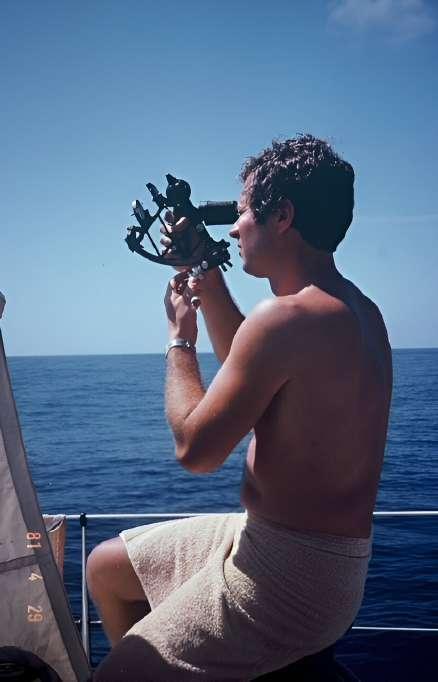
Phillip Seippel is founder of the Seippel & Seippel, International Insurance Brokerage, today managed with his daughter Jasmine Seippel. Seippel and Seippel are based in Santa Ponsa, Pto Andratx and Santanyi. With 20 dedicated insurance professionals, insuring all that should be insured, including the evergrowing marine industry. ◆
www.seippel.com
Written and photo credits by
Marlot Cathalina
What’s better than hiking in Mallorca? Hiking in Mallorca while enjoying a sea view, of course. Islander reporter Marlot Cathalina is here to remind you that spring is the perfect time to explore Mallorca’s east coast, before the summer heat takes over.
Hidden coves, sunlight dancing on the water, a refreshing dip… there’s something about coastal hikes that we simply love. Here are our top picks for the most stunning beaches along the east coast. We promise, they are worth every step.
1.Cala Brafi (Portocolom)
• Beach: Small patch of sand, mixed with rocks
• Parking: Carrer del Mascarell
• Duration: About 15 minutes to Cala Brafi, plus an extra 30 minutes to Cala Estreta

Cala Brafi is a charming little bay that feels like a movie set. Just a few kilometers from Portocolom, this cove has a small sandy beach, an abandoned fisherman’s hut, and crystalclear waters. It’s not entirely undiscovered, but it remains pleasantly free from the crowds, even in high season. Continue hiking along the coast to Cala Estreta, another unquestionably cute and even more remote bay, in less than half an hour. Make sure to wear proper shoes on the sharp rocks.
2.Cala Varques (Cala Romántica)
• Beach: Sand
• Parking: Cala Romántica
• Duration: About 1.5 hours from Cala Romántica (one way)

Cala Varques is a hidden paradise between Porto Cristo and Portocolom. The intermediate hike from Cala Romántica is well worth the effort, offering stunning views of the turquoise sea along the cliffs. One of the highlights along the way is the epic natural rock bridge ‘Cova des Pont’, a must-see for all Islanders! You can park along the Ma-4015 for a shortcut to Cala Varques, but you might not want to miss the untouched nature on one of the best coastal trails on Mallorca.
3.S'Amarador (Mondragó)
• Beach: Sand
• Parking: Parking Mondragó
• Duration: About 15 minutes (or more!)

A relaxing stroll through Mondragó Natural Park will lead you to the picturesque S'Amarador beach with fine sand, surrounded by pine forests. While it can get crowded in high season, the nature reserve offers several short walking trails with incredible sea views. Ideal if you’re not much of a hiker or have young kids, but still want to experience some natural beauty.
4.Cala Marmols (Ses Salines)
• Beach: Sand
• Parking: Cap de ses Salines
• Duration: About 1.5 hours (one way)

Cala Marmols is a remote, postcard-perfect bay that can only be reached on foot or by boat. From Cap de ses Salines, you’ll hike along the coastline for over an hour to arrive at this dreamy spot, surrounded by dramatic cliffs. Hello paradise! While boats often anchor here in summer, the beach itself usually remains tranquil. Just keep in mind that there’s no shade along the trail, so bring plenty of water and sun protection.

5.Cala Bota (Cales de Mallorca)
• Beach: Rocky
• Parking: Parking de Cala Bota
• Walking distance: About 20 minutes to Cala Bota and longer when visiting the other bays (recommended!)
Talking about secluded calas! Cala Bota is one of the most remote beaches along Mallorca’s east coast, perfect for those seeking an off-the-beaten-path adventure. Many hikers enjoy exploring the neighboring coves like Cala Virgili, Cala Pilota, and Cala Magraner. You might even spot some friendly goats on one of the beaches. Happy hiking! ◆
Written by Dr. Drew Richardson, PADI President & CEO

Sleep contributes to healthy brain ecology and is actually part of learning anything. It is even part of reducing your risk while diving – or while doing almost anything else. The cliché says, “You snooze you lose,” but science says sleep is a winning strategy.
Sleep, learning and memory
Sleep is like many other aspects of instruction, such as repetition, in that we know that it benefits learning and recall, but we really don’t know why it does so.
But, there are quite a few theories and hypotheses. Broadly, cognitive psychologists sometimes tie sleep to “ACR” in memory modeling: Acquisition (when you’re exposed to what you’re learning), Consolidation (when your brain processes new information into memory so you can recall it later) and Retrieval (remembering and using what you learned).
We acquire and retrieve while we’re awake, but consolidation happens largely (or maybe entirely) while we sleep. Furthermore, it appears our brains can only “hold” so much without consolidation, after which we start forgetting things before they store in our long-term memory.
Many studies, like this one, find a substantial correlation between sleep and learning, and some like the one cited
here found that a shorter interval between learning and sleep improves memory retrieval (but that’s no excuse to fall asleep during a PADI Specialty Diver course – not that you’re likely to!).
Another recent study shows that beyond learning facts and concepts, sleep is even important for learning motor skills. In other words, sleep not only helps PADI Divemaster candidates remember Boyle’s Law, but it helped you as a PADI Open Water Diver student learning skills like sharing air with your alternate air source and hovering neutrally buoyant.
Sleep,
You’ve probably experienced this: It’s at the end of the day, you’re tired and you’re faced with a big decision that seems overwhelming, but there’s some time. “Let me sleep on it,” you say and go to bed. When you get up, somehow the situation isn’t so dire, and you not only know exactly what to do, but it’s obvious.
What happened? You’re less tired for sure, but actually you were working on the problem while you slept. As reported here, many anecdotes, and now formal studies, find that sleep enhances our creativity and problem solving by processing while we sleep.



A diving example of this, Dr. Raymond Rogers, who developed the Recreational Dive Planner, said that he fell asleep while trying to figure out how to make a dive table that could be used like a slide rule. When he woke up he had the answer – the famed Wheel version of the RDP. (Note: All this happened in the late 1980s before dive computers were prevalent. The Wheel was discontinued in 2008 as dive computers became standard equipment).
Looking at the other side of the coin, studies like this one find that a lack of sleep impairs us by impeding judgment and good decisions, and by increasing impulsive behaviours. You wouldn’t go diving or drive a car while drunk, right? A 1997 Australian study found that 17 hours without sleep decreased mental function the same as having a .05% blood alcohol level – perhaps not legally drunk with respect to driving in most US states, but unquestionably enough to impair your skills. ◆
Make sleep part of being a good diver
Get adequate sleep to enhance learning. You want to hang out with your classmates bit later? No worries –take naps after class before the get-together, then sleep in the next day if you ended up being out a bit late.
Get adequate sleep before diving. Whether it’s a Dive Against Debris® dive with fellow Ocean Torchbearers or a “big” dive with Tec 100 CCR teammates, sleep 8+ hours the night before so you’re not only rested, but so you think clearly and make good judgments – both part of safe diving.
Couldn’t sleep? Stayed up too late? I get it – I go on holiday, too, and evenings socializing with friends are part of it. Skip the morning dive and sleep. Catch the afternoon boat fresh and ready to go. Went to bed but couldn’t sleep for some reason? Reschedule. Waiting until you’ve slept not only benefits your safety and wellbeing, but you’ll probably have more fun.
In his book, Why We Sleep, British neuroscience and psychology professor Matthew Walker, Ph.D. says, “Sleep is the greatest legal performance-enhancing drug that most people are probably neglecting.” We can all be better divers simply by not making that mistake.

Written by The Islander

The Marina Industries Association (MIA) has announced Ocean Marina Jomtien in the Gulf of Thailand is Thailand’s first “Platinum 5 Gold Anchor Marina”. This global accreditation is the highest accolade awarded in the industry and is reserved for marinas that offer their customers a comprehensive and unique marina experience by providing unparalleled boating facilities, tailored and personalised service, and an outstanding array of high-quality amenities, reported MIA.
With over 450 modern berths, providing safe anchorage for yachts up to 75m, full vessel maintenance facilities supported by a broad range of onsite marine trades and service providers and premium leisure facilities, Ocean Marina Jomtien is Southeast Asia’s largest marina and the gateway to yachting in the Gulf of Thailand.
MIA President Andrew Chapman CMM has visited the marina a number of times and wasn’t surprised by the assessment outcome, explaining, “In addition to its berthing and maintenance services, this impressive marina complex incorporates a full-service resort including a 76-room hotel, an array of food and beverage options and high-quality leisure facilities including indoor and outdoor swimming pools, a gymnasium, steam rooms and saunas. Business needs can even be taken care of on the go, with access to a full range of business services, including meeting spaces.”
An independent survey of the marina’s berth holders is part of the Gold Anchor assessment, and the marina scored an impressive 97%.
The Platinum 5 Gold Anchor accreditation will be formally presented at the 2025 Nautilus Marine Insurance Marina of
the Year Awards on 6 May in Sydney. Ocean Marina Jomtien was also recognised for its environmental commitment with an International Clean Marina accreditation and has taken the Marine Sustainability Pledge. As a favoured superyacht berthing destination, the marina has also been accredited as a Superyacht Ready Marina, one of only four accredited in Asia.
“It’s great to see another marina being recognized in Thailand. The prestigious 5 Gold Anchor platinum honor shows that the marine industry is moving in the right direction in Thailand. Asia is growing with the number of visiting yachts and more yachts are basing themselves here on a permanent basis as more quality facilities are being established to cater for the expanding market”, comments Gordon Fernandes, co-founder of Asia Pacific Superyachts and based in Phuket, Thailand for the past 23 years.
With over 500 wet-berths and 200 dry-berths available, Ocean Marina Yacht Club is not only the largest marina in Thailand but the biggest in the whole of SouthEast Asia, providing safe anchorage for yachts up to 75m. Note: the marina has close proximity to Bangkok International Airport.
Home to hundreds of yachts all-year-round that are safely moored and protected in a giant, U-shaped wave breaker, Ocean Marina at Pattaya provides full, international standard facilities and services to visiting yachts and is the only marina located on the Gulf of Thailand’s east coast. Established in 1989, the largest marina resort complex in Thailand has built a reputation as one of Asia’s premier marinas and yacht clubs and is equipped with outstanding facilities and a team of talented professionals. A wide range of marine service suppliers are onsite, ensuring that all of our guests and boat owners can kick back, relax and embrace the nautical lifestyle at one of Asia’s premier destinations.
Overlooking the Gulf of Thailand, the international standard marina is equipped with outstanding facilities, a team of talented professionals plus a wide range of marine service suppliers onsite, ensuring that all of our guests and boat owners can kick back, relax and embrace the nautical lifestyle at one of Asia’s premier destinations.
“The Gulf of Thailand is an all-year-round destination for superyachts visiting Asia”, reports Captain Charlie Dwyer, based on Koh Samui, adding: “The exceptional marina facilities provide captains, boat owners and crews with everything they need to ensure a safe, secure and enjoyable stay in the Gulf of Thailand, offering over 380 floating berths that can accommodate all types of boats, from day runabouts
and stately catamarans to superyachts of up to 75m, as well as over 200 dry-berths.”
The marina enjoys a vibrant, inclusive environment where visitors are offered a wide range of nautical lifestyle opportunities and leisure activities. Within the complex there is a 51-room boutique hotel, restaurant, meetings and seminar facilities and a sports complex. The all-inclusive marina is a second home for the region’s yachting community and a go-to-spot for visiting yachties and affluent visitors. Yachting visitors can enjoy exploring a number of beautiful, largely undeveloped islands just a short distance away. In the North of the island the bays have a gradual run off to the water with white sand and patches of fringing reef, and in the South are impressive limestone cliffs as the land drops off sharply into the water. The waters surrounding the island are exceptionally clear, extending all the way to its neighboring island, Koh Khram Noi, located just a short distance to the north. Note: Koh Khram is an uninhabited island under the ownership of the Navy.
A lovely little uninhibited island, 10NM West of Ocean Marina Jomtien, Koh Rin is an island with one notable beach situated in the Southeast of the island. The beach dramatically changes in width with the tides, creating unique experiences at both high and low tide. Just a few steps into the water at high tide, and you’re swimming among vibrant tropical fish. At low tide, the water recedes, and fish can be seen swimming beneath your feet. To the North and East of the island, are two smaller islands surrounded by coral that are great for a trip on a dinghy to explore.
A Secluded Paradise – and an amazing dive location! This small island boasts three gorgeous sandy coves to discover, two on the east side and a larger one on the west. The crystalclear waters surrounding the island, along with its vibrant coral reefs, make Koh Man Wichai a fantastic spot for snorkeling. Koh Man Wichai is abundant in beautiful coral and tropical fish, making it ideal for snorkeling. Additionally, there are two captivating dive sites – “the wall” with depths ranging from 9 to 25 meters, and “The Fingers,” named after its resemblance to a human hand. The latter is also suitable for snorkelers due to its relatively shallow water and remarkable display of coral.
The area is supported by fantastic weather throughout the year, optimal wind conditions and calm, turquoise waters for those seeking amazing cruising in the Gulf of Thailand. ◆


Impressive Bluegame BGX60 with a long list of extra equipment. A generous two cabin version and available now. Her unique layout with the large beach club aft deck allows private access to a lower saloon leading on to an owner´s cabin that would normally only be found on a 10ft longer yacht. Features like the negativeangled windscreen, the enormous beach club aft or the focus on creating privacy like the upper deck and forward open areas make her stand out from her competitors in the 60 ft range. All services carried out prior to the season. Lithium battery package upgraded 2023. Keen seller. Viewing can be arranged in Mallorca by prior appointment.

(+34) 971 402 911 palma@devalk.nl www.devalk.nl

Van Dam Nordia 70 Performance Cruiser Built: 2009 Material: Aluminum Asking
True to her name, this 70' Nordia Performance Cruiser blends cruising comfort with performance sailing prowess. The compact yet refined deckhouse yacht boasts striking lines and a sleek, contemporary interior, crafted with Van Dam Nordia’s unwavering commitment to Dutch excellence. Built in pedigree aluminum with a full carbon mast & boom, you can expect performance, efficiency, and reliability. A masterpiece in craftsmanship with zero costs spared in her maintenance, this yacht is EU VAT paid and ready for worldwide adventures.
Available for viewing at the Palma International Boat Show 30th April - 3rd May 2025! Book your appointment with us!


(+34) 609 43 33 33 T. (+34) 971 40 44 66
L Y S I U M I
ELYSIUM I IS AN IMMACULATE EXAMPLE OF THE ACCLAIMED DOLCEVITA MODEL FROM THE RENOWNED RIVA SHIPYARD. THIS 110’ (34M) YACHT BOASTS RIVA’S SLEEK DESIGN AND POWERFUL PERFORMANCE.

